© 2016 Pearson Education, Inc., Upper Saddle River, NJ. All rights reserved. This material is protected under all copyright laws as they currently exist. No portion of this material may be reproduced, in any form or by any means, without permission in writing from the publisher. 2–1.
If and , determine the magnitude of the resultant force and its direction, measured counterclockwise from the positive x axis 450 N 60°
SOLUTION
The parallelogram law of addition and the triangular rule are shown in Figs a and b, respectively
Applying the law of consines to Fig. b,
7002 4502 2(700)(450) cos 45°
This yields Th us, the direction of an g le of measured counterclockwi se from the positive a xis,i s

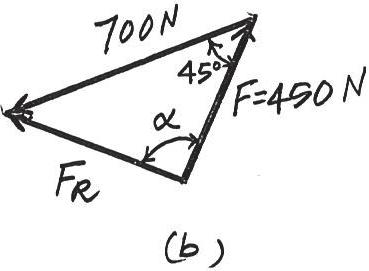
© 2016 Pearson Education, Inc., Upper Saddle River, NJ. All rights reserved. This material is protected under all copyright laws as they currently exist. No portion of this material may be reproduced, in any form or by any means, without permission in writing from the publisher.
2–2.
If the magnitude of the resultant force is to be 500 N, directed along the positive y axis, determine the magnitude of force F and its direction u
SOLUTION
The parallelogram law of addition and the triangular rule are shown in Figs a and b, respectively.
Applying the law of cosines to Fig. b,
F = 2 5002 + 7002 - 2(500)(700) cos 105°
= 959.78 N = 960 N
Applying the law of sines to Fig. b, and using this result, yields
sin (90° + u)
700 = sin 105° 959.78
u = 45.2°
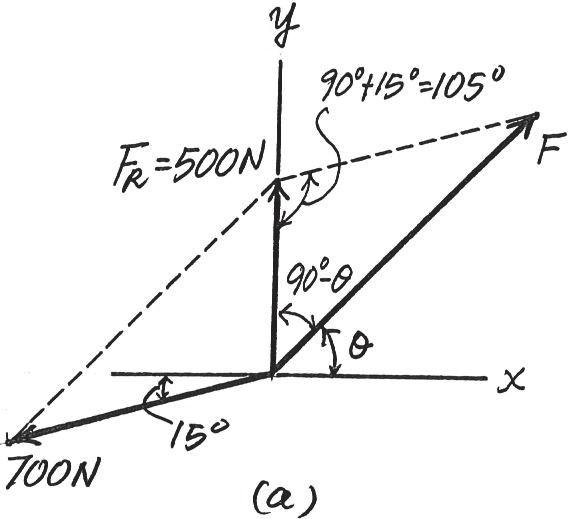
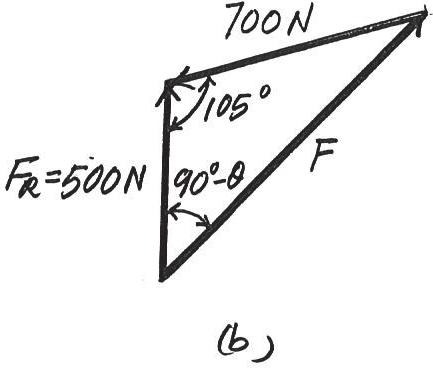
© 2016 Pearson Education, Inc., Upper Saddle River, NJ. All rights reserved. This material is protected under all copyright laws as they currently exist. No portion of this material may be reproduced, in any form or by any means, without permission in writing from the publisher. 2–3.
Determine the magnitude of the resultant force and its direction, measured counterclockwise from the positive x axis
SOLUTION
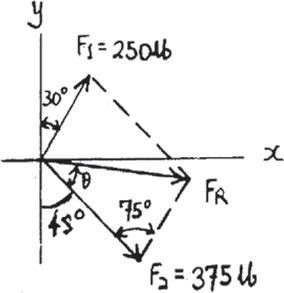
The vertical force acts downward at on the two-membered frame Determine the magnitudes of the two components of directed along the axes of and Set
SOLUTION
Parallelogram Law: The parallelogram law of addition is shown in Fig. a
Trigonometr y: Using the law of sines (Fig. b), we have
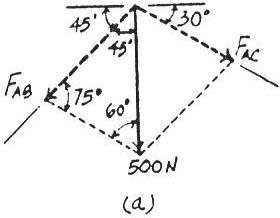
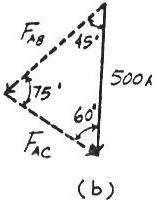
2–5.
Solve Prob 2-4 with F = 350 lb
SOLUTION
Parallelogram Law: The parallelogram law of addition is shown in Fig. a
Trigonometr y: Using the law of sines (Fig. b), we have
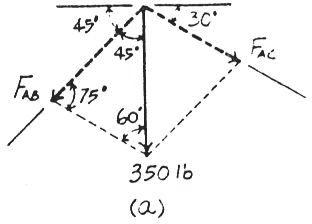
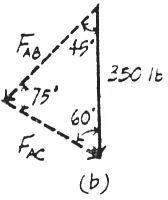
© 2016 Pearson Education, Inc., Upper Saddle River, NJ. All rights reserved. This material is protected under all copyright laws as they currently exist. No portion of this material may be reproduced, in any form or by any means, without permission in writing from the publisher.
2–6.
Determine the magnitude of the resultant force
FR = F1 + F2 and its direction, measured clockwise from the positive u axis.
Solution
Parallelogram Law. The parallelogram law of addition is shown in Fig. a, Trigonometry. Applying Law of cosines by referring to Fig. b,
FR = 242 + 6 2 - 2(4)(6) cos 105° = 8 026 kN = 8 03 kN Ans.
Using this result to apply Law of sines, Fig. b,
sin u 6 = sin 105° 8 026 ; u = 46 22°
Thus, the direction f of FR measured clockwise from the positive u axis is f = 46.22° - 45° = 1.22° Ans.
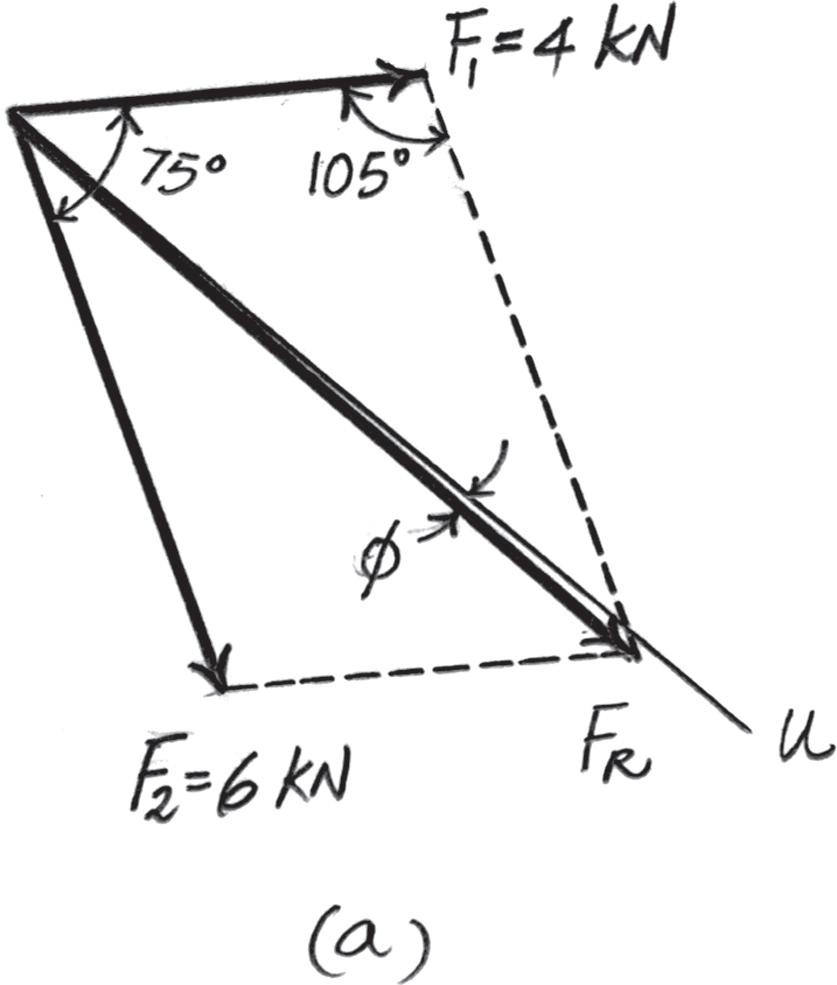
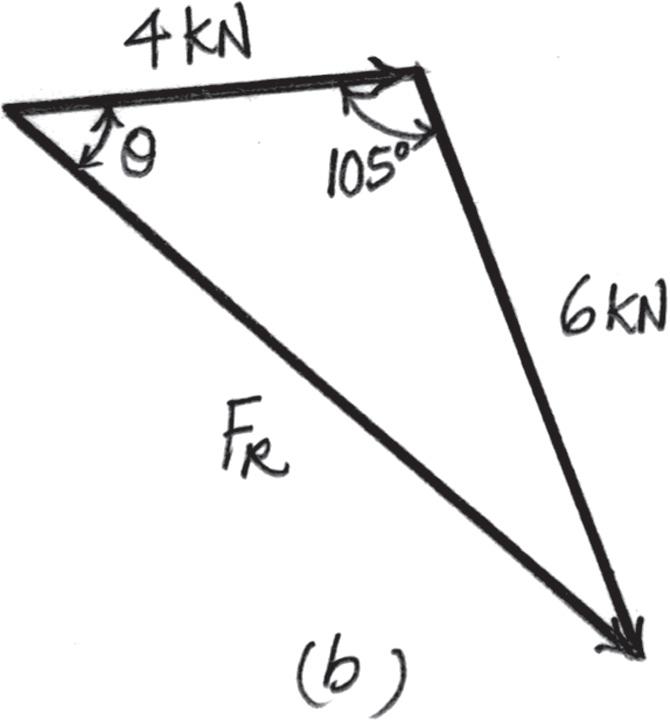
Ans: f = 1.22°
© 2016 Pearson Education, Inc., Upper Saddle River, NJ. All rights reserved. This material is protected under all copyright laws as they currently exist. No portion of this material may be reproduced, in any form or by any means, without permission in writing from the publisher.
2–7.
Resolve the force F1 into components acting along the u and v axes and determine the magnitudes of the components.
Solution
Parallelogram Law. The parallelogram law of addition is shown in Fig. a, Trigonometry. Applying the sines law by referring to Fig. b
(F1)v sin 45° = 4 sin 105° ; (F1)v = 2 928 kN = 2 93 kN
(F1)u sin 30° = 4 sin 105° ; (F1)u = 2 071 kN = 2 07 kN
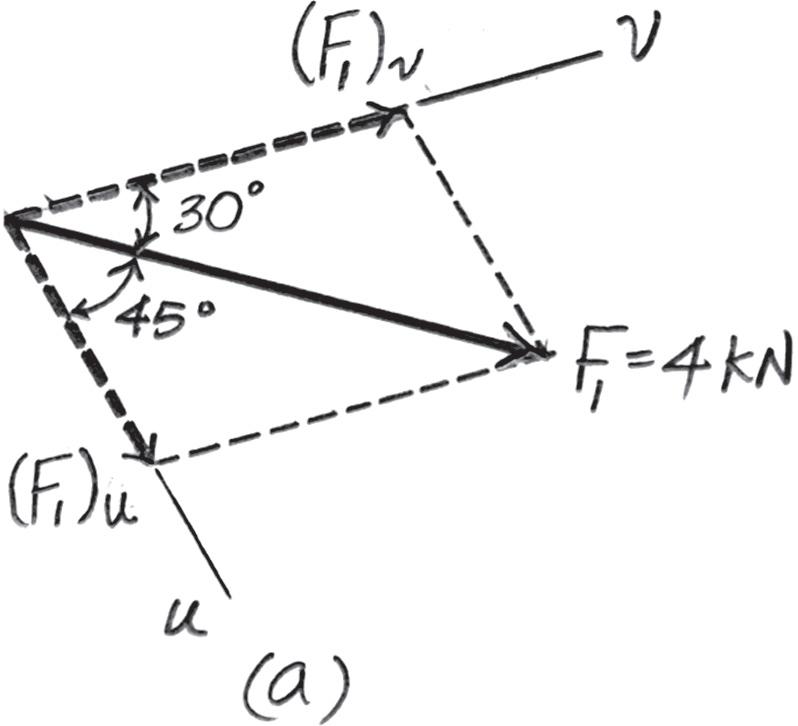
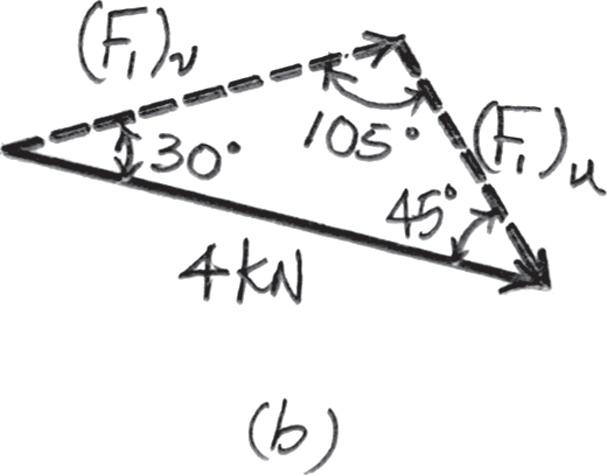
© 2016 Pearson Education, Inc., Upper Saddle River, NJ. All rights reserved. This material is protected under all copyright laws as they currently exist. No portion of this material may be reproduced, in any form or by any means, without permission in writing from the publisher.
*2–8.
Resolve the force F2 into components acting along the u and v axes and determine the magnitudes of the components.
Solution
Parallelogram Law. The parallelogram law of addition is shown in Fig. a, Trigonometry. Applying the sines law of referring to Fig. b,
(F2)u sin 75° = 6 sin 75° ; (F2)u = 6 00 kN
(F2)v sin 30° = 6 sin 75° ; (F2)v = 3 106 kN = 3 11 kN
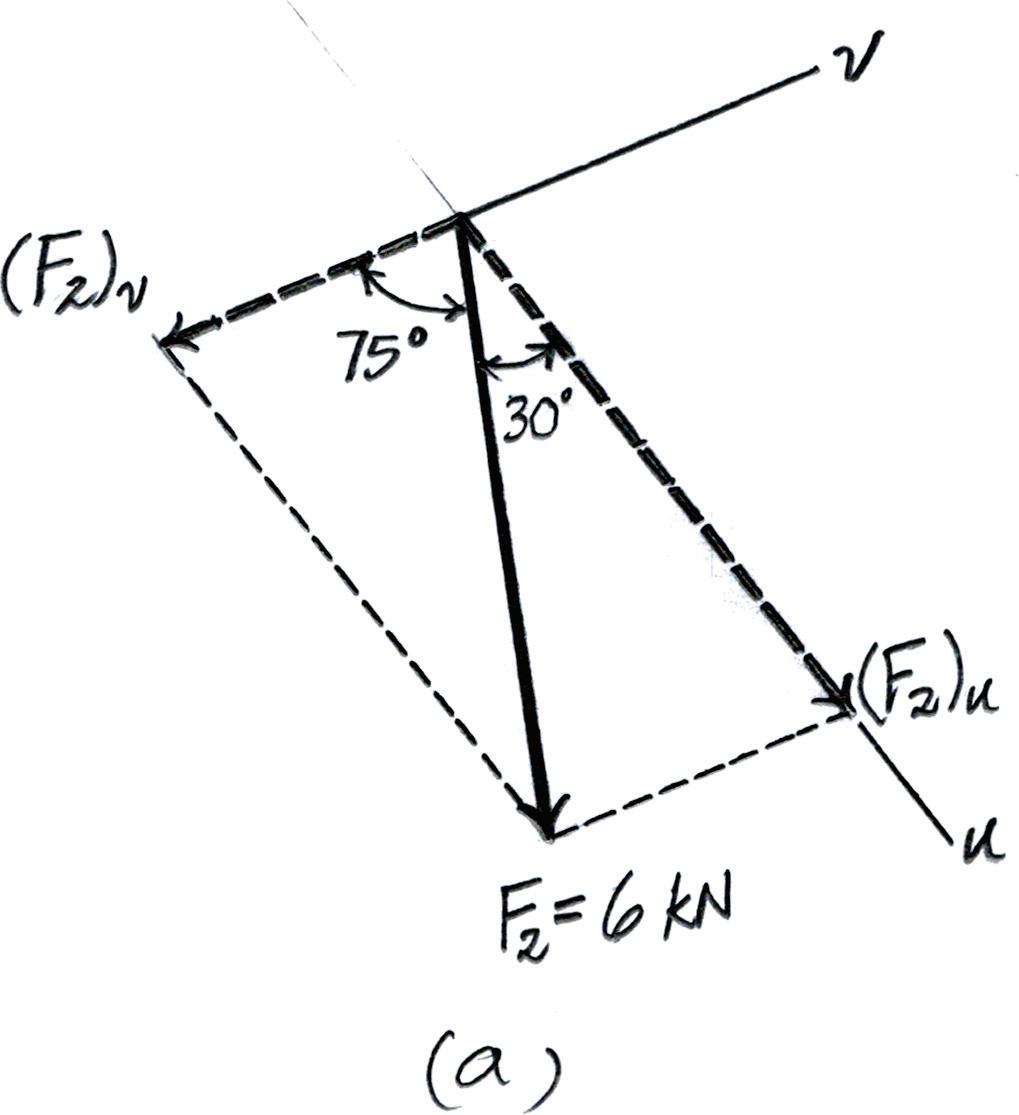

© 2016 Pearson Education, Inc., Upper Saddle River, NJ. All rights reserved. This material is protected under all copyright laws as they currently exist. No portion of this material may be reproduced, in any form or by any means, without permission in writing from the publisher.
2–9.
If the resultant force acting on the support is to be 1200 lb, directed horizontally to the right, determine the force F in rope A and the corresponding angle u .
Solution
Parallelogram Law. The parallelogram law of addition is shown in Fig. a, Trigonometry. Applying the law of cosines by referring to Fig. b, F = 29002 + 12002 - 2(900)(1200) cos 30° = 615 94 lb = 616 lb Ans.
Using this result to apply the sines law, Fig. b, sin u 900 = sin 30° 615 94 ; u = 46 94° = 46 9° Ans.
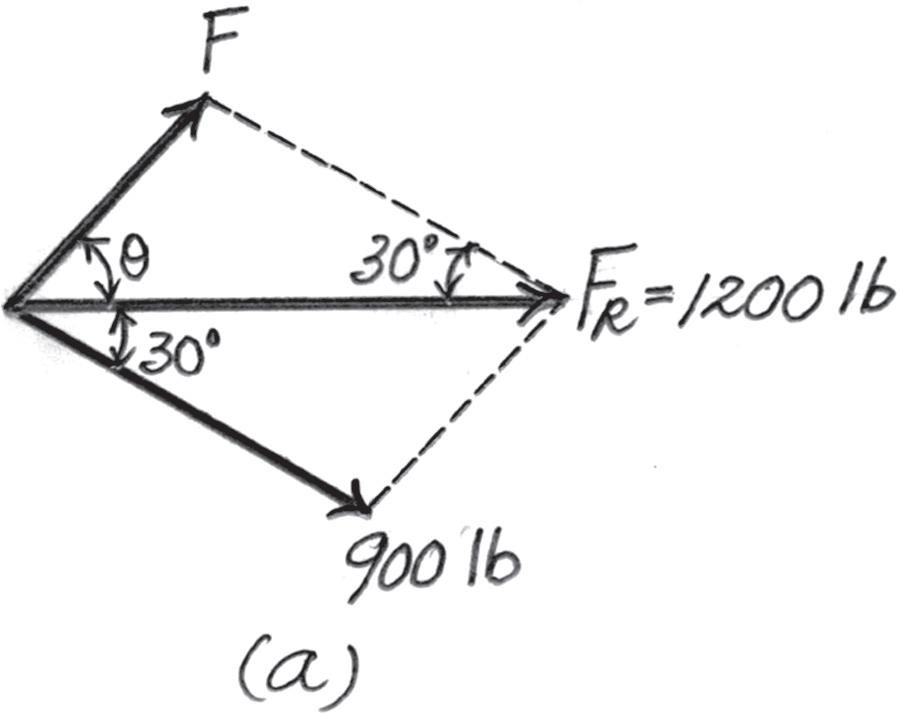
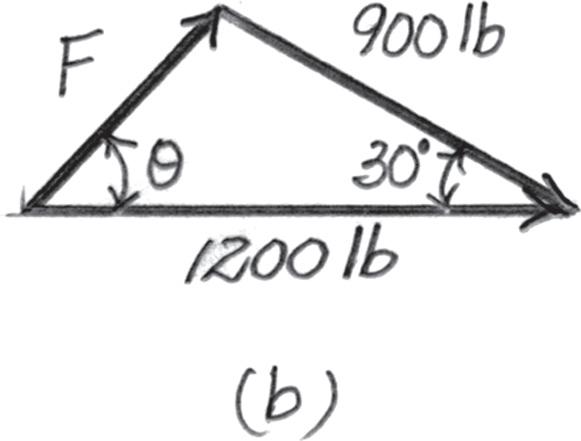
© 2016 Pearson Education, Inc., Upper Saddle River, NJ. All rights reserved. This material is protected under all copyright laws as they currently exist. No portion of this material may be reproduced, in any form or by any means, without permission in writing from the publisher.
2–10.
Determine the magnitude of the resultant force and its direction, measured counterclockwise from the positive x axis.
Solution
Parallelogram Law. The parallelogram law of addition is shown in Fig. a, Trigonometry. Applying the law of cosines by referring to Fig. b,
FR = 28002 + 5002 - 2(800)(500) cos 95° = 979 66 lb = 980 lb Ans.
Using this result to apply the sines law, Fig. b, sin u 500 = sin 95° 979 66 ; u = 30 56°
Thus, the direction f of FR measured counterclockwise from the positive x axis is f = 50° - 30 56° = 19 44° = 19 4° Ans.
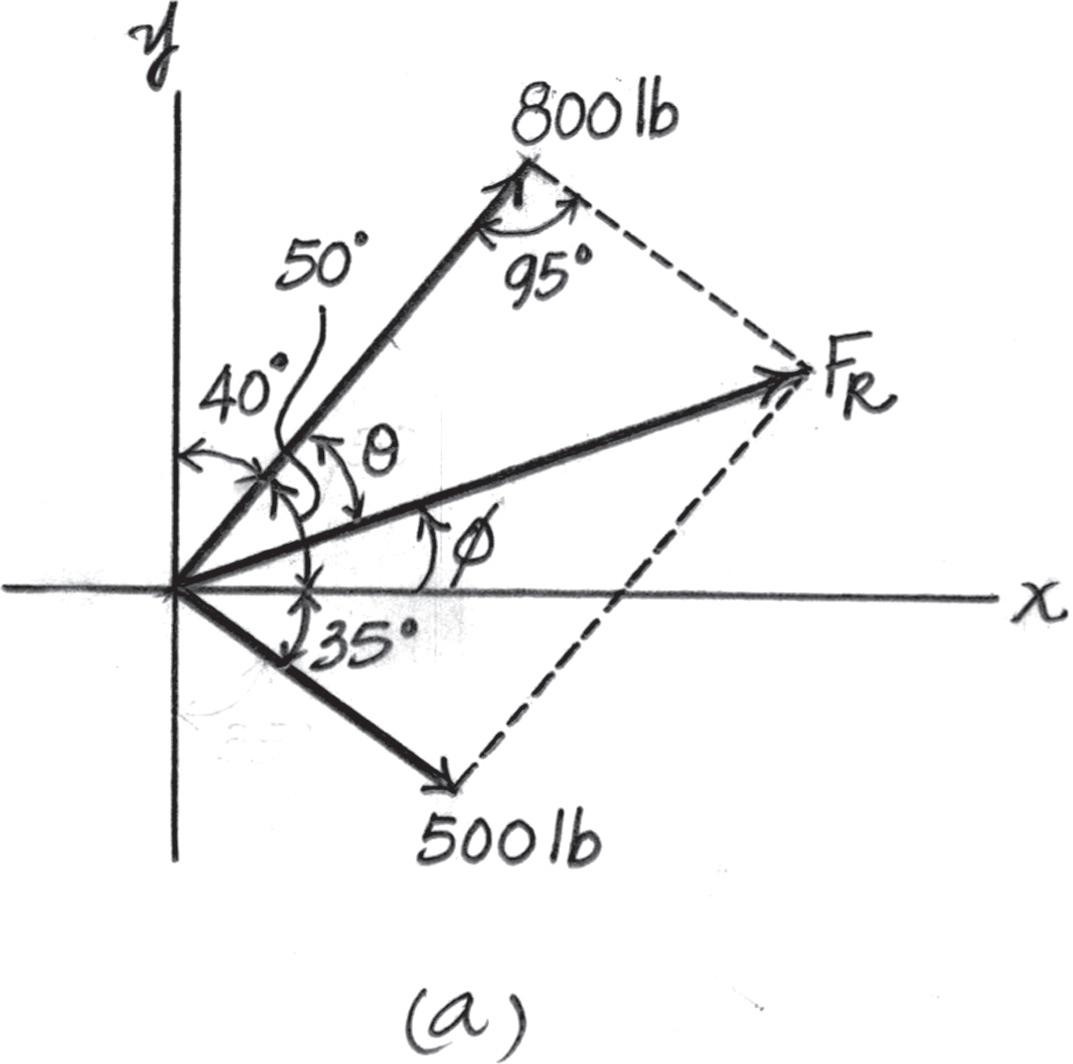
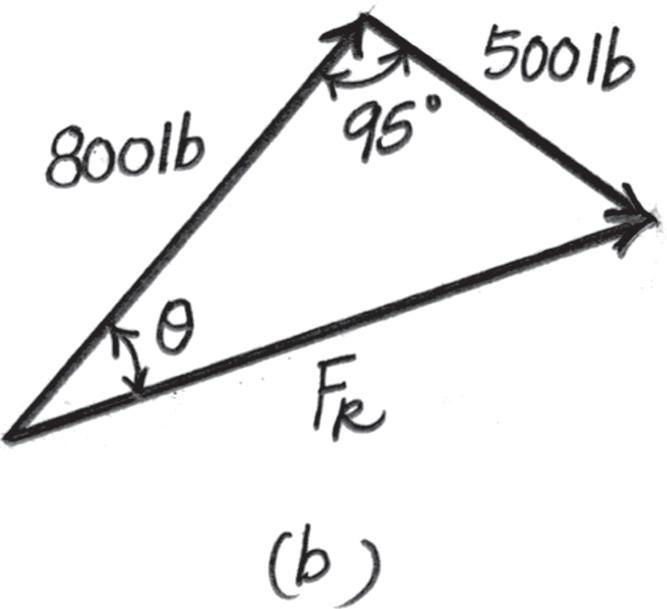
© 2016 Pearson Education, Inc., Upper Saddle River, NJ. All rights reserved. This material is protected under all copyright laws as they currently exist. No portion of this material may be reproduced, in any form or by any means, without permission in writing from the publisher.
2–11.
The plate is subjected to the two forces at A and B as shown. If , determine the magnitude of the resultant of these two forces and its direction measured clockwise from the horizontal. u = 60°
SOLUTION
Parallelogram Law: The parallelogram law of addition is shown in Fig. a
Trigonometr y: Using law of cosines (Fig b), we have
FR = 282 + 62 - 2(8)(6) cos 100°

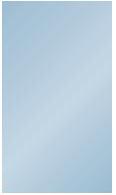
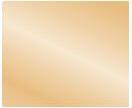



The angle can be determined using law of sines (Fig. b).
u = 33.16° sin u = 0.5470 sin u 6 = sin 100° 10.80 u = 10.80 kN = 10.8 kN
Thus, the direction of FR measured from the x axis is
Ans. f = 33.16° - 30° = 3.16°
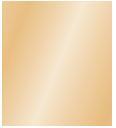
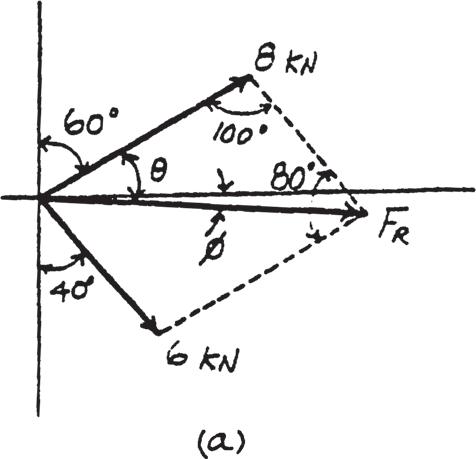
© 2016 Pearson Education, Inc., Upper Saddle River, NJ. All rights reserved. This material is protected under all copyright laws as they currently exist. No portion of this material may be reproduced, in any form or by any means, without permission in writing from the publisher.
*2–12.
Determine the angle of for connecting member A to the plate so that the resultant force of FA and FB is directed horizontally to the right. Also, what is the magnitude of the resultant force? u
SOLUTION
Parallelogram Law: The parallelogram law of addition is shown in Fig. a
Trigonometr y: Using law of sines (Fig b), we have
From the triangle,. Thus, using law of cosines, the magnitude of FR is
10.4 kN

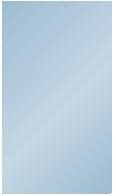
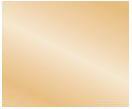



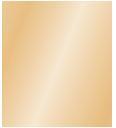
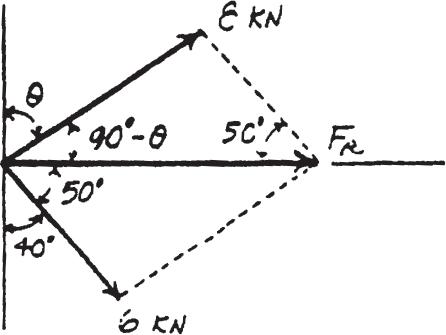
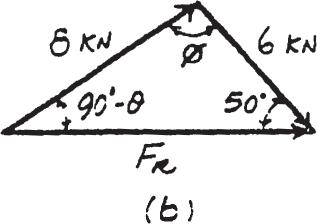
© 2016 Pearson Education, Inc., Upper Saddle River, NJ. All rights reserved. This material is protected under all copyright laws as they currently exist. No portion of this material may be reproduced, in any form or by any means, without permission in writing from the publisher.
2–13.
Theforce acting on the geartoothisResolve this force into two components acting alongthe lines aa and bb
SOLUTION
20 sin 40° = Fa sin 80° ; Fa = 30.6 lb
20 sin 40° = Fb sin 60° ; Fb = 26.9 lb
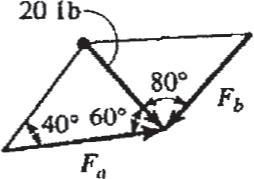
2–14.
The component of force F acting along line aa is required to be 30 lb.Determine the magnitude of F and its component along line bb
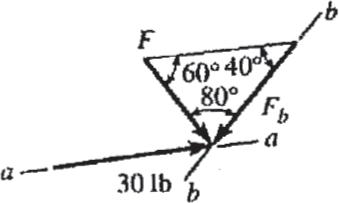
© 2016 Pearson Education, Inc., Upper Saddle River, NJ. All rights reserved. This material is protected under all copyright laws as they currently exist. No portion of this material may be reproduced, in any form or by any means, without permission in writing from the publisher.
2–15.
Force F acts on the frame such that its component acting along member is 650 lb, directed from towards , and the component acting along member is 500 lb, directed from towards Determine the magnitude of F and its direction Set f = 60° u
SOLUTION
The parallelogram law of addition and triangular rule are shown in Figs a and b, respectively
Applying the law of cosines to Fig. b,
F = 25002 + 6502 - 2(500)(650) cos 105°
u 500 = sin 105° 916.91 = 916.91 lb = 917 lb
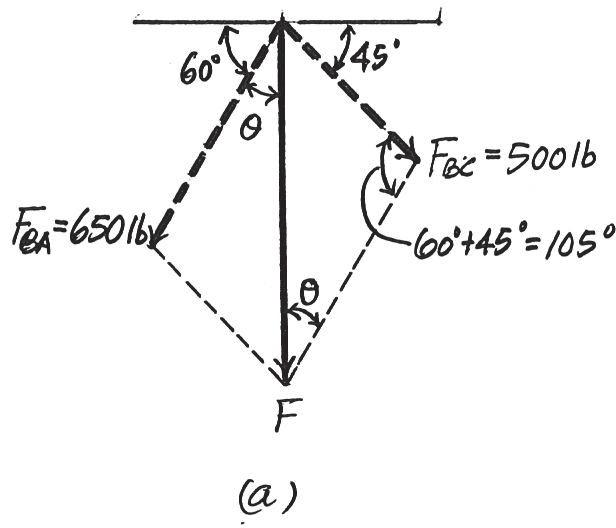
Using this result and applying the law of sines to Fig. b, yields
= 31.8°
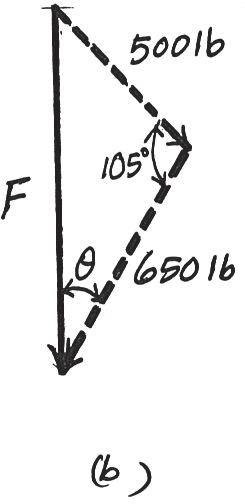
© 2016 Pearson Education, Inc., Upper Saddle River, NJ. All rights reserved. This material is protected under all copyright laws as they currently exist. No portion of this material may be reproduced, in any form or by any means, without permission in writing from the publisher.
*2–16.
Force F acts on the frame such that its component acting along member AB is 650 lb, directed from B towards A Determine the required angle and the component acting along member BC Set and u = 30° F = 850 lb f (0° … f … 45°)
SOLUTION
The parallelogram law of addition and the triangular rule are shown in Figs. a and b, respectively.
Applying the law of cosines to Fig. b,
FBC = 28502 + 6502 - 2(850)(650) cos 30°
Using this result and applying the sine law to Fig. b, yields
Ans. sin (45° + f) 850 = sin 30° 433.64 f = 33.5° = 433.64 lb = 434 lb

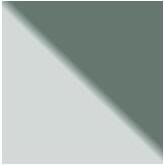
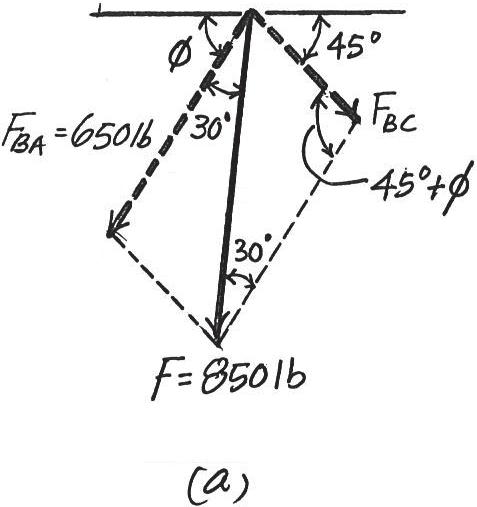
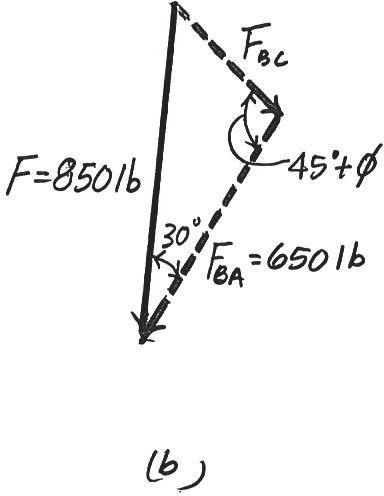
© 2016 Pearson Education, Inc., Upper Saddle River, NJ. All rights reserved. This material is protected under all copyright laws as they currently exist. No portion of this material may be reproduced, in any form or by any means, without permission in writing from the publisher.
2–17.
Determinethe magnitudeand directionofthe resultant of the three forces by first finding the resultant and then forming FR = F ¿+ F3 F ¿= F1 + F2
SOLUTION
F ¿ = 2(20)2 + (30)2 - 2(20)(30) cos 73.13° = 30.85 N
30.85 sin 73.13° = 30 sin (70° - u ¿) ; u ¿ = 1.47°
FR = 2(30.85)2 + (50)2 - 2(30.85)(50) cos 1.47° = 19.18 = 19.2 N
19.18
sin 1.47° = 30.85 sin u ; u = 2.37°
Ans. Ans.
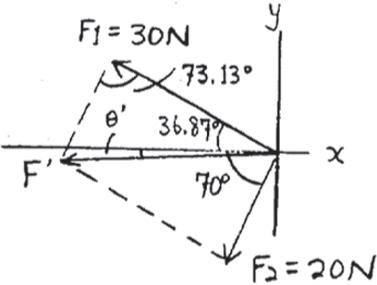

© 2016 Pearson Education, Inc., Upper Saddle River, NJ. All rights reserved. This material is protected under all copyright laws as they currently exist. No portion of this material may be reproduced, in any form or by any means, without permission in writing from the publisher.
2–18.
Determine the magnitudeanddirection of the resultant of the three forces by first finding the resultant and then forming FR = F ¿+ F1 F ¿= F2 + F3 FR = F1 + F2 + F3
SOLUTION
u = 23.53° - 21.15° = 2.37° 19.18 sin 13.34° = 30 sin f ; f = 21.15° FR = 2 (47.07)2 + (30)2 - 2(47.07)(30) cos 13.34° = 19.18 = 19.2 N 20 sin u ¿ = 47.07 sin 70° ; u ¿ = 23.53° F ¿ = 2 (20)2 + (50)2 - 2(20)(50) cos 70° = 47.07 N
Ans. Ans.
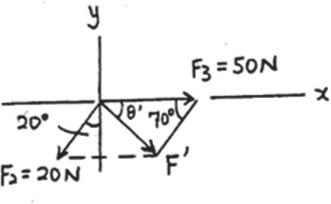
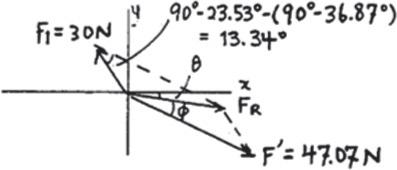
© 2016 Pearson Education, Inc., Upper Saddle River, NJ. All rights reserved. This material is protected under all copyright laws as they currently exist. No portion of this material may be reproduced, in any form or by any means, without permission in writing from the publisher.
2–19.
u (0° … u … 90°)
Determine the design angle for strut AB so that the 400-lb horizontal force has a component of 500 lb directed from A towards C.What is the component of force acting along member AB?Take f = 40°
SOLUTION
Parallelogram Law: The parallelogram law of addition is shown in Fig. a
Trigonometr y: Using law of sines (Fig b), we have
Thus,
Using law of sines (Fig b)
= 621 lb
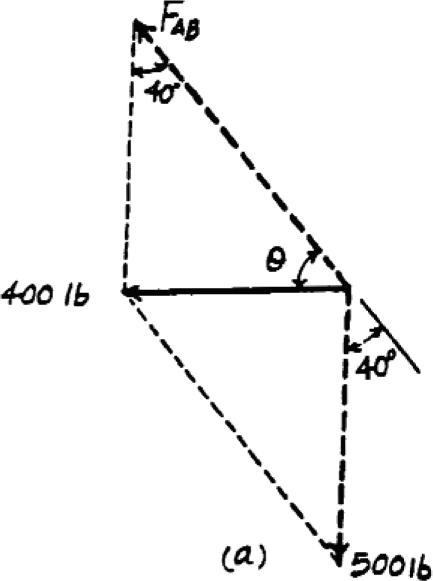
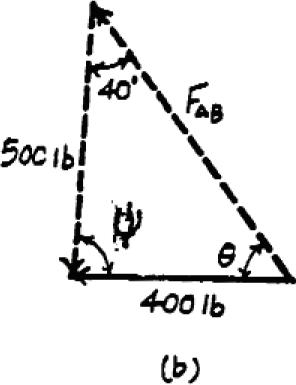
© 2016 Pearson Education, Inc., Upper Saddle River, NJ. All rights reserved. This material is protected under all copyright laws as they currently exist. No portion of this material may be reproduced, in any form or by any means, without permission in writing from the publisher.
*2–20.
(0° … f … 90°)
Determine the design angle between struts AB and AC so that the 400-lb horizontal force has a component of 600 lb which acts up to the left, in the same direction as from B towards A.Take u = 30°
SOLUTION
Parallelogram Law: The parallelogram law of addition is shown in Fig. a
Trigonometr y: Using law of cosines (Fig b), we have
FAC = 24002 + 6002 - 2(400)(600) cos 30° = 322.97 lb
The angle can be determined using law of sines (Fig. b).
sin f
400 = sin 30° 322.97
sin f = 0.6193
f = 38.3°
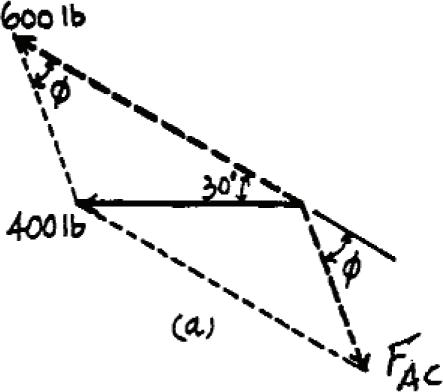
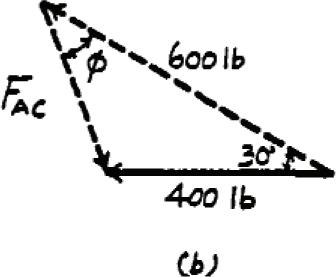
© 2016 Pearson Education, Inc., Upper Saddle River, NJ. All rights reserved. This material is protected under all copyright laws as they currently exist. No portion of this material may be reproduced, in any form or by any means, without permission in writing from the publisher.
2–21.
Determine the magnitude and direction of the resultant force, FR measured counterclockwise from the positive x axis. Solve the problem by first finding the resultant F ′ = F1 + F2 and then forming FR = F ′ + F3.
Solution
Parallelogram Law. The parallelogram law of addition for F1 and F2 and then their resultant F ′ and F3 are shown in Figs. a and b, respectively. Trigonometry. Referring to Fig. c, F ′ = 22002 + 4002 = 447 21 N u ′ = tan -
Thus f ′ = 90° - 30° - 26.57° = 33.43°
Using these results to apply the law of cosines by referring to Fig. d, FR = 23002 + 447 212 - 2(300)(447 21) cos 33 43° = 257 05 N = 257 kN
Then, apply the law of sines, sin u 300 = sin 33 43° 257 05 ; u = 40 02°
Thus, the direction f of FR measured counterclockwise from the positive x axis is f = 90° + 33 43° + 40 02° = 163 45° = 163°
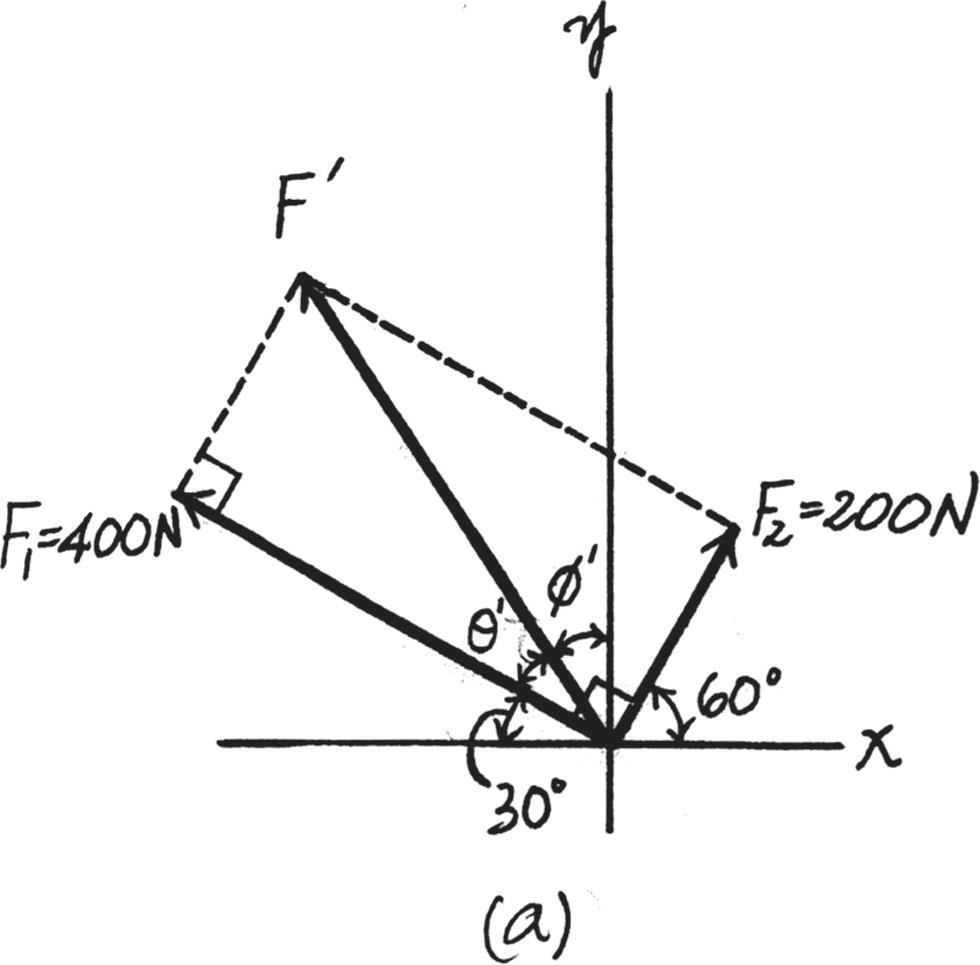
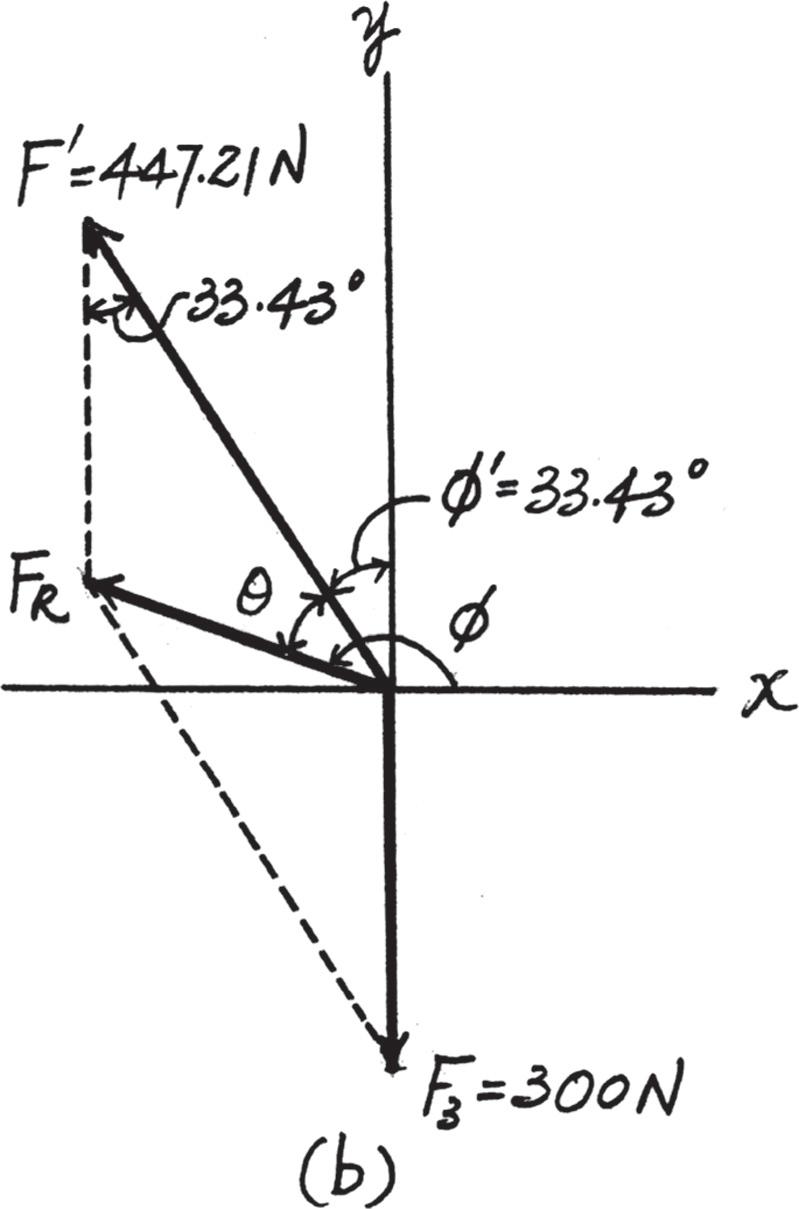
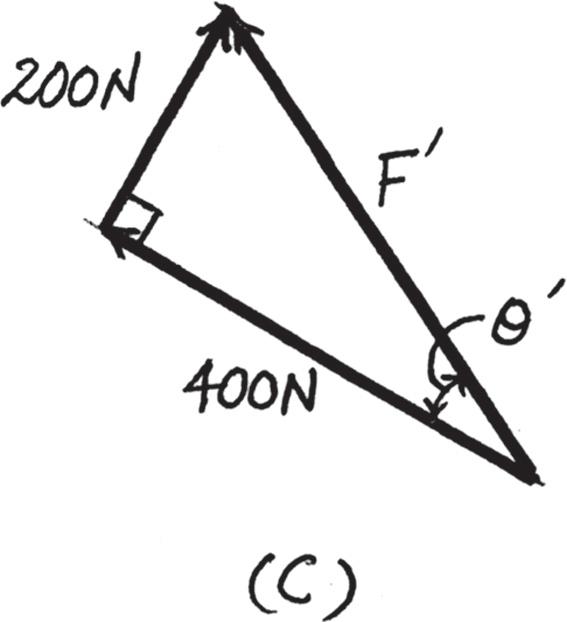
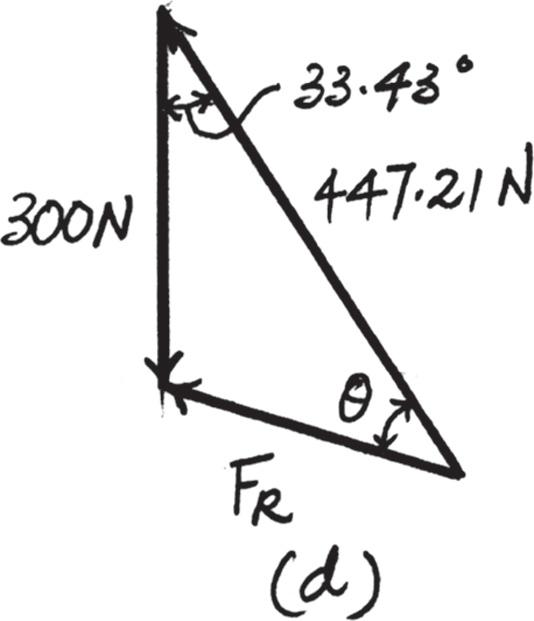
© 2016 Pearson Education, Inc., Upper Saddle River, NJ. All rights reserved. This material is protected under all copyright laws as they currently exist. No portion of this material may be reproduced, in any form or by any means, without permission in writing from the publisher.
2–22.
Determine the magnitude and direction of the resultant force, measured counterclockwise from the positive x axis. Solve l by first finding the resultant F ′ = F2 + F3 and then forming FR = F ′ + F1.
Solution
Parallelogram Law. The parallelogram law of addition for F2 and F3 and then their resultant F ′ and F1 are shown in Figs. a and b, respectively. Trigonometry. Applying the law of cosines by referring to Fig. c,
F ′ = 22002 + 3002 - 2(200)(300) cos 30° = 161.48 N
Using this result to apply the sines law, Fig. c, sin u ′ 200 = sin 30° 161.48 ; u ′ = 38.26°
Using the results of F ′ and u ′ to apply the law of cosines by referring to Fig. d, FR = 2161 482 + 4002 - 2(161 48)(400) cos 21 74° = 257 05 N = 257 N
Then, apply the sines law, sin u 161 48 = sin 21 74° 257 05 ; u = 13 45°
Thus, the direction f of FR measured counterclockwise from the positive x axis is f = 90° + 60° + 13 45° = 163 45° = 163° Ans.
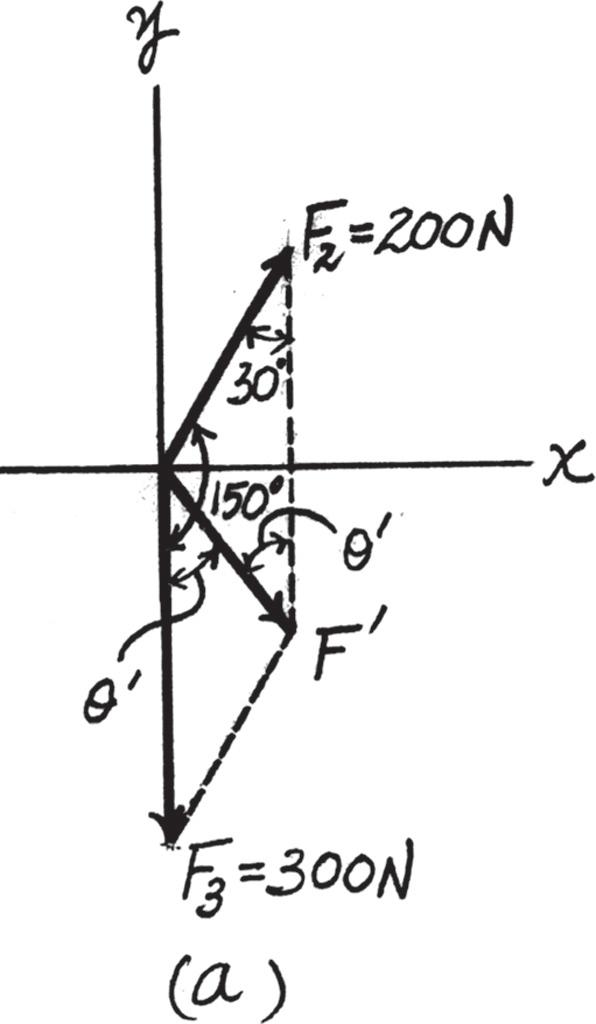
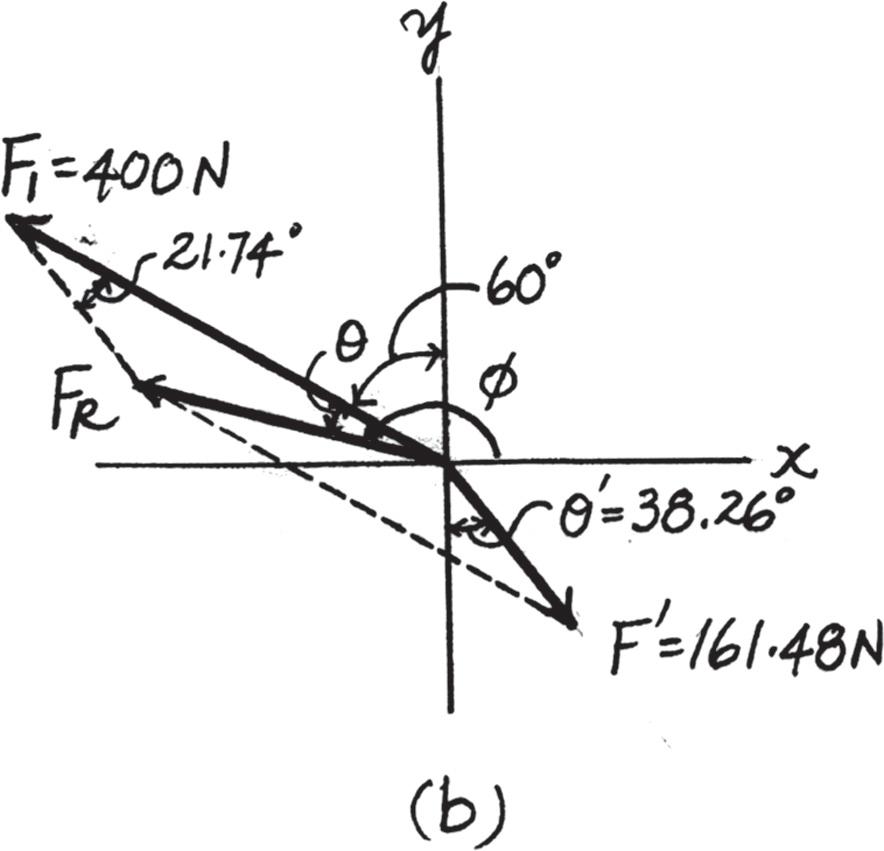
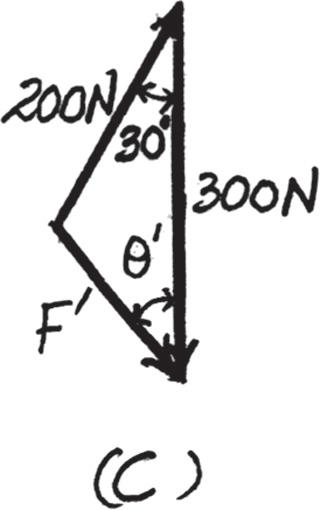

© 2016 Pearson Education, Inc., Upper Saddle River, NJ. All rights reserved. This material is protected under all copyright laws as they currently exist. No portion of this material may be reproduced, in any form or by any means, without permission in writing from the publisher.
2–23.
F2 = 600 N
F1 = 400 N
Two forces act on the screw eye If and , determine the angle between them, so that the resultant force has a magnitude of . FR = 800 N u(0° … u … 180°)
SOLUTION
The parallelogram law of addition and triangular rule are shown in Figs. a and b, respectively Applying law of cosines to Fig. b,
800 = 24002 + 6002 - 2(400)(600) cos (180° - u°)
8002 = 4002 + 6002 - 480000 cos (180° - u)
180° - u = 104.48 cos (180° - u) =- 0.25
Ans. u = 75.52° = 75.5°
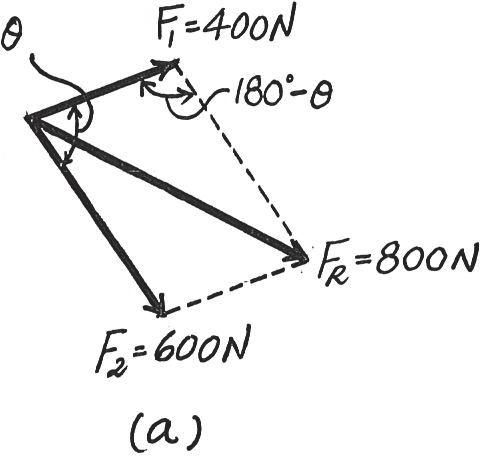
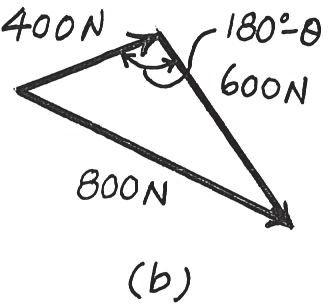
© 2016 Pearson Education, Inc., Upper Saddle River, NJ. All rights reserved. This material is protected under all copyright laws as they currently exist. No portion of this material may be reproduced, in any form or by any means, without permission in writing from the publisher.
*2–24.
Two forces F1 and F2 act on the screw eye. If their lines of action are at an angle apart and the magnitude of each force is determine the magnitude of the resultant force FR and the angle between FR and F1 F1 = F2 = F, u
SOLUTION
F sin f = F sin (u - f)
sin (u - f) = sin f
u - f = f
f = u 2
Since Since Then
u cos (180° - u) =- cos u FR = 2 (F)2 + (F)2 - 2(F)(F) cos (180° - u)
= F A 22 B 2
+
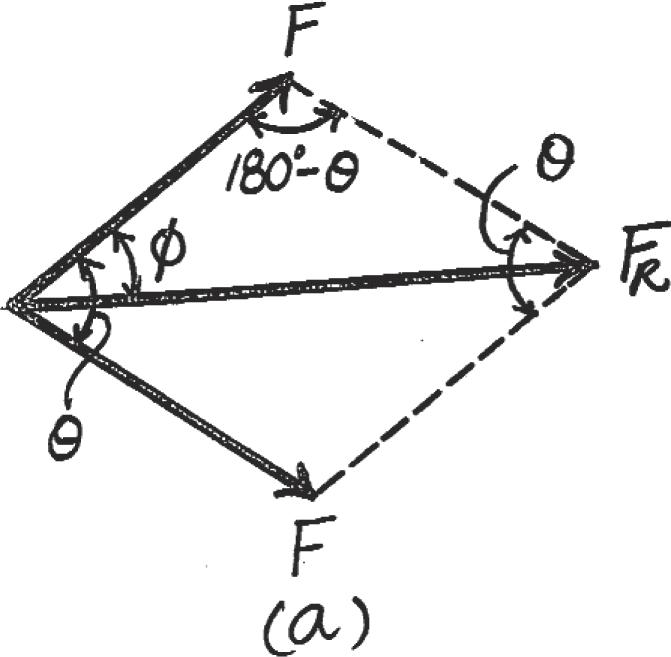
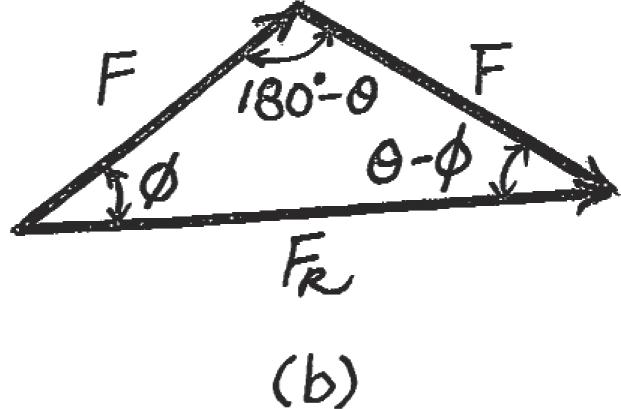
© 2016 Pearson Education, Inc., Upper Saddle River, NJ. All rights reserved. This material is protected under all copyright laws as they currently exist. No portion of this material may be reproduced, in any form or by any means, without permission in writing from the publisher.
2–25.
If F1 = 30 lb and F2 = 40 lb, determine the angles u and f so that the resultant force is directed along the positive x axis and has a magnitude of FR = 60 lb.
Solution
Parallelogram Law. The parallelogram law of addition is shown in Fig. a, Trigonometry. Applying the law of cosine by referring to Fig. b,
402 = 302 + 602 - 2(30)(60) cos u
u = 36 34° = 36 3°
And
302 = 402 + 602 - 2(40)(60) cos f
f = 26 38° = 26 4°
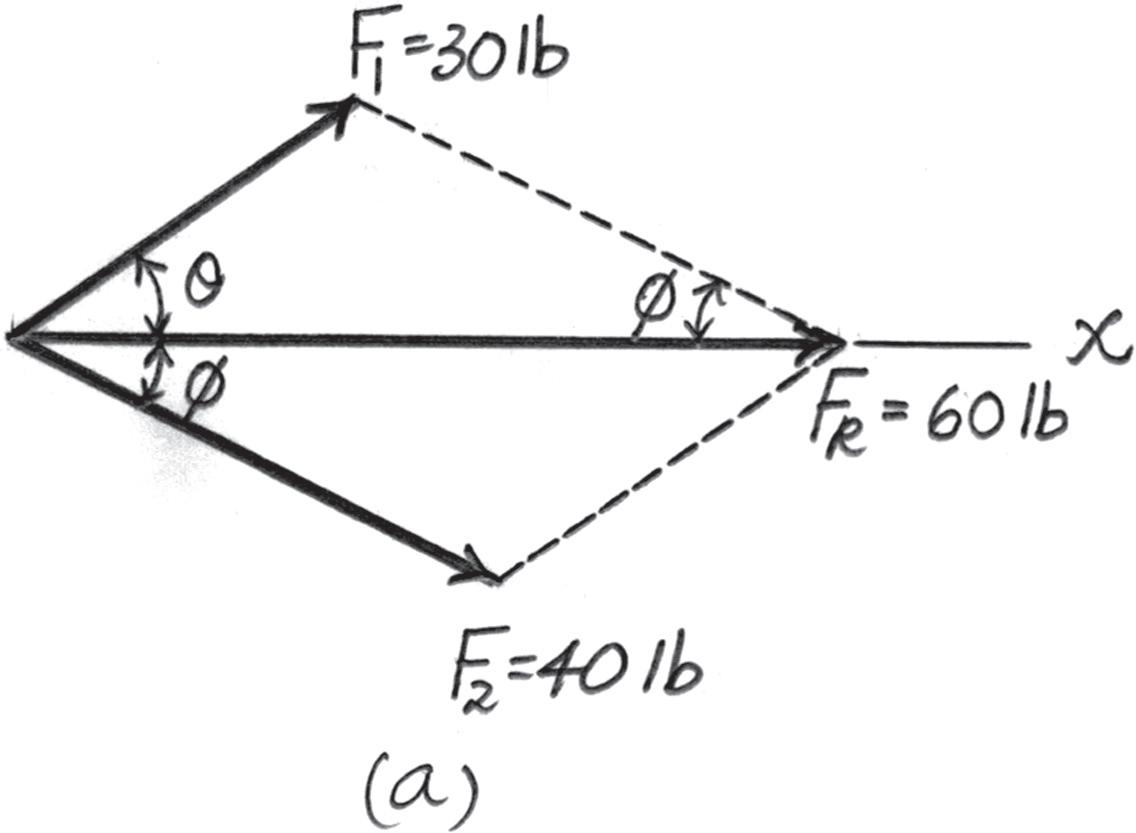

2016 Pearson Education, Inc., Upper Saddle River, NJ. All rights reserved. This material is protected under all copyright laws as they currently exist. No portion of this material may be reproduced, in any form or by any means, without permission in writing from the publisher.
2–26.
Determine the magnitude and direction u of FA so that the resultant force is directed along the positive x axis and has a magnitude of 1250 N.
SOLUTION
© 2016 Pearson Education, Inc., Upper Saddle River, NJ. All rights reserved. This material is protected under all copyright laws as they currently exist. No portion of this material may be reproduced, in any form or by any means, without permission in writing from the publisher.
2–27.
Determine the magnitude and direction, measured counterclockwise from the positive x axis, of the resultant force acting on the ring at O, if FA = 750 N and u = 45°
SOLUTION
Scalar Notation: Suming the force components algebraically, we have
S + FRx = Σ Fx; FRx = 750 sin 45° + 800 cos 30° = 1223.15 N S + c FRy = Σ Fy; FRy = 750 cos 45° - 800 sin 30° = 130.33 N c
The magnitude of the resultant force FR is FR = 3F Rx 2 + F Ry 2 = 21223.152 + 130.332 = 1230 N = 1.23 kN
The directional angle u measured counterclockwise from positive x axis is u = tan - 1 FRy FRx =
Ans.
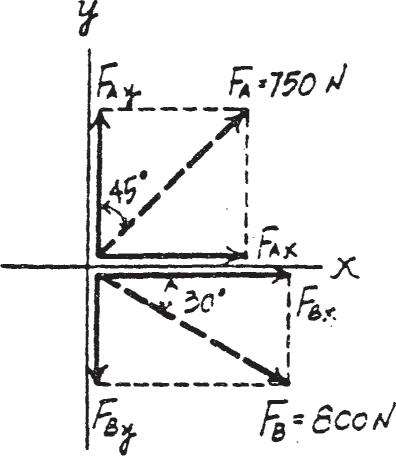
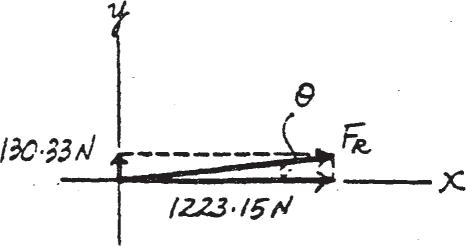
*2–28.
Determine the magnitude of force F so that the resultant FR of the three forces is as small as possible. What is the minimum magnitude of FR?.
Solution
Parallelogram Law. The parallelogram laws of addition for 6 kN and 8 kN and then their resultant F ′ and F are shown in Figs. a and b, respectively. In order for FR to be minimum, it must act perpendicular to F Trigonometry. Referring to Fig. b, F ′ = 26 2 + 82 = 10 0 kN u = tan - 1 a 8 6 b = 53 13°
Referring to Figs. c and d, FR = 10 0 sin 83 13° = 9 928 kN = 9 93 kN
F = 10 0 cos 83 13° = 1 196 kN = 1 20 kN
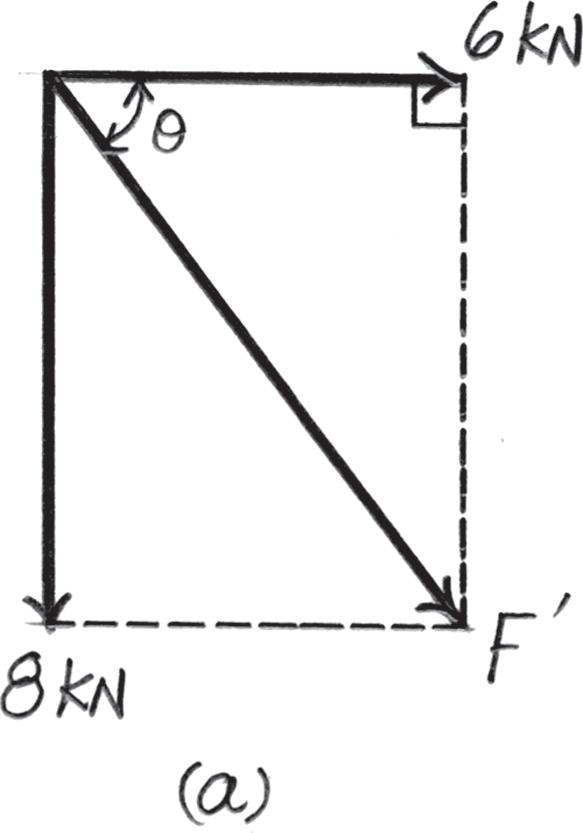
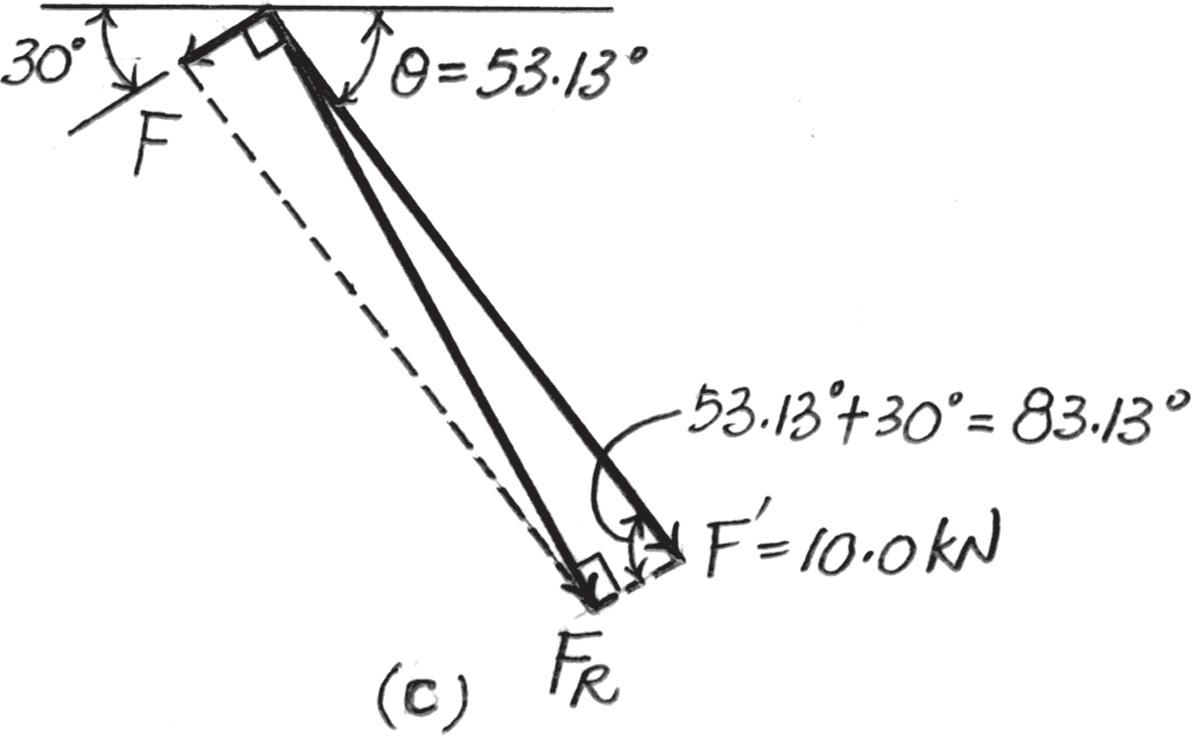
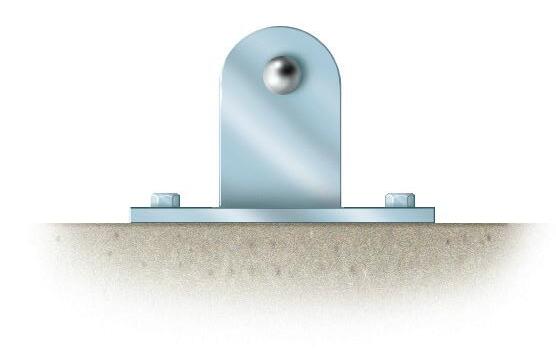
© 2016 Pearson Education, Inc., Upper Saddle River, NJ. All rights reserved. This material is protected under all copyright laws as they currently exist. No portion of this material may be reproduced, in any form or by any means, without permission in writing from the publisher. Ans: FR = 9 93 kN F = 1 20 kN
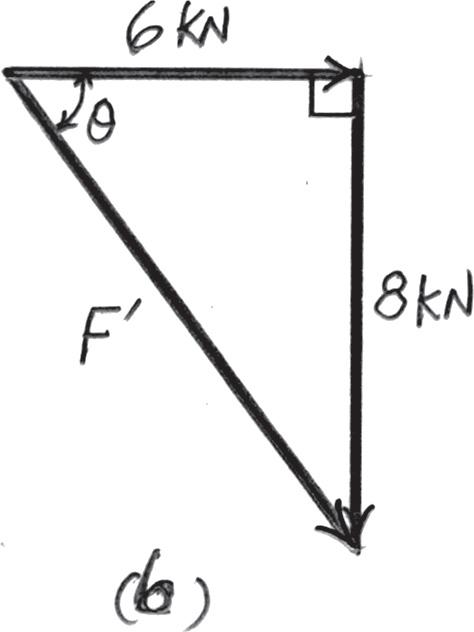

© 2016 Pearson Education, Inc., Upper Saddle River, NJ. All rights reserved. This material is protected under all copyright laws as they currently exist. No portion of this material may be reproduced, in any form or by any means, without permission in writing from the publisher.
2–29.
3 kN
If the resultant force of the two tugboats is , directed along the positive axis, determine the required magnitude of force and its direction . u FB x
SOLUTION
The parallelogram law of addition and the triangular rule are shown in Figs. a and b, respectively
Applying the law of cosines to Fig. b,
Using this result and applying the law of sines to Fig. b, yields
Ans. sin u 2 = sin 30° 1.615 u = 38.3° = 1.615kN = 1.61 kN FB = 222 + 32 - 2(2)(3)cos 30°



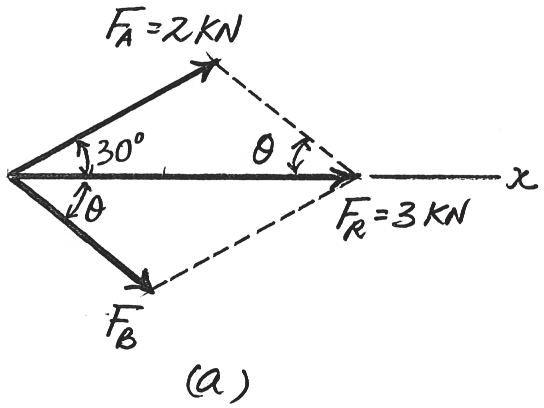
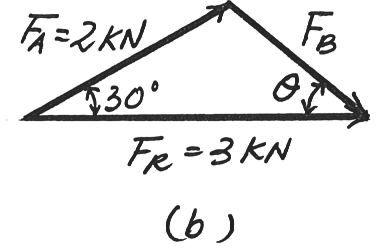
© 2016 Pearson Education, Inc., Upper Saddle River, NJ. All rights reserved. This material is protected under all copyright laws as they currently exist. No portion of this material may be reproduced, in any form or by any means, without permission in writing from the publisher.
2–30.
FB = 3 kN
u = 45°
If and , determine the magnitude of the resultant force of the two tugboats and its direction measured clockwise from the positive axis x
SOLUTION
The parallelogram law of addition and the triangular rule are shown in Figs a and b, respectively
Applying the law of cosines to Fig. b,
4.013 kN = 4.01 kN FR = 2 22 + 32 - 2(2)(3) cos 105°
Using this result and applying the law of sines to Fig. b, yields
4.013
Thus, the direction angle of , measured clockwise from the positive axis, is Ans.



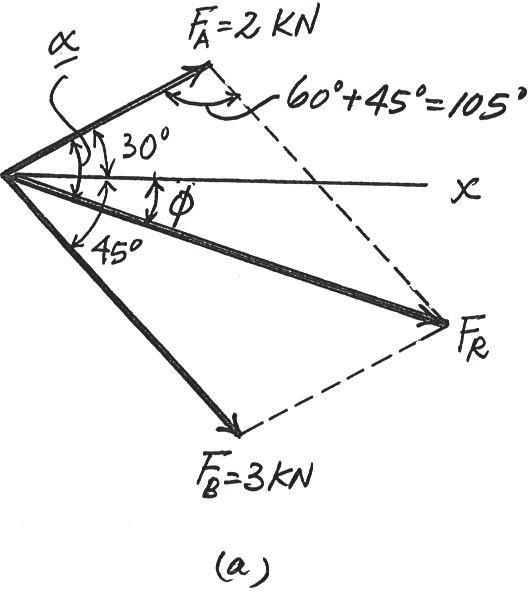
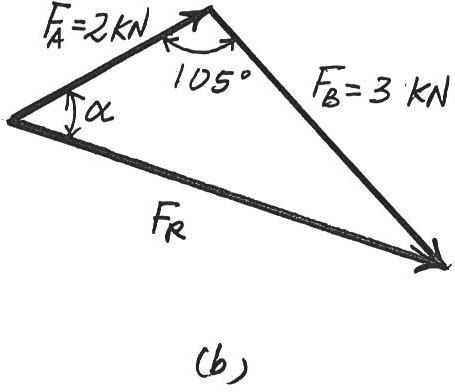
© 2016 Pearson Education, Inc., Upper Saddle River, NJ. All rights reserved. This material is protected under all copyright laws as they currently exist. No portion of this material may be reproduced, in any form or by any means, without permission in writing from the publisher.
2–31.
If the resultant force of the two tugboats is required to be directed towards the positive axis, and is to be a minimum, determine the magnitude of and and the angle u FB FR FB x
SOLUTION
For to be minimum, it has to be directed perpendicular to .Thus,
The parallelogram law of addition and triangular rule are shown in Figs. a and b, respectively.
By applying simple trigonometry to Fig. b,



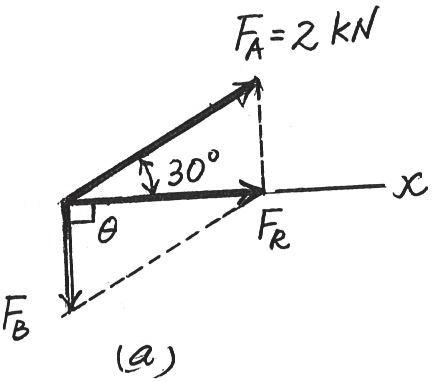
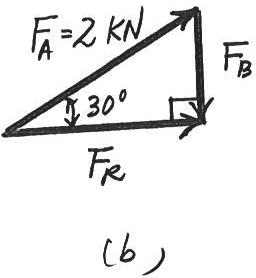
© 2016 Pearson Education, Inc., Upper Saddle River, NJ. All rights reserved. This material is protected under all copyright laws as they currently exist. No portion of this material may be reproduced, in any form or by any means, without permission in writing from the publisher.
Determine the magnitude of the resultant force and its direction, measured counterclockwise from the positive x axis.
Solution
Scalar Notation. Summing the force components along x and y axes algebraically by referring to Fig. a,
Referring to Fig. b, the magnitude of the resultant force FR is
And the directional angle u of FR measured counterclockwise from the positive x axis is
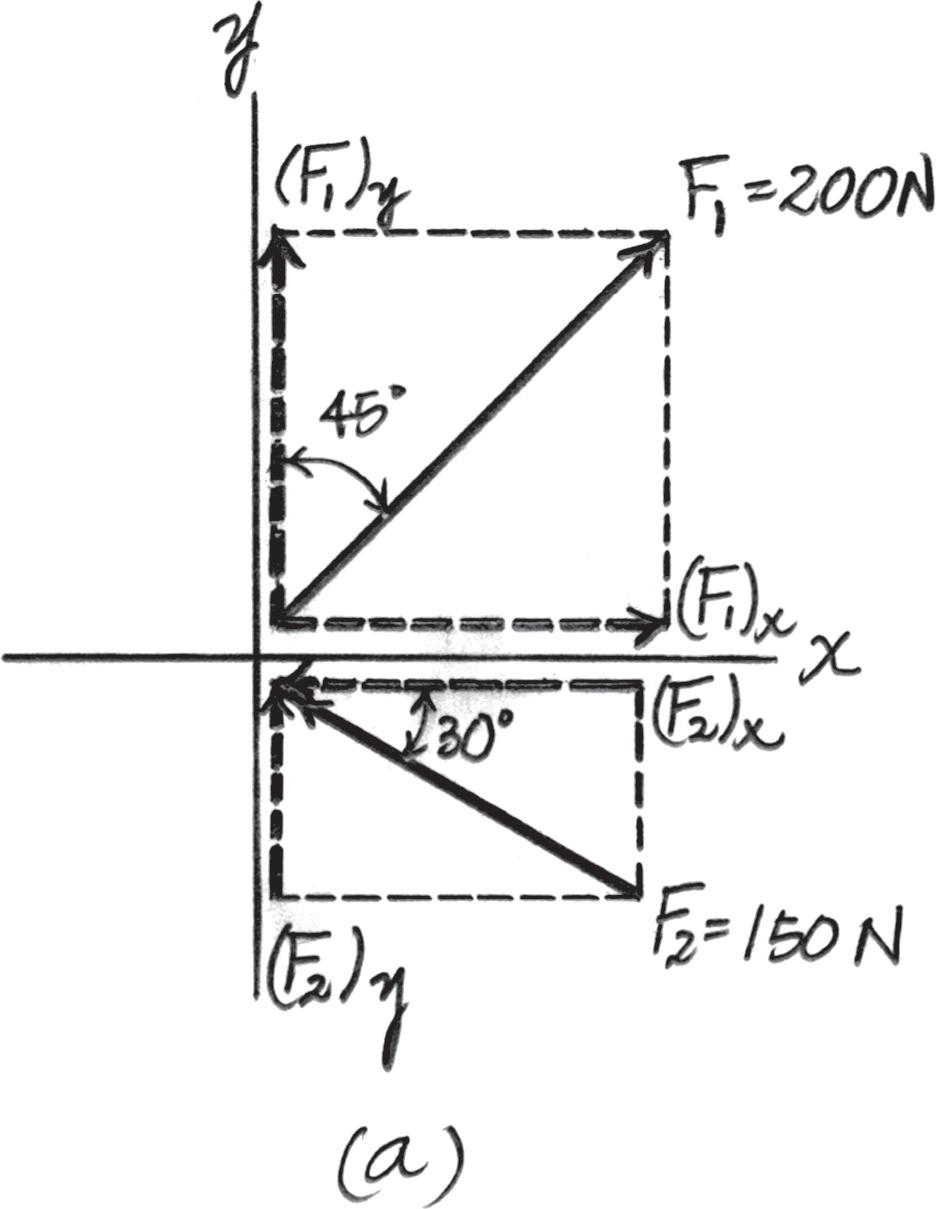
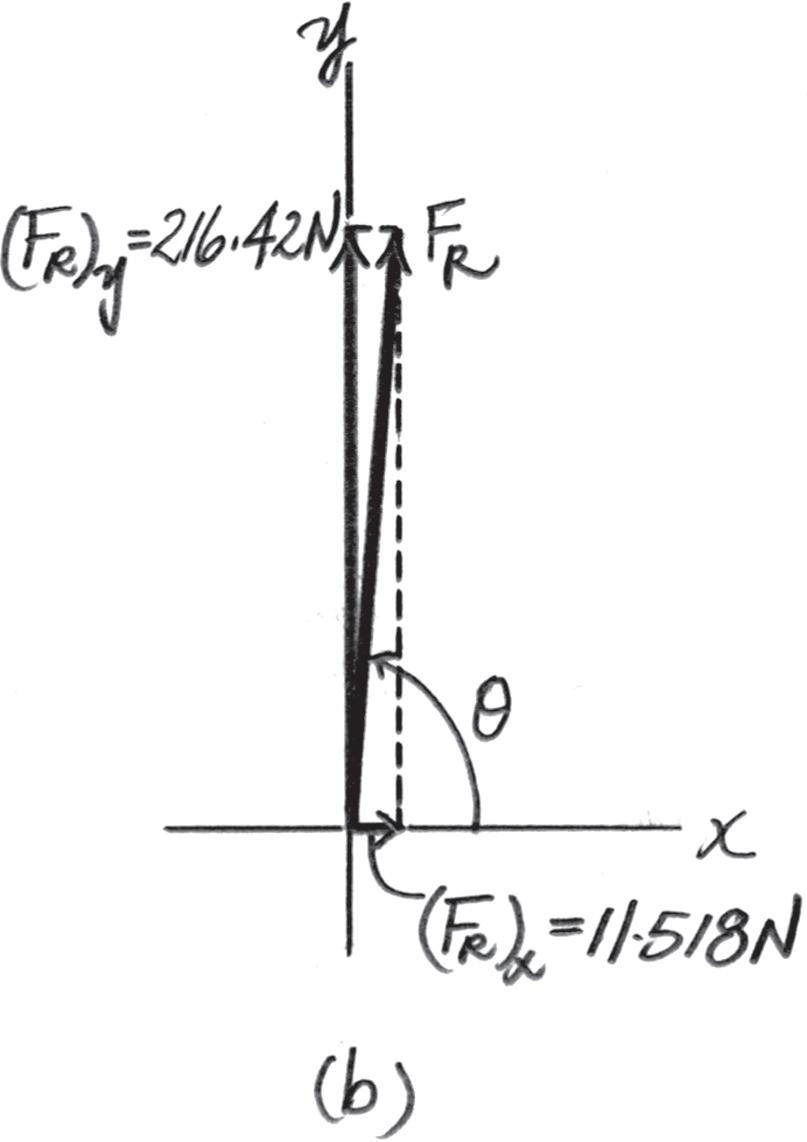
2016 Pearson Education, Inc., Upper Saddle River, NJ. All rights reserved. This material is protected under all copyright laws as they currently exist. No portion of this material may be reproduced, in any form or by any means, without permission in writing from the publisher.
Determine the magnitude of the resultant force and its direction, measured clockwise from the positive x axis.
Solution
Scalar Notation. Summing the force components along x and y axes by referring to Fig. a,
Referring to Fig. b, the magnitude of the resultant force is
And its directional angle u measured clockwise from the positive x axis is
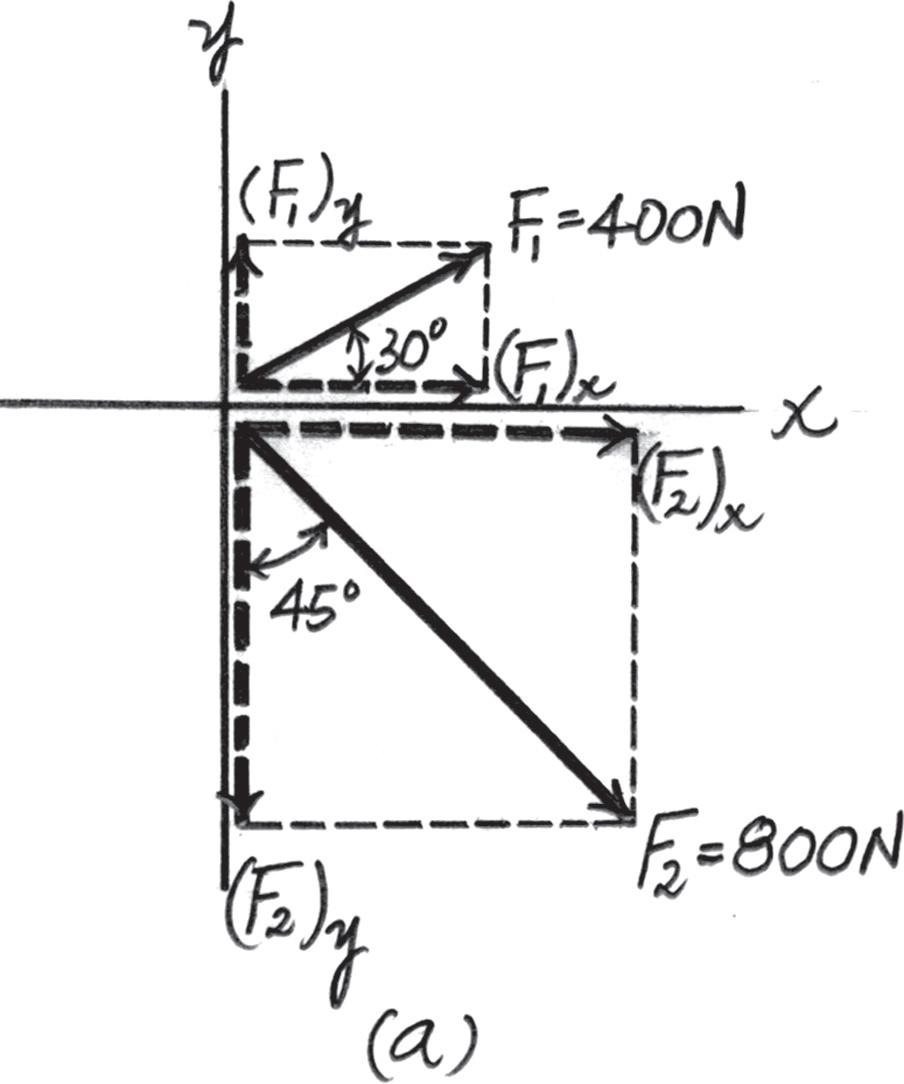
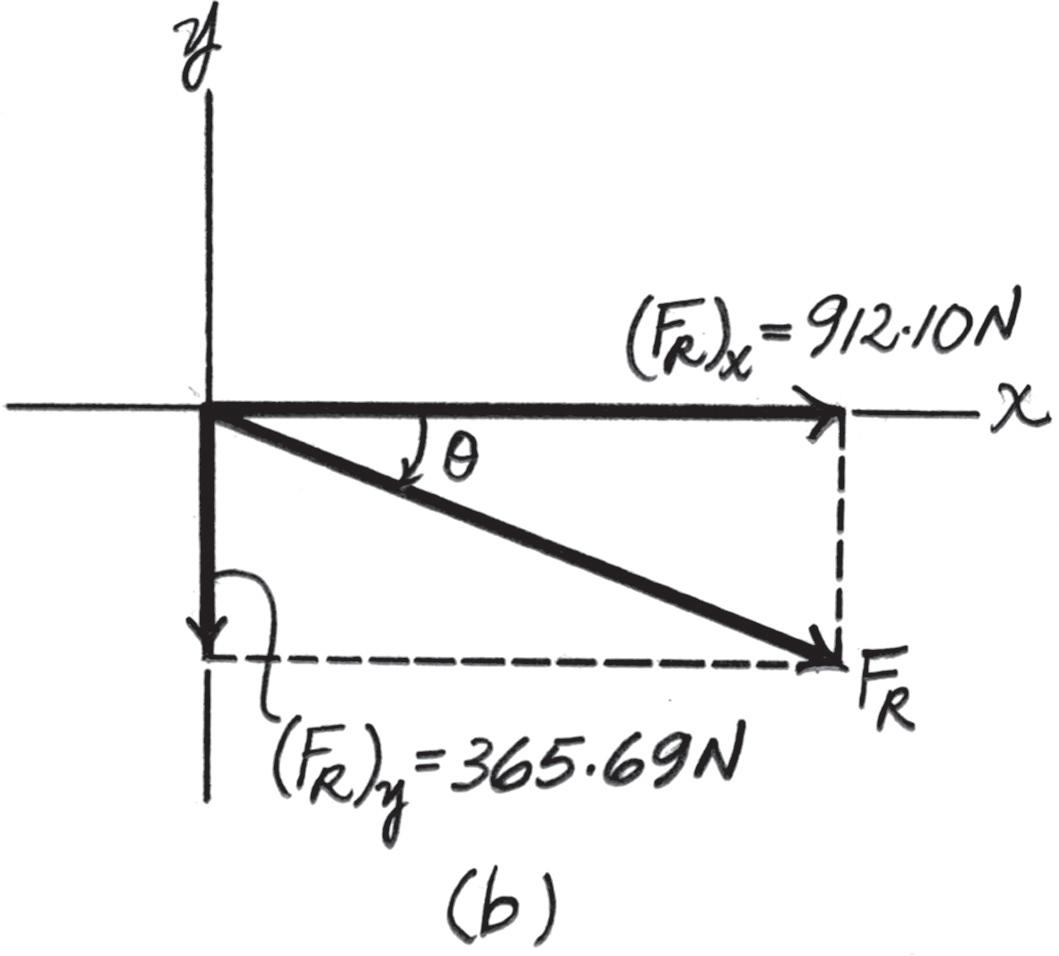
© 2016 Pearson Education, Inc., Upper Saddle River, NJ. All rights reserved. This material is protected under all copyright laws as they currently exist. No portion of this material may be reproduced, in any form or by any means, without permission in writing from the publisher.
2–34.
Resolve and into their and components. y x F2 F1
SOLUTION
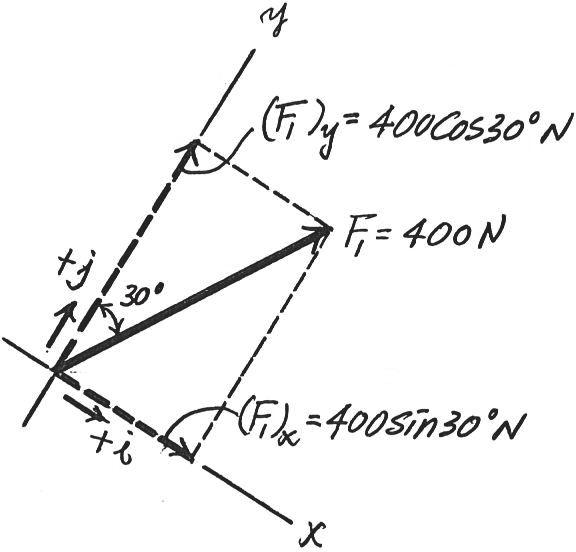



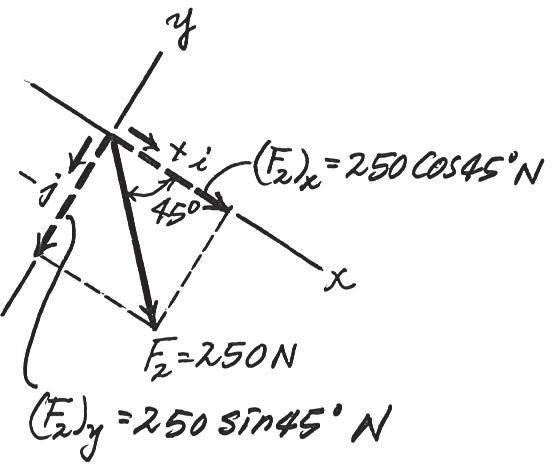
© 2016 Pearson Education, Inc., Upper Saddle River, NJ. All rights reserved. This material is protected under all copyright laws as they currently exist. No portion of this material may be reproduced, in any form or by any means, without permission in writing from the publisher.
2–35.
Determine the magnitude of the resultant force and its direction measured counterclockwise from the positive x axis
SOLUTION
Rectangular Components: By referring to Fig. a, the x and y components of and can be written as
Resultant Force: Summing the force components algebraically along the and axes, we have
The magnitude of the resultant force is Ans.
The direction angle of ,Fig b, measured counterclockwise from the positive axis,is Ans.



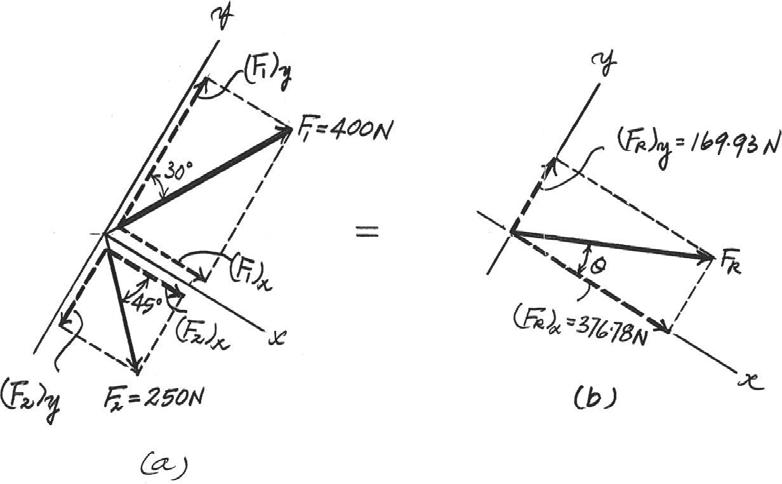
© 2016 Pearson Education, Inc., Upper Saddle River, NJ. All rights reserved. This material is protected under all copyright laws as they currently exist. No portion of this material may be reproduced, in any form or by any means, without permission in writing from the publisher.
*2–36.
Resolve each force acting on the gusset plate into its and components, and express each force as a Cartesian vector y x


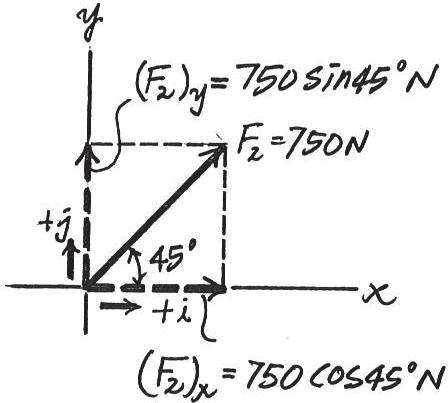
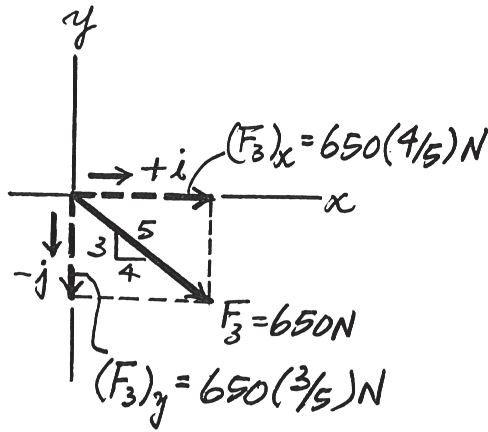
© 2016 Pearson Education, Inc., Upper Saddle River, NJ. All rights reserved. This material is protected under all copyright laws as they currently exist. No portion of this material may be reproduced, in any form or by any means, without permission in writing from the publisher.
2–37.
Determine the magnitude of the resultant force acting on the plate and its direction, measured counterclockwise from the positive x axis
SOLUTION
Rectangular Components: By referring to Fig. a, the x and y components of ,, and can be written as
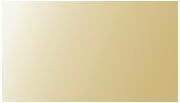
Resultant Force: S umming the force components algebraically along the and axes, we have
The magnitude of the resultant force is Ans.
The direction angle of , measured clockwise from the positive axis,is
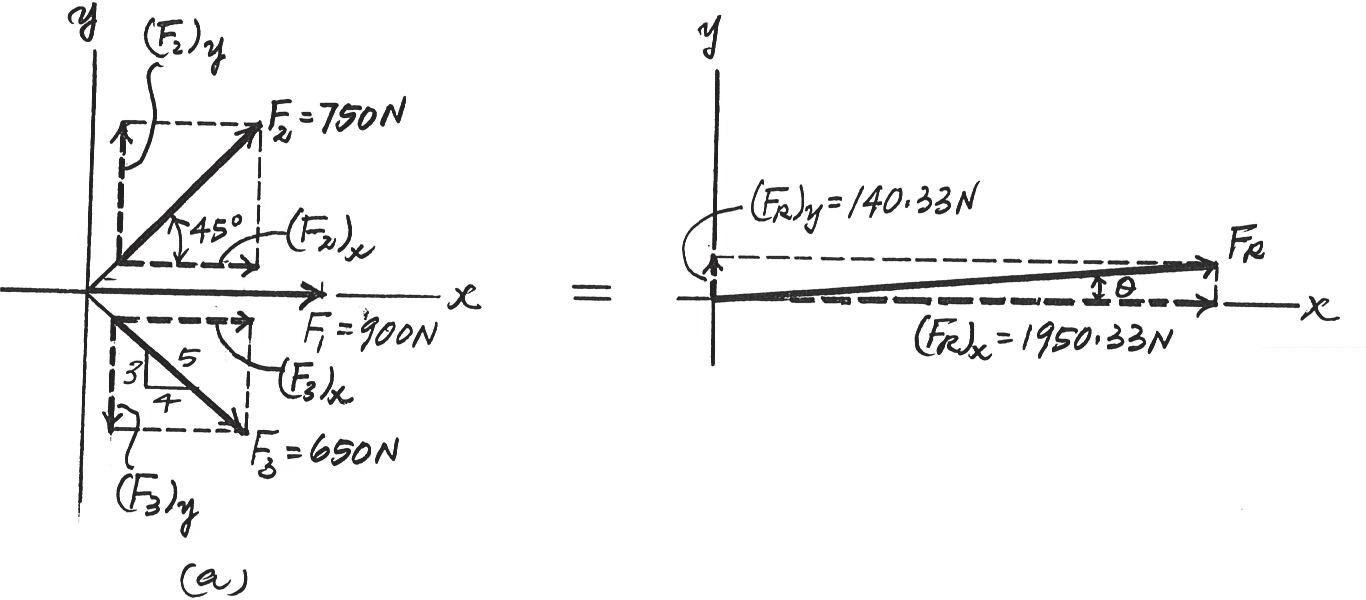
© 2016 Pearson Education, Inc., Upper Saddle River, NJ. All rights reserved. This material is protected under all copyright laws as they currently exist. No portion of this material may be reproduced, in any form or by any means, without permission in writing from the publisher.
2–38.
Express each of the three forces acting on the support in Cartesian vector form and determine the magnitude of the resultant force and its direction, measured clockwise from positive x axis.
Solution
Cartesian Notation. Referring to Fig. a,
Thus, the resultant force is
Referring to Fig. b, the magnitude of FR is
And its directional angle u measured clockwise from the positive x axis is
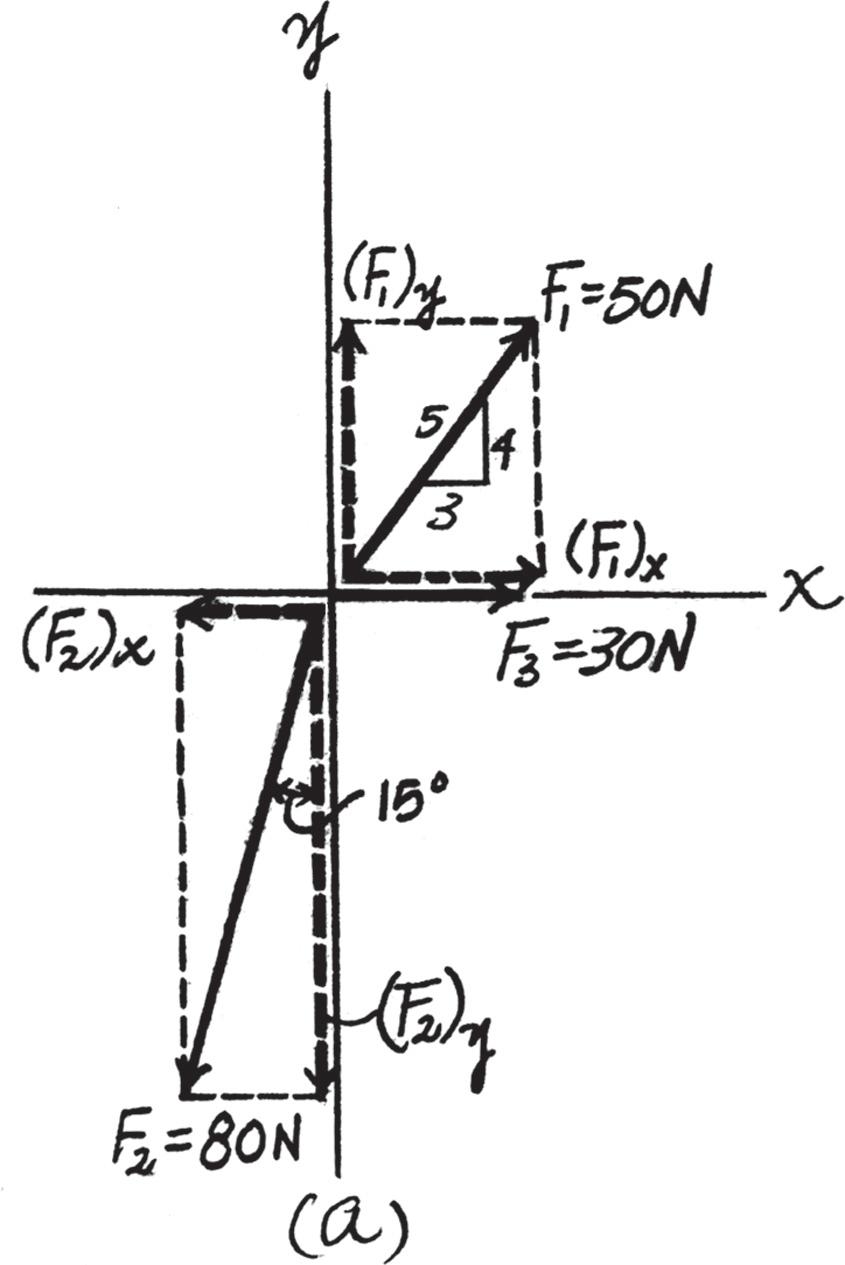
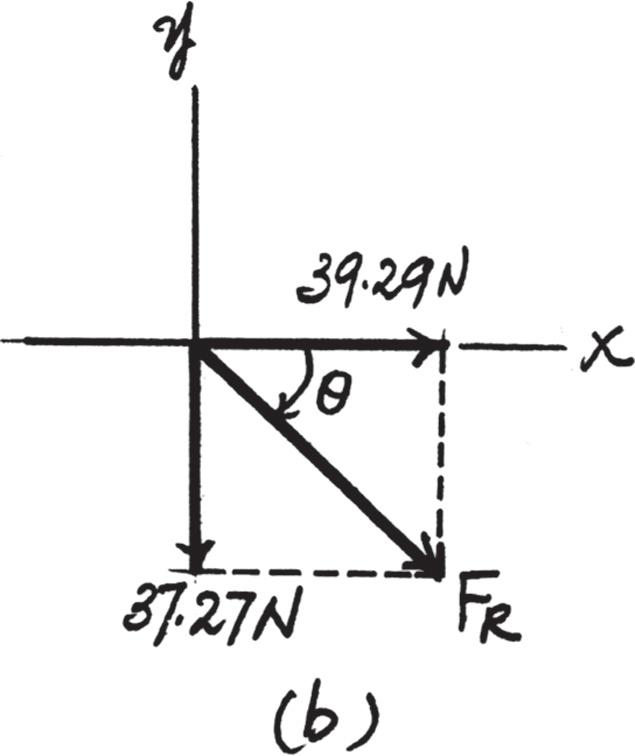
© 2016 Pearson Education, Inc., Upper Saddle River, NJ. All rights reserved. This material is protected under all copyright laws as they currently exist. No portion of this material may be reproduced, in any form or by any means, without permission in writing from the publisher.
2–39.
SOLUTION
© 2016 Pearson Education, Inc., Upper Saddle River, NJ. All rights reserved. This material is protected under all copyright laws as they currently exist. No portion of this material may be reproduced, in any form or by any means, without permission in writing from the publisher.
*2–40.
Determ i ne t h e magn i tu d eo ft h e resu l tant force an di ts d irection, measured counterclockwise from the positive x axis
SOLUTION
© 2016 Pearson Education, Inc., Upper Saddle River, NJ. All rights reserved. This material is protected under all copyright laws as they currently exist. No portion of this material may be reproduced, in any form or by any means, without permission in writing from the publisher.
2–41.
Determine the magnitude of the resultant force and its direction, measured counterclockwise from the positive x axis.
Solution
Scalar Notation. Summing the force components along x and y axes algebraically by referring to Fig. a,
By referring to Fig. b, the magnitude of the resultant force FR is
And the directional angle u of FR measured counterclockwise from the positive x axis is
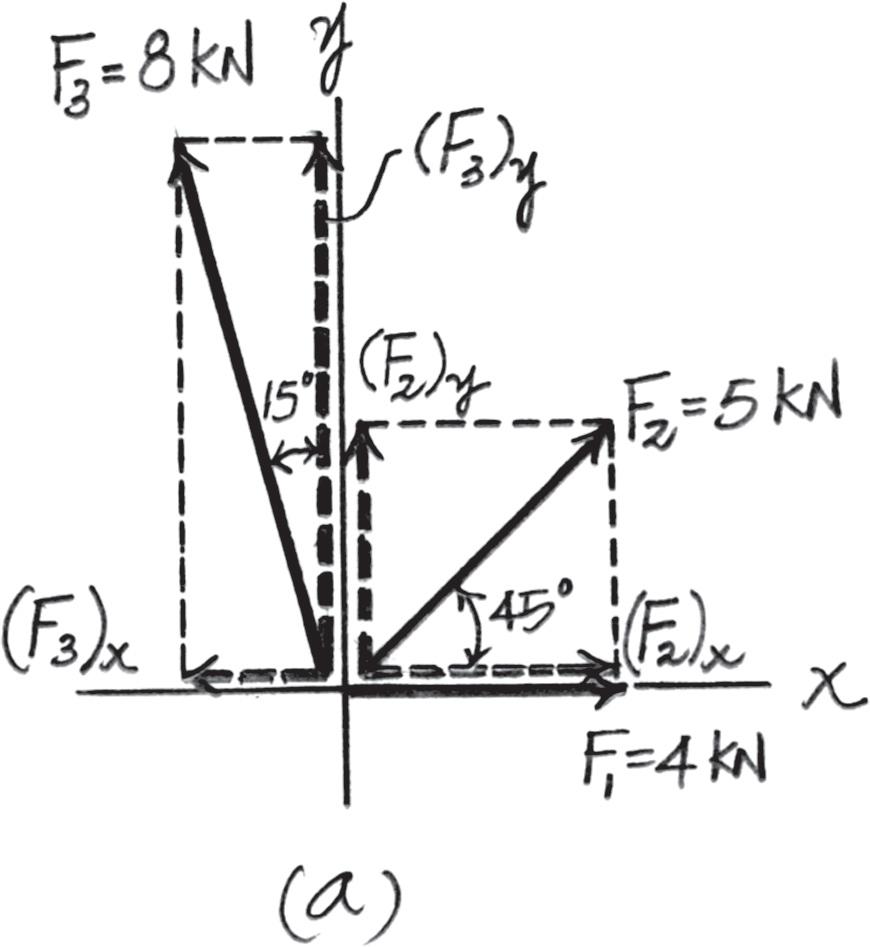
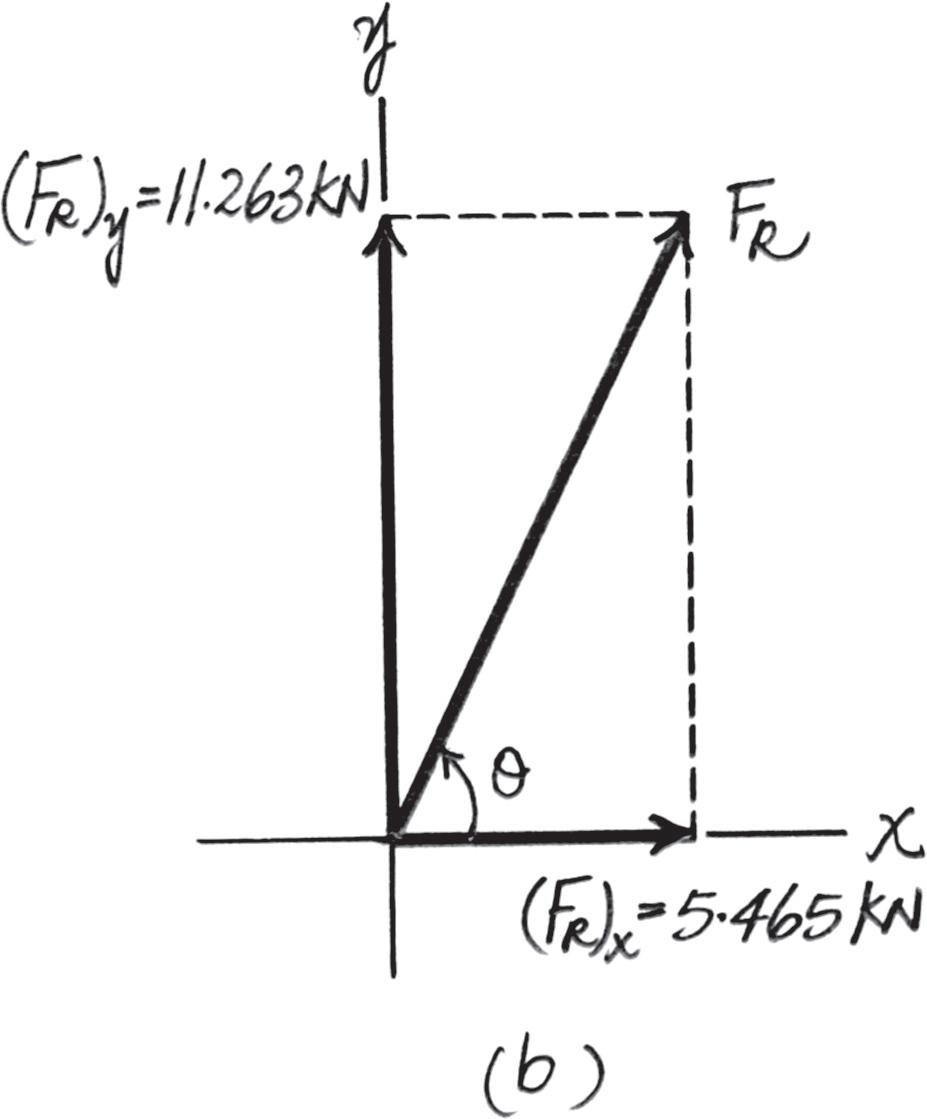
© 2016 Pearson Education, Inc., Upper Saddle River, NJ. All rights reserved. This material is protected under all copyright laws as they currently exist. No portion of this material may be reproduced, in any form or by any means, without permission in writing from the publisher.
2–42.
SOLUTION
F1 = 4 5 (850) i3 5 (850) j
= {680 i - 510 j}N
F2 =- 625 sin 30° i - 625 cos 30° j
= { - 312 i - 541 j}N
F3 =- 750 sin 45° i + 750 cos 45° j
Express ,, and as Cartesian vectors. F3 F2 F1 + y x
Ans. Ans. Ans. { -530 i 530 j}N
© 2016 Pearson Education, Inc., Upper Saddle River, NJ. All rights reserved. This material is protected under all copyright laws as they currently exist. No portion of this material may be reproduced, in any form or by any means, without permission in writing from the publisher.
2–43.
Determine the magnitude of the resultant force and its direction measured counterclockwise from the positive x axis
SOLUTION
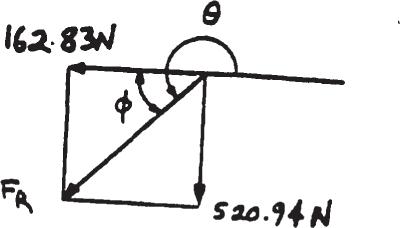
2016 Pearson Education, Inc., Upper Saddle River, NJ. All rights reserved. This material is protected under all copyright laws as they currently exist. No portion of this material may be reproduced, in any form or by any means, without permission in writing from the publisher.
Determine the magnitude of the resultant force and its direction, measured clockwise from the positive x axis.
Solution
Scalar Notation. Summing the force components along x and y axes algebraically by referring to Fig. a,
By referring to Fig. b, the magnitude of resultant force is
And its directional angle u measured clockwise from the positive x axis is
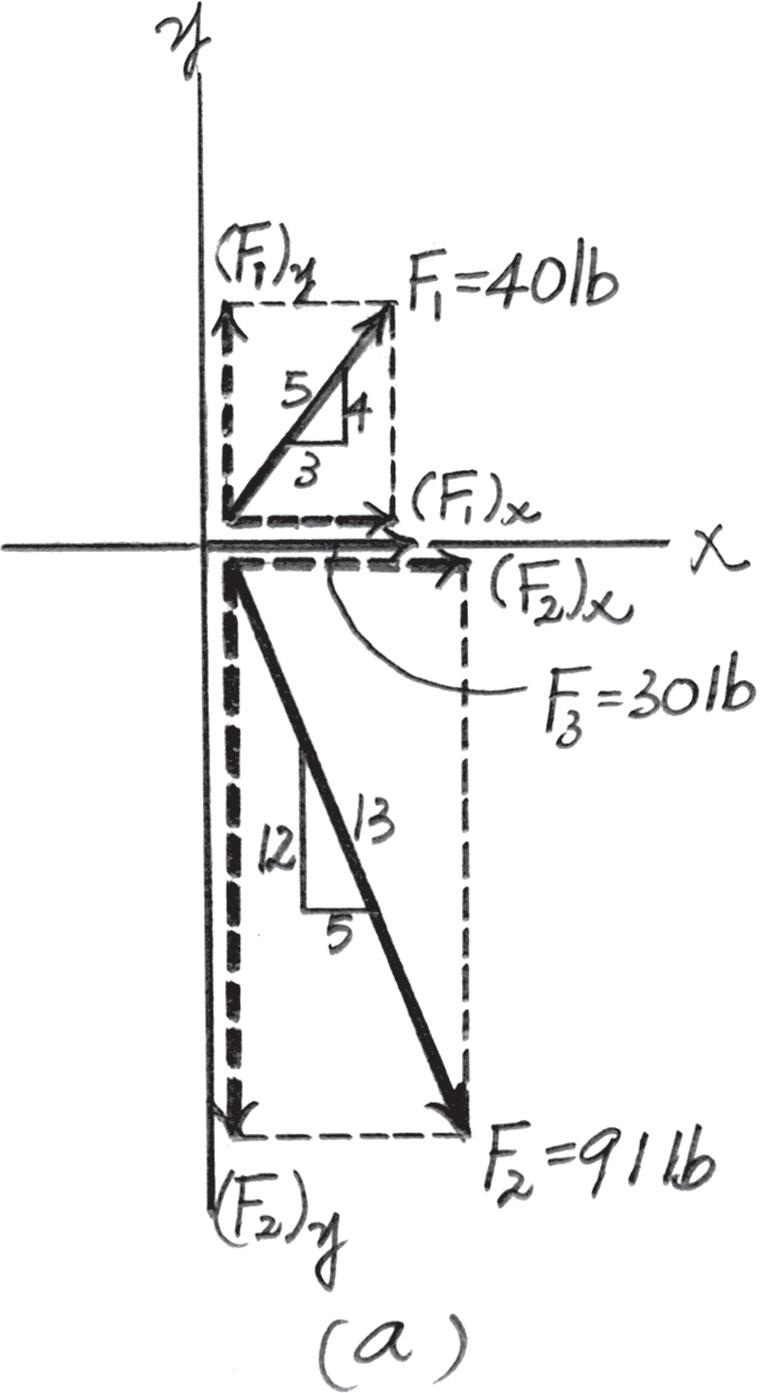
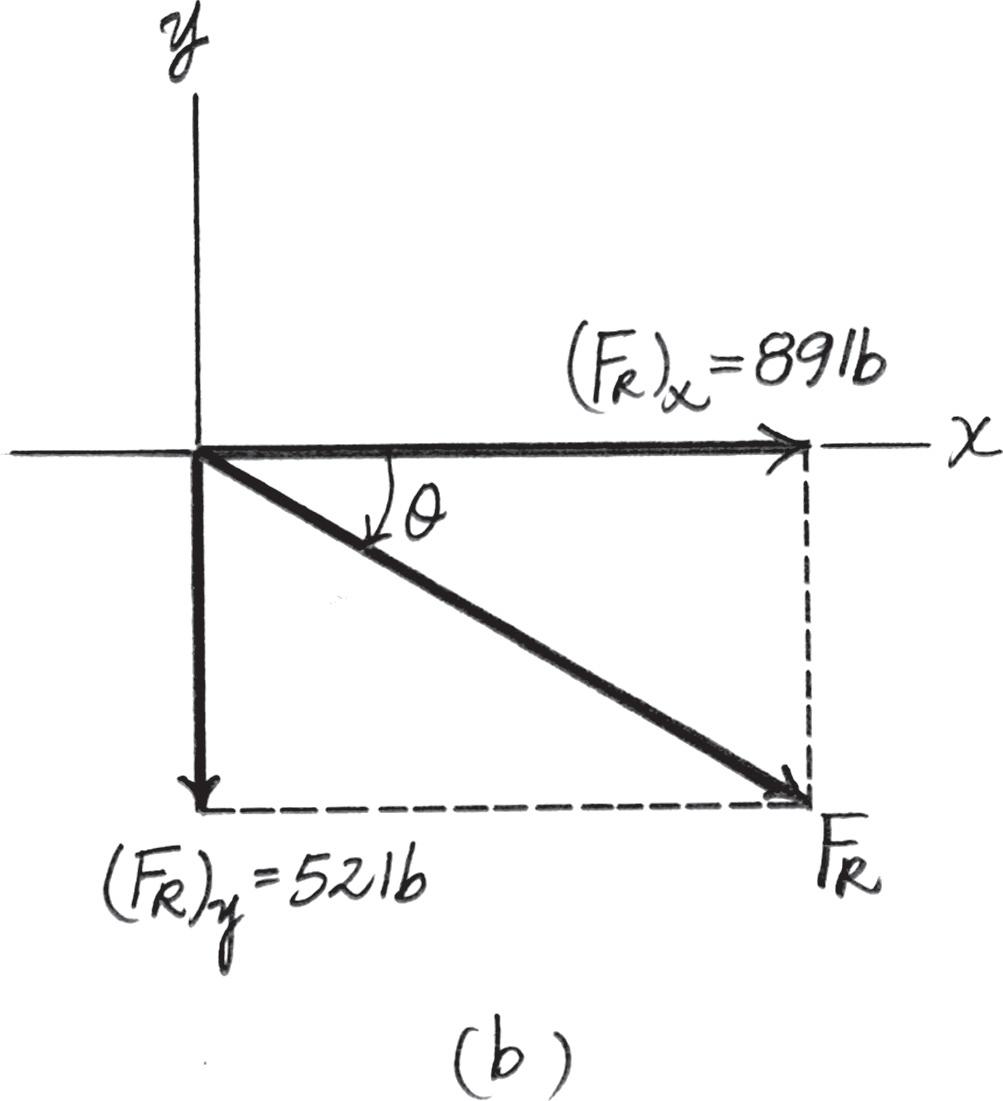
© 2016 Pearson Education, Inc., Upper Saddle River, NJ. All rights reserved. This material is protected under all copyright laws as they currently exist. No portion of this material may be reproduced, in any form or by any means, without permission in writing from the publisher.
2–45.
Determine the magnitude and direction u of the resultant force Express the result in terms of the magnitudes of the components and and the angle f
SOLUTION
Since
From the figure,
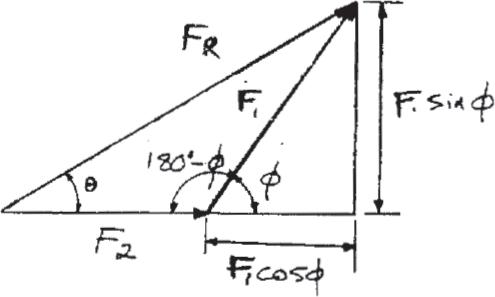
© 2016 Pearson Education, Inc., Upper Saddle River, NJ. All rights reserved. This material is protected under all copyright laws as they currently exist. No portion of this material may be reproduced, in any form or by any means, without permission in writing from the publisher.
2–46.
Determine the magnitude and orientation u of FB so that the resultant force is directed along the positive y axis and has a magnitude of 1500 N.
SOLUTION
Scalar Notation: Suming the force components algebraically, we have S + FRz = Σ Fx;
Solving Eq. (1) and (2) yields u = 68.6° FB = 960 N Ans.
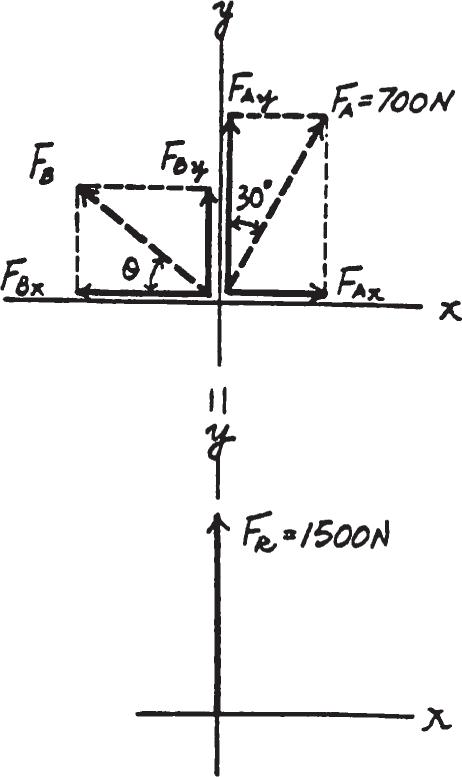
© 2016 Pearson Education, Inc., Upper Saddle River, NJ. All rights reserved. This material is protected under all copyright laws as they currently exist. No portion of this material may be reproduced, in any form or by any means, without permission in writing from the publisher.
2–47.
Determine the magnitude and orientation, measured counterclockwise from the positive y axis, of the resultant force acting on the bracket, if FB = 600 N and u = 20° .
SOLUTION
Scalar Notation: Suming the force components algebraically, we have
S + FRx = Σ Fx; FRx = 700 sin 30° - 600 cos 20° = - 213.8 N = 213.8 N d + c FRy = Σ Fy; FRy = 700 cos 30° + 600 sin 20° = 811.4 N c
The magnitude of the resultant force FR is FR = 2F Rx 2 + F Ry 2 = 2213.82 + 811.42 = 839 N Ans.
The directional angle u measured counterclockwise from positive y axis is u = tan- 1 FRx FRy = tan- 1 a 213.8 811.4 b = 14.8°
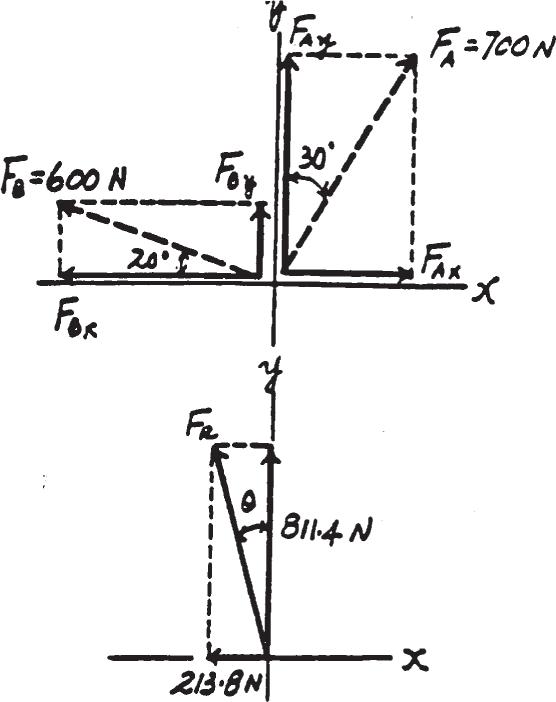
FR = 839 N u = 14 8°
© 2016 Pearson Education, Inc., Upper Saddle River, NJ. All rights reserved. This material is protected under all copyright laws as they currently exist. No portion of this material may be reproduced, in any form or by any means, without permission in writing from the publisher.
*2–48.
Th ree forces act on t h e b rac k et. Determ i ne t h e m agnitude and direction of so that the resultant force is directed along the positive axis and has a magnitude of 800 N. x ¿ F1 u
SOLUTION
F1 = 869 N u = 21.3° 60° + u = 81.34° + c FRy =© Fy ; 800 cos 60° = F1 cos(60° + u) + 200 + 5 13 (180) : + FRx =© Fx ; 800 sin 60° = F1 sin(60° + u)12 13 (180)
© 2016 Pearson Education, Inc., Upper Saddle River, NJ. All rights reserved. This material is protected under all copyright laws as they currently exist. No portion of this material may be reproduced, in any form or by any means, without permission in writing from the publisher.
2–49.
1 = 300 N
If an d d eterm i ne t h e magn i tu d e an d d irection, measured counterclockwise from the positive axis, of the resultant force acting on the bracket. x ¿ u = 10°,
SOLUTION Ans. Ans.
2016 Pearson Education, Inc., Upper Saddle River, NJ. All rights reserved. This material is protected under all copyright laws as they currently exist. No portion of this material may be reproduced, in any form or by any means, without permission in writing from the publisher.
2–50. Express ,, and as Cartesian vectors. F3 F2 F1
SOLUTION
© 2016 Pearson Education, Inc., Upper Saddle River, NJ. All rights reserved. This material is protected under all copyright laws as they currently exist. No portion of this material may be reproduced, in any form or by any means, without permission in writing from the publisher.
2–51.
Determine the magnitude of the resultant force and its orientation measured counterclockwise from the positive x axis
SOLUTION
c FRy =© Fy ; FRy = 15 cos 40° + 5 13 (26) - 36 sin 30° = 3.491 kN : + FRx =© Fx ; FRx = 15 sin 40°12 13 (26) + 36 cos 30° = 16.82 kN
= 2(16.82)2 + (3.491)2 = 17.2
Ans. Ans.
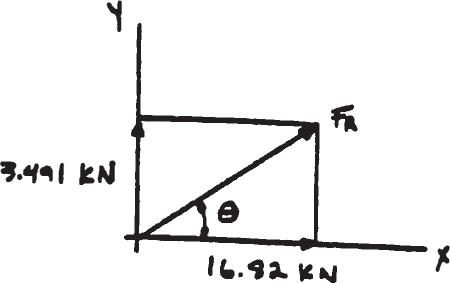
FR = F1 + F2 + F3 F3 = {36 cos 30°i - 36 sin 30°j}kN = {31.2i - 18j}kN F2 = b12 13 (26)i + 5 13 (26)j r kN = { - 24i + 10j}kN F1 = {15 sin 40° i + 15 cos 40° j}kN = {9.64i + 11.5j}kN
© 2016 Pearson Education, Inc., Upper Saddle River, NJ. All rights reserved. This material is protected under all copyright laws as they currently exist. No portion of this material may be reproduced, in any form or by any means, without permission in writing from the publisher.
*2–52.
Determine the x and y components of each force acting on the gusset plate of a bridge truss. Show that the resultant force is zero.
Solution
Scalar Notation. Referring to Fig. a, the x and y components of each forces are
(F1)x = 8 a 4 5 b = 6 40 kN S
(F1)y = 8 a 3 5 b = 4 80 kN T
(F2)x = 6 a 3 5 b = 3.60 kN S
(F2)y = 6 a 4 5 b = 4.80 kN c
(F3)x = 4 kN d
(F3)y = 0
(F4)x = 6 kN d
(F4)y = 0
Summing these force components along x and y axes algebraically, S + (FR)x = Σ Fx; (FR)x = 6 40 + 3 60 - 4 - 6 = 0
+ c (FR)y = Σ Fy ; (FR)y = 4.80 - 4.80 = 0
Thus, FR = 2(FR)x 2 + (FR)y 2 = 2O 2 + O 2 = O (Q.E.D)
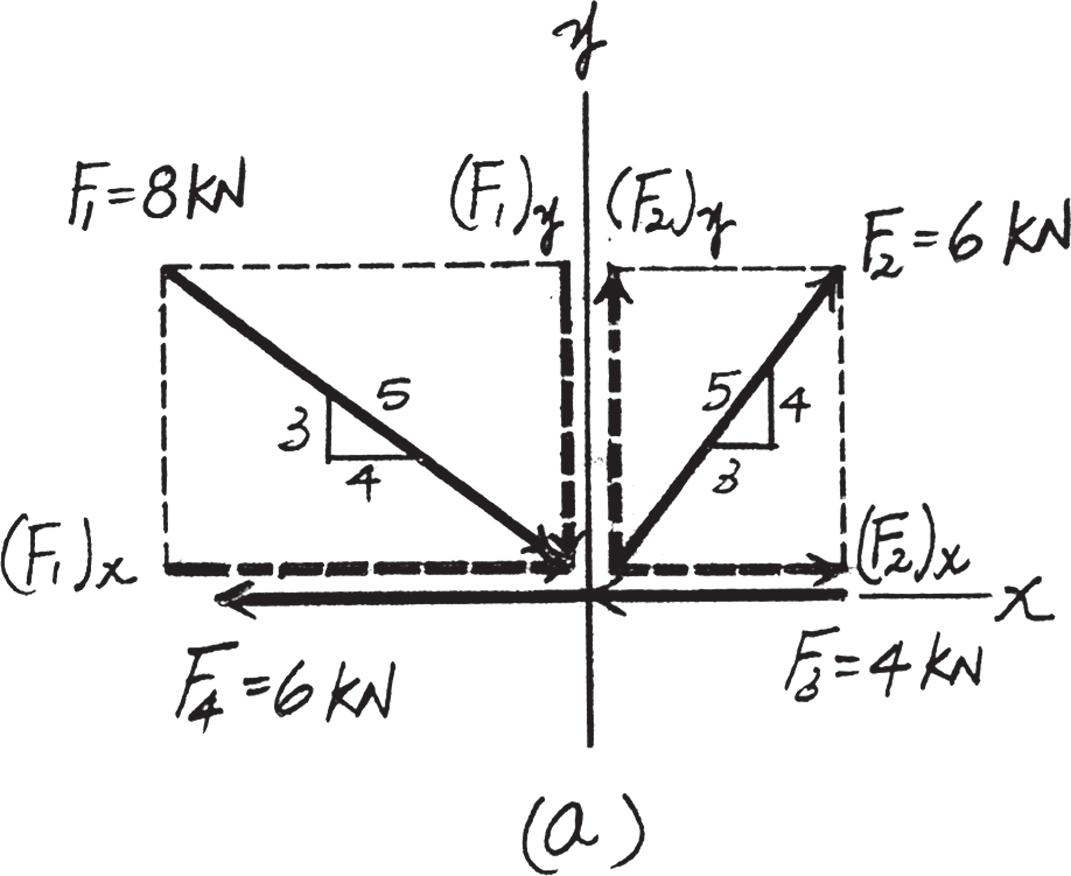
Ans.
Ans.
Ans.
Ans.
Ans.
Ans.
Ans.
Ans.
Ans:
(F1)x = 6.40 kN S
(F1)y = 4.80 kN T
(F2)x = 3.60 kN S
(F2)y = 4 80 kN c
(F3)x = 4 kN d
(F3)y = 0
(F4)x = 6 kN d
(F4)y = 0
2016 Pearson Education, Inc., Upper Saddle River, NJ. All rights reserved. This material is protected under all copyright laws as they currently exist. No portion of this material may be reproduced, in any form or by any means, without permission in writing from the publisher.
2–53.
Express and as Cartesian vectors. F2 F1
SOLUTION
2016 Pearson Education, Inc., Upper Saddle River, NJ. All rights reserved. This material is protected under all copyright laws as they currently exist. No portion of this material may be reproduced, in any form or by any means, without permission in writing from the publisher.
2–54.
Determine the magnitude of the resultant force and its direction measured counterclockwise from the positive x axis
SOLUTION
Ans. Ans.
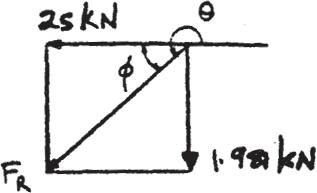
© 2016 Pearson Education, Inc., Upper Saddle River, NJ. All rights reserved. This material is protected under all copyright laws as they currently exist. No portion of this material may be reproduced, in any form or by any means, without permission in writing from the publisher.
2–55.
Determine the magnitude of force so that the resultant force of the three forces is as small as possible.What is the magnitude of the resultant force?
SOLUTION
4.1244 - F cos 45° FRz = 8 - F cos 45° - 14 cos 30° + : FRx =© Fx
= 7 - F sin 45° FRy =- F sin 45° + 14 sin 30° + c FRy =© Fy
2 = ( - 4.1244 - F cos 45°)2 + (7 - F sin
= 2.03 kN 2FR dFR dF = 2( - 4.1244 - F cos 45°)( - cos 45°) + 2(7 - F sin 45°)( - sin 45°) = 0



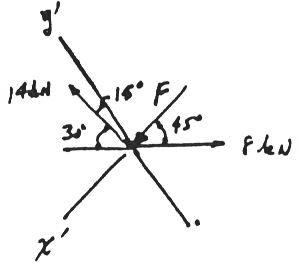
From Eq. (1); Ans.
= 7.87 kN
Also, from the figure require ; Ans. ;
+ 14 sin 15° - 8 cos 45° = 0 (FR)x¿ = 0 =© Fx
= 2.03 kN
= 7.87 kN
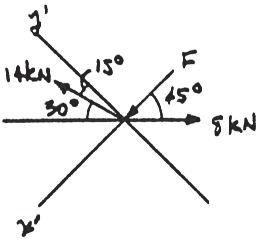
= 7.87 kN
© 2016 Pearson Education, Inc., Upper Saddle River, NJ. All rights reserved. This material is protected under all copyright laws as they currently exist. No portion of this material may be reproduced, in any form or by any means, without permission in writing from the publisher.
*2–56.
If the magnitude of the resultant force acting on the bracket is to be 450 N directed along the positive u axis, determine the magnitude of F1 and its direction f
SOLUTION
Rectangular Components: By referring to Fig. a, the x and y components of F1, F2, F3, and FR can be written as
F1)x = F1 sin f
F2)x = 200 F2)y = 0

Solving Eqs. (1) and (2), yields Ans. f = 10.9° F1 = 474 N F1 cos f = 465 + c © (FR)y =© Fy; 225 = F1 cos f - 240 F1 sin f = 89.71 : + © (FR)x =© Fx; 389.71 = F1 sin f + 200 + 100 (FR)x = 450 cos 30° = 389.71 N(FR)y = 450 sin 30° = 225 N (F3)x = 260 ¢ 5 13 ≤ = 100 N(F3)y = 260 ¢ 12 13 ≤ = 240 N
Resultant Force: Summing the force components algebraically along the x and y axes,
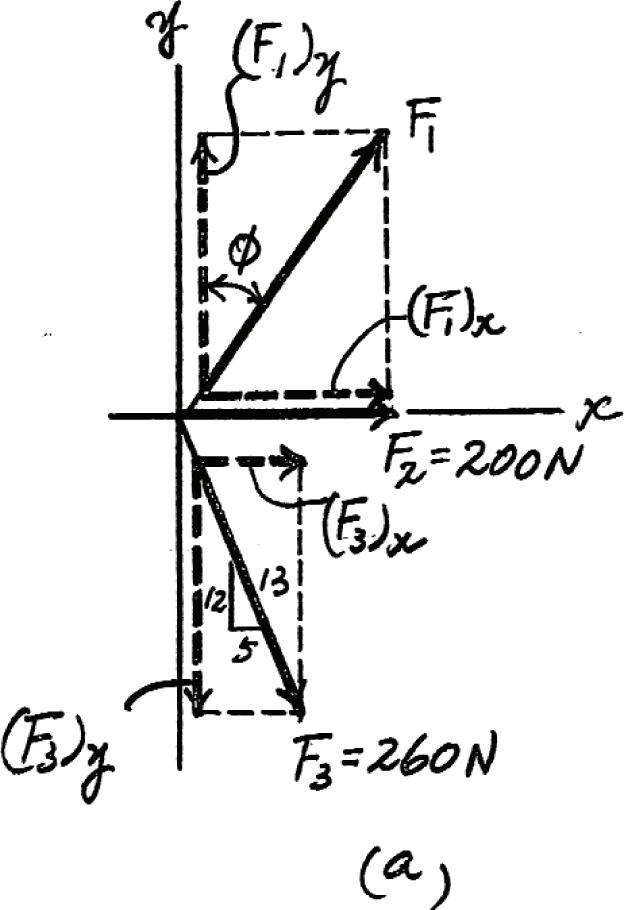
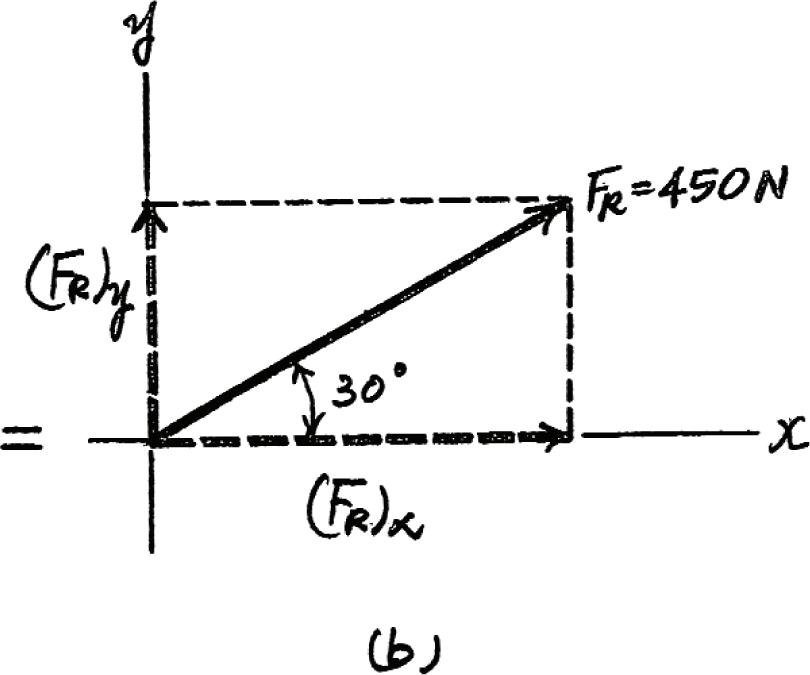
© 2016 Pearson Education, Inc., Upper Saddle River, NJ. All rights reserved. This material is protected under all copyright laws as they currently exist. No portion of this material may be reproduced, in any form or by any means, without permission in writing from the publisher.
2–57.
If the resultant force acting on the bracket is required to be a minimum, determine the magnitudes of F1 and the resultant force. Set f = 30°
SOLUTION
Rectangular Components: By referring to Fig. a, the x and y components of F1, F2, and F3 can be written as
(F1)x = F1 sin 30° = 0.5F1 (F1)y = F1 cos 30° = 0.8660F1
(F2)x = 200 N(F2)y = 0

Resultant Force: Summing the force components algebraically along the x and y axes,
FR = 2(FR)x 2 + (FR)y 2 + c © (FR)y =© Fy;(FR)y = 0.8660F1 - 240 : + © (FR)x =© Fx;(FR)x = 0.5F1 + 200 + 100 = 0.5F1 + 300 (F3)x = 260 a 5 13 b = 100 N (F3)y = 260 a 12 13 b = 240 N
The magnitude of the resultant force FR is (1)
Thus, (2)
The first derivative of Eq. (2) is (3) 2FR dFR dF1 = 2F1 - 115.69 FR 2 = F 1 2 - 115.69F1 + 147 600 = 2F 2 1 - 115.69F1 + 147 600 = 2(0.5F1 + 300)2 + (0.8660F1 - 240)2
2FR dFR dF1 = 2F1 - 115.69 = 0 dFR dF1 = 0
f rom Eq. (1),
For FR to be minimum, .Thus, from Eq. (3) Ans. Ans. F1 = 57.846 N = 57.8 N
FR = 2 (57.846)2 - 115.69(57.846) + 147 600 = 380 N
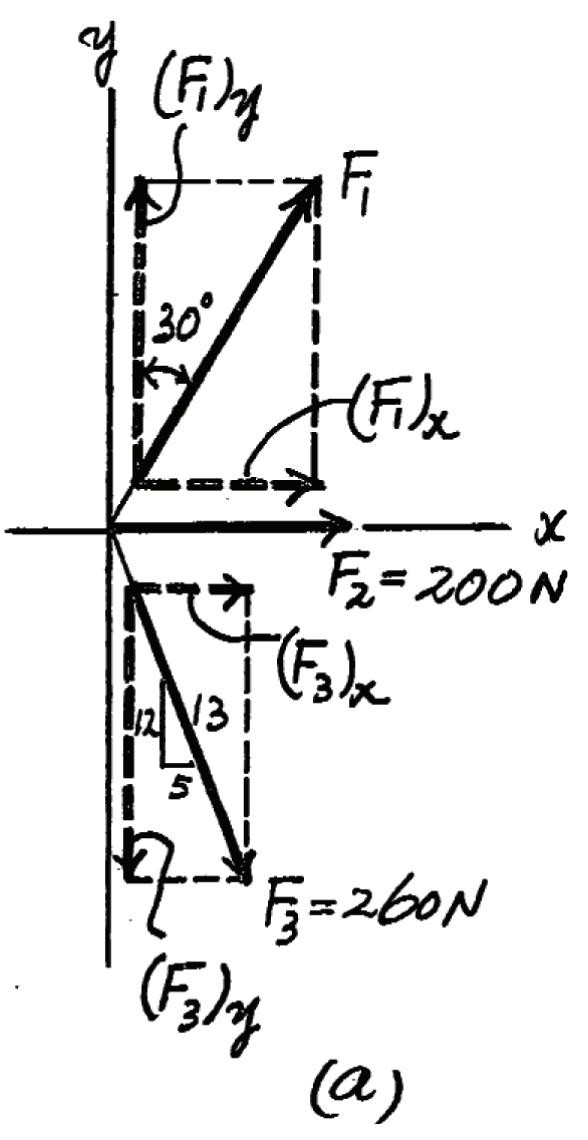
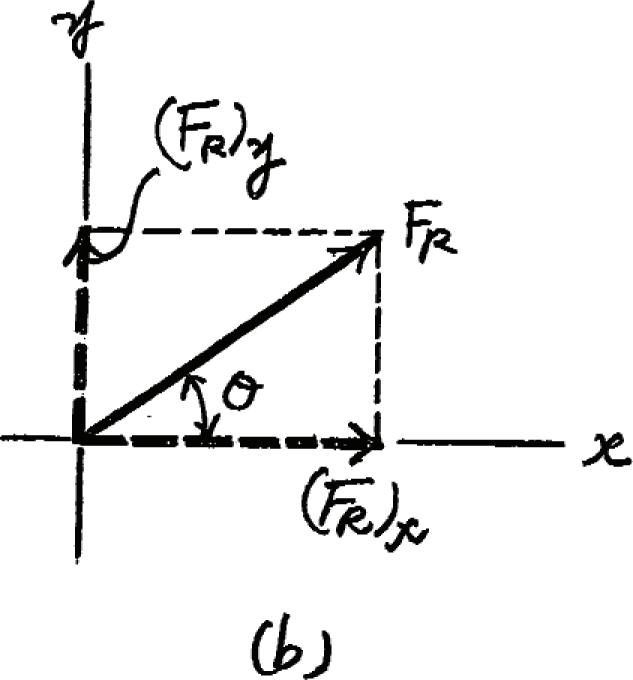
© 2016 Pearson Education, Inc., Upper Saddle River, NJ. All rights reserved. This material is protected under all copyright laws as they currently exist. No portion of this material may be reproduced, in any form or by any means, without permission in writing from the publisher.
2–58.
Three forces act on the bracket. Determine the magnitude and direction u of F so that the resultant force is directed along the positive x ′ axis and has a magnitude of 8 kN.
Solution
Scalar Notation. Equating the force components along the x and y axes algebraically by referring to Fig. a,
Divide Eq (1) by (2)
Substitute this result into Eq (1)
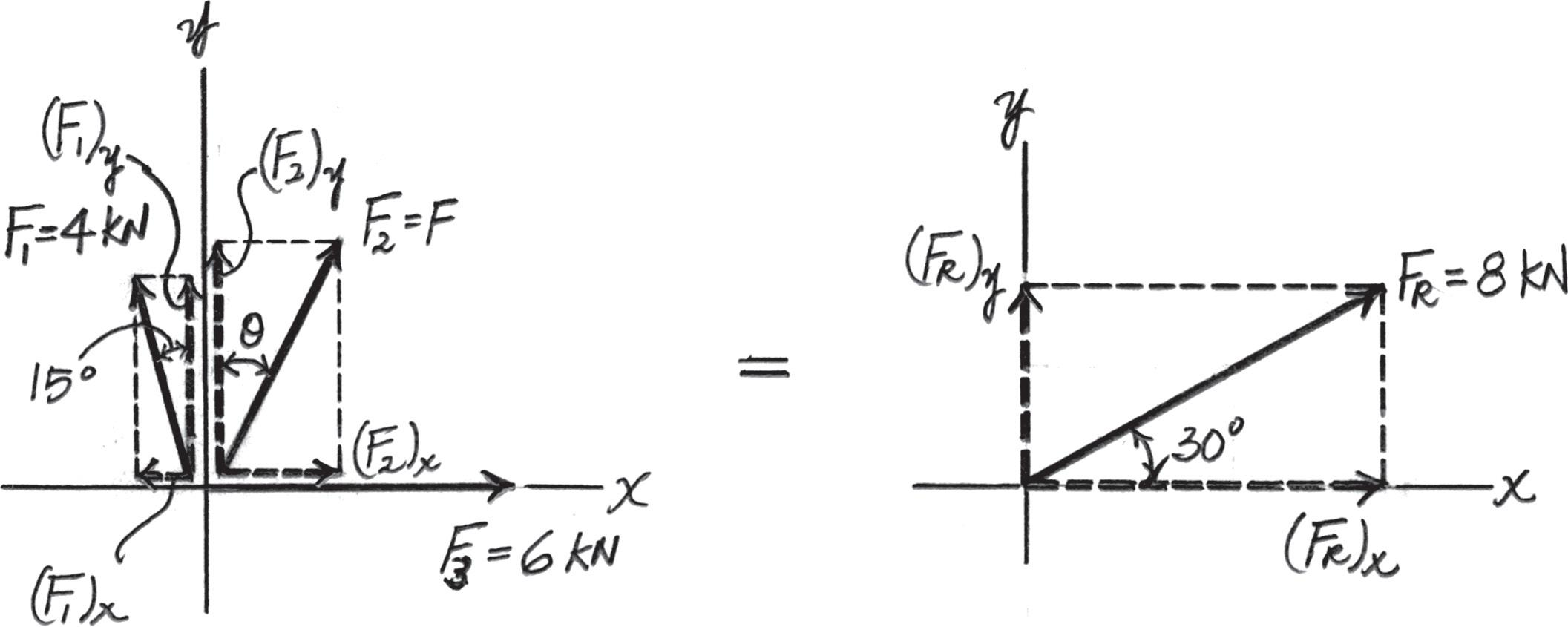
© 2016 Pearson Education, Inc., Upper Saddle River, NJ. All rights reserved. This material is protected under all copyright laws as they currently exist. No portion of this material may be reproduced, in any form or by any means, without permission in writing from the publisher.
2–59.
If F = 5 kN and u = 30°, determine the magnitude of the resultant force and its direction, measured counterclockwise from the positive x axis.
Solution
Scalar Notation. Summing the force components along x and y axes algebraically by referring to Fig. a,
S + (FR)x = Σ Fx; (FR)x = 5 sin 30° + 6 - 4 sin 15° = 7.465 kN S + c (FR)y = Σ Fy; (FR)y = 4 cos 15° + 5 cos 30° = 8.194 kN c
By referring to Fig. b, the magnitude of the resultant force is FR = 2(FR)2 x + (FR)2 y = 27.4652 + 8.1942 = 11.08 kN = 11.1 kN Ans.
And its directional angle u measured counterclockwise from the positive x axis is u = tan - 1 c (FR)y (FR)x d = tan - 1 a 8 194 7 465 b = 47 67° = 47 7° Ans.
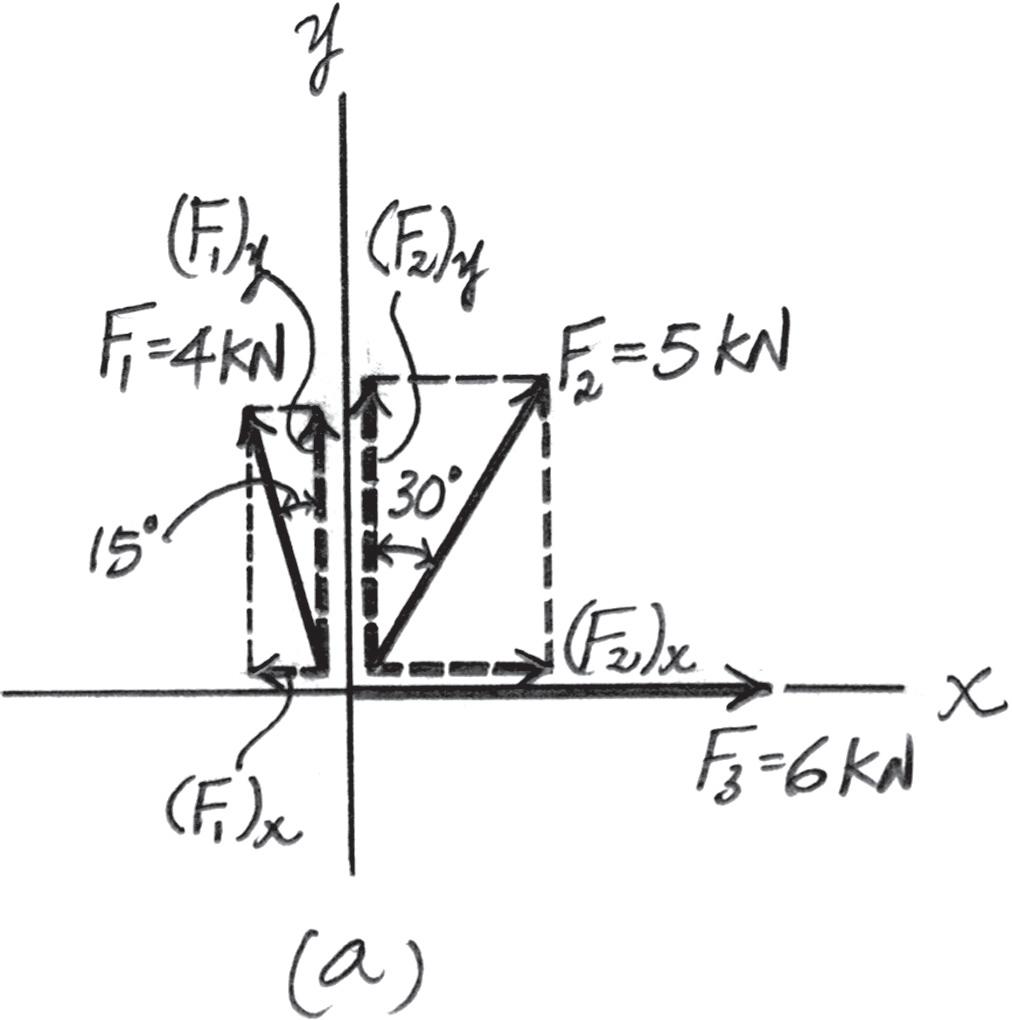
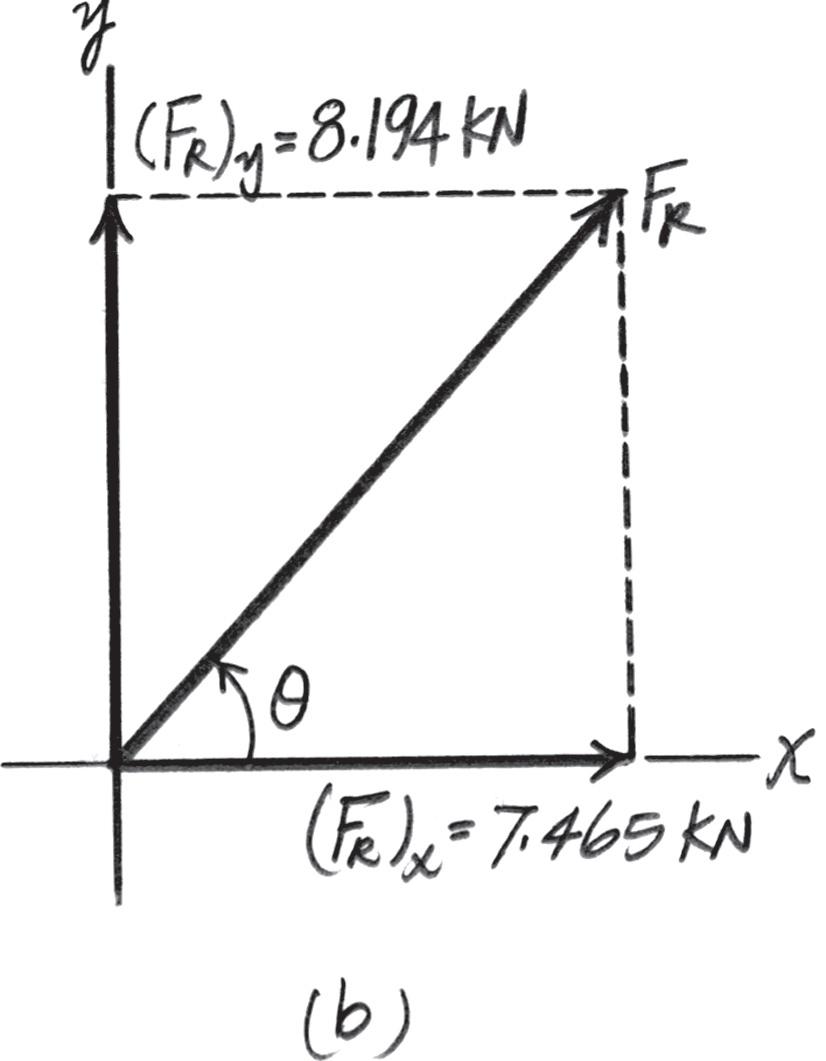
© 2016 Pearson Education, Inc., Upper Saddle River, NJ. All rights reserved. This material is protected under all copyright laws as they currently exist. No portion of this material may be reproduced, in any form or by any means, without permission in writing from the publisher.
*2–60.
The force F has a magnitude of 80 lb and acts w ithin th e o ctant shown. Determine the magnitudes of the x , y , z components of F .
SOLUTION
Solving for the positive root,
Fx = 80 cos 60° = 40.0 lb g = 60° 1 = cos2 60° + cos2 45° + cos2 g
Fy = 80 cos 45° = 56.6 lb
Fz = 80 cos 60° = 40.0 lb
© 2016 Pearson Education, Inc., Upper Saddle River, NJ. All rights reserved. This material is protected under all copyright laws as they currently exist. No portion of this material may be reproduced, in any form or by any means, without permission in writing from the publisher.
2–61.
The bolt is subjected to the force F,which has components acting along the x, y, z axes as shown. If the magnitude of F is 80 N, and and determine the magnitudes of its components g = 45°, a = 60°
SOLUTION
cos b = 21 - cos2 a - cos2g
b = 120° = 21 - cos2 60° - cos2 45°
Fx = |80 cos 60°| = 40 N
Fy = |80 cos 120°| = 40 N
Fz = |80 cos 45°| = 56.6 N
Ans.
Ans.
Ans.
© 2016 Pearson Education, Inc.,
Saddle River, NJ. All rights reserved. This material is protected under all copyright laws as they currently exist. No portion of this material may be reproduced, in any form or by any means, without permission in writing from the publisher.
2–62.
Determine the magnitude and coordinate direction angles of the force F acting on the support. The component of F in the x y plane is 7 kN.
Solution
Coordinate Direction Angles. The unit vector of F is
cos a = 0 6634; a =
cos b = - 0.5567; b = 123.83° = 124°
cos g = 0 5; g = 60° Ans.
The magnitude of F can be determined from F
© 2016 Pearson Education, Inc., Upper Saddle River, NJ. All rights reserved. This material is protected under all copyright laws as they currently exist. No portion of this material may be reproduced, in any form or by any means, without permission in writing from the publisher.
2–63.
Determine the magnitude and coordinate direction angles of the resultant force and sketch this vector on the coordinate system.
SOLUTION
F1 = {53.1i - 44.5j + 40k}lb F
F2 = { - 130k}lb
FR = F1 + F2
= 2(53.1)2 + ( - 44.5)2 + ( - 90.0)2 = 114 lb FR = {53.1i - 44.5j - 90.0k}lb
Ans. Ans. Ans. Ans.
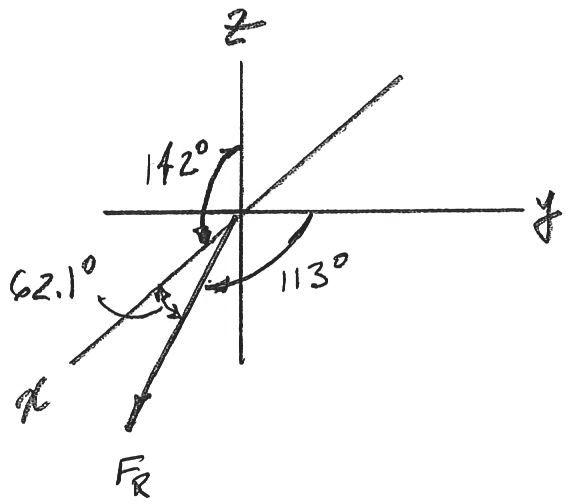
*2–64.
Specify the coordinate direction angles of and and express each force as a Cartesian vector F2 F1
SOLUTION
2016 Pearson Education, Inc., Upper Saddle River, NJ. All rights reserved. This material is protected under all copyright laws as they currently exist. No portion of this material may be reproduced, in any form or by any means, without permission in writing from the publisher.
2–65.
The screw eye is subjected to the two forces shown. Express each force in Cartesian vector form and then determine the resultant force.Find the magnitude and coordinate direction angles of the resultant force.
SOLUTION

FR = F1 + F2 = {250 i + 354 j - 250 k}N = {250.0 i + 353.55 j - 250.0k}N
cos a = 0.2988 a = 72.6° uFR = FR FR = 143.93i + 459.62j + 9.81k 481.73 = 0.2988i + 0.9541j + 0.02036k FR = 2
cos b = 0.9541 b = 17.4°
© 2016 Pearson Education, Inc., Upper Saddle River, NJ. All rights reserved. This material is protected under all copyright laws as they currently exist. No portion of this material may be reproduced, in any form or by any means, without permission in writing from the publisher.
Determine the coordinate direction angles of . F1
b 1 = cos - 1 (0.3536) = 69.3° a1 = cos - 1 ( - 0.3536) = 111° u1 = F1 300 =- 0.3536 i + 0.3536 j + 0.8660 k = { - 106 i + 106 j + 260 k}N = { - 106.07 i + 106.07 j + 259.81 k}N
2–66. SOLUTION Ans. Ans. Ans. g1 = cos - 1 (0.8660) = 30.0°

© 2016 Pearson Education, Inc., Upper Saddle River, NJ. All rights reserved. This material is protected under all copyright laws as they currently exist. No portion of this material may be reproduced, in any form or by any means, without permission in writing from the publisher.
2–67.
Determine the magnitude and coordinate direction angles of so that the resultant of the three forces acts along the positive y axis and has a magnitude of 600 lb
SOLUTION
sin 30° + F3 cos g FRy =© Fy ; 600 = 300 cos 30° cos 40° + F3 cos b FRx =© Fx ;0 =- 180 + 300 cos 30° sin 40° + F3 cos a
FRz =© Fz ;0 =-
a + cos2 b + cos2 g = 1
Solving:
Ans. Ans. Ans. Ans.
© 2016 Pearson Education, Inc., Upper Saddle River, NJ. All rights reserved. This material is protected under all copyright laws as they currently exist. No portion of this material may be reproduced, in any form or by any means, without permission in writing from the publisher.
*2–68.
Determine the magnitude and coordinate direction angles of so that the resultant of the three forces is zero F3
SOLUTION
Solving:
2016 Pearson Education, Inc., Upper Saddle River, NJ. All rights reserved. This material is protected under all copyright laws as they currently exist. No portion of this material may be reproduced, in any form or by any means, without permission in writing from the publisher.
2–69.
Determine the magnitude and coordinate direction angles of the resultant force, and sketch this vector on the coordinate system.
Solution
Cartesian Vector Notation. For F1 and F2,
=
c
Resultant Force.
The magnitude of the resultant force is
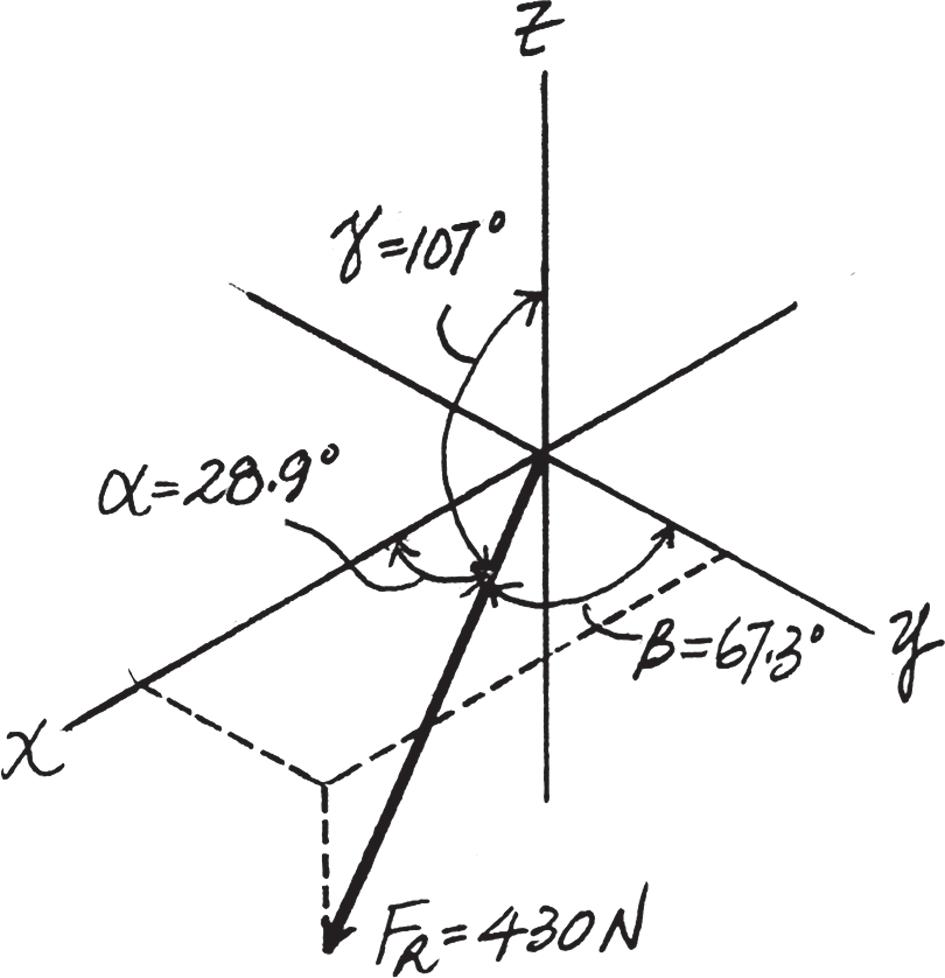
The coordinate direction angles are
© 2016 Pearson Education, Inc., Upper Saddle River, NJ. All rights reserved. This material is protected under all copyright laws as they currently exist. No portion of this material may be reproduced, in any form or by any means, without permission in writing from the publisher.
2–70.
Determine the magnitude and coordinate direction angles of the resultant force, and sketch this vector on the coordinate system.
Solution
Cartesian Vector Notation. For F1 and F2,
Resultant Force.
The magnitude of the resultant force is
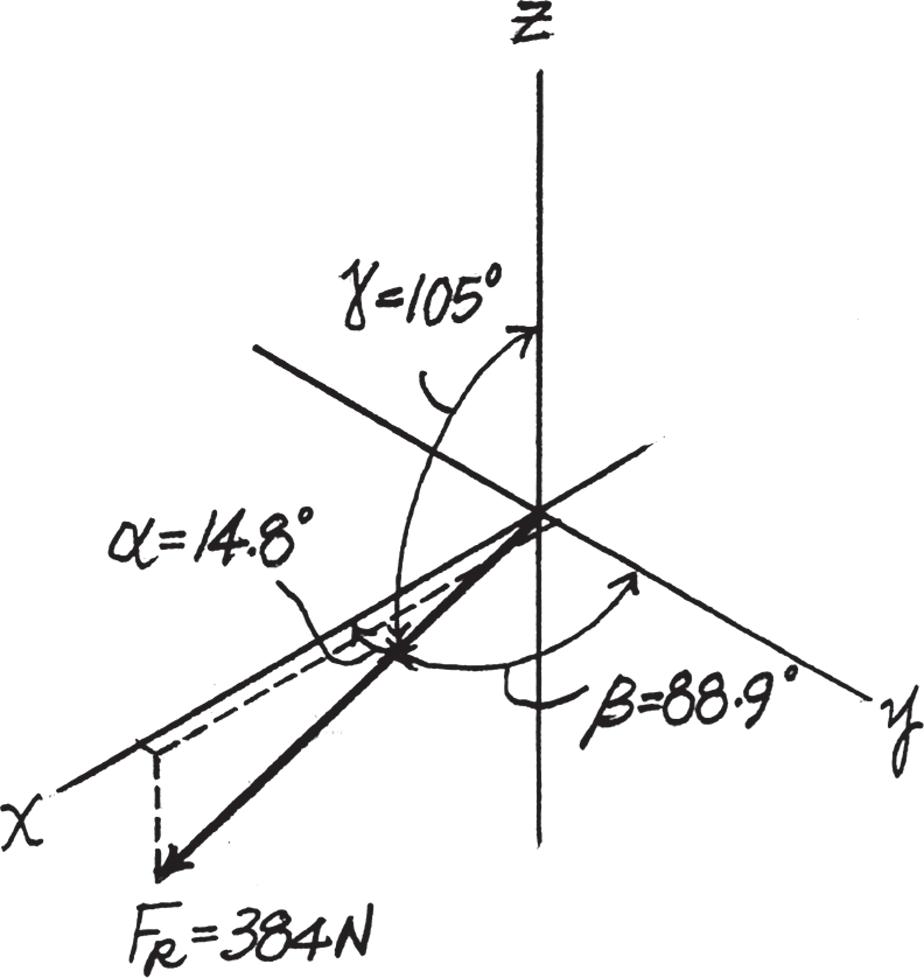
© 2016 Pearson Education, Inc., Upper Saddle River, NJ. All rights reserved. This material is protected under all copyright laws as they currently exist. No portion of this material may be reproduced, in any form or by any means, without permission in writing from the publisher.
2–71.
Specify the magnitude and coordinate direction angles , , of so that the resultant of the three forces acting on the bracket is Note that lies in the x–y plane F3 FR = 5 - 350k6 lb.
SOLUTION
F1 = Fx i + Fy j + Fz k
0 = Fx - 200 ; Fx = 200 lb - 350 k = Fx i + Fy j + Fz k - 200 j - 200 i + 346.4 j FR =© F
0 = Fy - 200 + 346.4 ; Fy =- 146.4 lb
Fz =- 350 lb
F1 = 2(200)2 + ( - 146.4)2 + ( - 350)2
F1 = 425.9 lb = 429 lb
Ans. Ans. Ans. Ans. g1 = cos - 1 - 350
= 145°
© 2016 Pearson Education, Inc., Upper Saddle River, NJ. All rights reserved. This material is protected under all copyright laws as they currently exist. No portion of this material may be reproduced, in any form or by any means, without permission in writing from the publisher.
Two forces F1 and F2 act on the screw eye. If the resultant force FR has a magnitude of 150 lb and the coordinate direction angles shown, determine the magnitude of F2 and its coordinate direction angles.
Solution
Cartesian Vector Notation. For FR, g can be determined from cos2 a + cos2 b + cos2 g = 1 cos2 120° + cos2 50° + cos2 g = 1 cos g = { 0.5804
Here g 6 90° , then g = 54 52° Thus
= {80j} lb
Resultant Force.
R = F1 + F2 { - 75 0i + 96 42j + 87 05k} = {80j} + F2 F2 = { - 75 0i + 16 42j + 87 05k} lb
Thus, the magnitude of F2 is F2 = 2(F2)x + (F2)y + (F2)z = 2( - 75 0)2 + 16 422 +
And its coordinate direction angles are
cos b2 = (F2)y F2 = 16 42 116 07 ; b2 = 81 87° = 81 9°
cos g2 = (F2)z F2 = 87 05 116 07 ; g2 = 41 41° = 41 4°
© 2016 Pearson Education, Inc., Upper Saddle River, NJ. All rights reserved. This material is protected under all copyright laws as they currently exist. No portion of this material may be reproduced, in any form or by any means, without permission in writing from the publisher.
2–73.
Express each force in Cartesian vector form.
Solution
Cartesian Vector Notation. For F1, F2 and F3,
F1 = 90 a 4 5 i + 3 5 k b = {72.0i + 54.0k} N
F2 = 150 (cos 60° sin 45°i + cos 60° cos 45°j + sin 60°k)
= {53 03i + 53 03j + 129 90k} N
Ans.
= {53 0i + 53 0j + 130k} N Ans.
F3 = {200 k} Ans. x
© 2016 Pearson Education, Inc., Upper Saddle River, NJ. All rights reserved. This material is protected under all copyright laws as they currently exist. No portion of this material may be reproduced, in any form or by any means, without permission in writing from the publisher.
2–74.
Determine the magnitude and coordinate direction angles of the resultant force, and sketch this vector on the coordinate system.
Solution
Cartesian Vector Notation. For F1, F2 and F3,
F1 = 90 a 4 5 i + 3 5 k b = {72.0i + 54.0k} N
F2 = 150 (cos 60° sin 45°i + cos 60° cos 45°j + sin 60° k)
= {53 03i + 53 03j + 129 90k} N
F3 = {200 k} N
Resultant Force.
F = F1 + F2 + F3
= (72 0i + 54 0k) + (53 03i + 53 03j + 129 90k) + (200k)
= {125 03i + 53 03j + 383 90} N
The magnitude of the resultant force is FR = 2(FR)2 x + (FR)2 y + (FR)2 z = 2125 032 + 53 032 + 383 902 = 407 22 N = 407 N
And the coordinate direction angles are cos a = (FR)x FR = 125.03 407.22 ; a = 72.12° = 72.1°
cos b = (FR)y FR = 53.03 407 22 ; b = 82 52° = 82 5°
cos g = (FR)z FR = 383 90 407 22 ; g = 19 48° = 19 5°
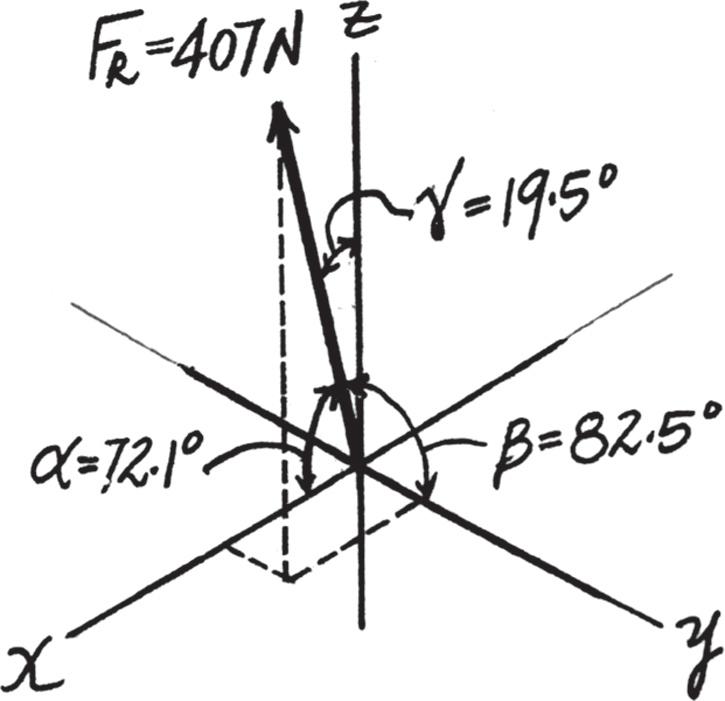
2016 Pearson Education, Inc., Upper Saddle River, NJ. All rights reserved. This material is protected under all copyright laws as they currently exist. No portion of this material may be reproduced, in any form or by any means, without permission in writing from the publisher.
2–75.
The spur gear is subjected to the two forces caused by contact with other gears Express each force as a Cartesian vector.
SOLUTION
2016 Pearson Education, Inc., Upper Saddle River, NJ. All rights reserved. This material is protected under all copyright laws as they currently exist. No portion of this material may be reproduced, in any form or by any means, without permission in writing from the publisher.
*2–76.
The spur gear is subjected to the two forces caused by contact with other gears Determine the resultant of the two forces and express the result as a Cartesian vector
SOLUTION
2016 Pearson Education, Inc., Upper Saddle River, NJ. All rights reserved. This material is protected under all copyright laws as they currently exist. No portion of this material may be reproduced, in any form or by any means, without permission in writing from the publisher.
2–77.
Determine the magnitude and coordinate direction angles of the resultant force, and sketch this vector on the coordinate system.
Solution
Cartesian Vector Notation. For F1 and F2,
F1 = 400 (sin 60° cos 20°i - sin 60° sin 20°j + cos 60° k)
= {325 52i - 118 48j + 200k} N
F2 = 500 (cos 60°i + cos 60°j + cos 135° k)
= {250i + 250j - 353 55k} N
Resultant Force.
FR = F1 + F2
= (325 52i - 118 48j + 200k) + (250i + 250j - 353 55k)
= {575 52i + 131 52j - 153 55 k} N
The magnitude of the resultant force is
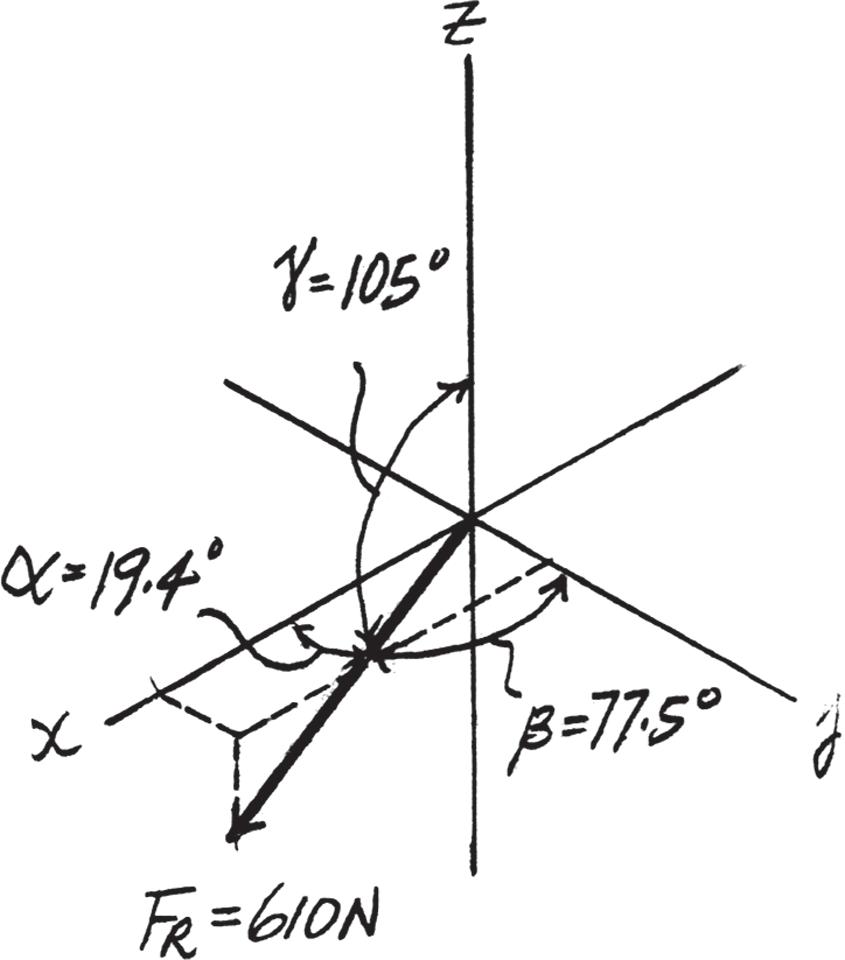
The coordinate direction angles are
a = (FR)x FR = 575 52 610 00 a = 19 36° = 19 4°
b = (FR)y FR = 131 52 610 00 b = 77 549° = 77 5°
2–78.
The two forces F1 and F2 acting at A have a resultant force of FR = 5 - 100k 6 lb. Determine the magnitude and coordinate direction angles of F2
SOLUTION
Cartesian Vector Notation: FR = 5 - 100 k 6 lb
2 = 5 F2x i + F2y j + F2z k 6 lb
Resultant Force:
Equating i, j and k components, we have
The magnitude of force F2 is
The coordinate direction angles for F
© 2016 Pearson Education, Inc., Upper Saddle River, NJ. All rights reserved. This material is protected under all copyright laws as they currently exist. No portion of this material may be reproduced, in any form or by any means, without permission in writing from the publisher.
2–79.
Determine the coordinate direction angles of the force F1 and indicate them on the gure.
SOLUTION
Unit Vector For Force F1:
u
= - 0.5567 i + 0.3214 j - 0.7660 k
Coordinate Direction Angles: From the unit vector obtained above, we have
cos a = - 0.5567 a = 124° Ans.
cos b = 0.3214 b = 71.3° Ans.
cos g = - 0.7660 g = 140° Ans.
2016 Pearson Education, Inc., Upper Saddle River, NJ. All rights reserved. This material is protected under all copyright laws as they currently exist. No portion of this material may be reproduced, in any form or by any means, without permission in writing from the publisher.
*2–80.
The bracket is subjected to the two forces shown. Express each force in Cartesian vector form and then determine the resultant force Find the magnitude and coordinate direction angles of the resultant force. FR
SOLUTION
Cartesian Vector Notation:
F2 = 4005cos 120°i + cos 45°j + cos 60°k6 N = 586.5i + 186j - 143k6 N = 586.55i + 185.60j - 143.39k6 N F1 = 2505cos 35° sin 25°i + cos 35° cos 25°j - sin 35°k6 N
= 5 - 200.0i + 282.84j + 200.0k6 N
5 - 200i + 283j + 200k6 N
Resultant Force:
R = F1 + F2
The magnitude of the resultant force is
The coordinate direction angles are

© 2016 Pearson Education, Inc., Upper Saddle River, NJ. All rights reserved. This material is protected under all copyright laws as they currently exist. No portion of this material may be reproduced, in any form or by any means, without permission in writing from the publisher.
2–81.
b 3 = 60° a3 = 120° F3
If the coordinate direction angles for are , and , determine the magnitude and coordinate direction angles of the resultant force acting on the eyebolt. g3 = 45°
SOLUTION
Force Vectors: By resolving , and into their x, y, and z components, as shown in Figs. a, b, and c,respectively,, and can be expressed in Cartesian vector form as
F1 = 700 cos 30°( + i) + 700 sin 30°( + j) = 5606.22i + 350j6 lb
Resultant Force: By adding , and vectorally, we obtain .Thus,
= 3(FR)x 2 + (FR)y 2 + (FR)z 2 FR = 3206.22i + 1230 j + 925.69 k4 lb = (606.22i + 350j) + (480j + 360k) + ()
The magnitude of is Ans.
The coordinate direction angles of are Ans. Ans.
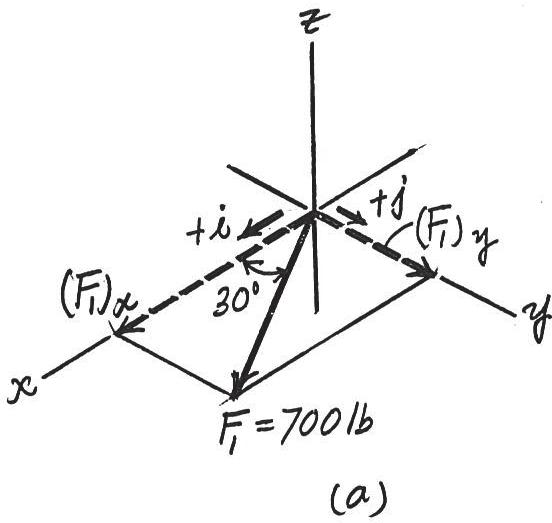
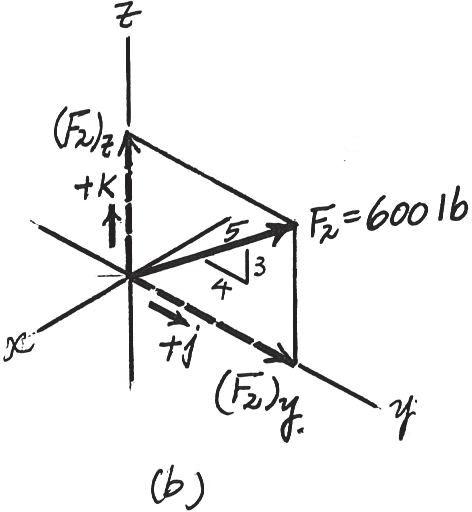
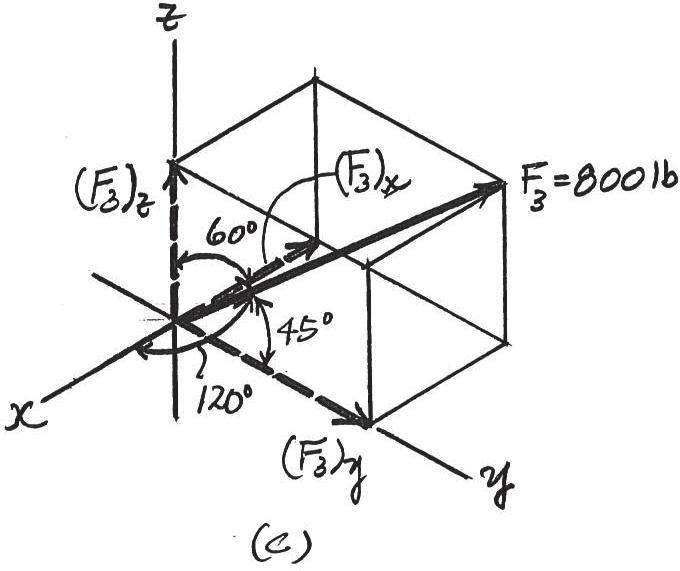
© 2016 Pearson Education, Inc., Upper Saddle River, NJ. All rights reserved. This material is protected under all copyright laws as they currently exist. No portion of this material may be reproduced, in any form or by any means, without permission in writing from the publisher.
2–82.
If the coordinate direction angles for are , and , determine the magnitude and coordinate direction angles of the resultant force acting on the eyebolt. g3 = 60° b 3 = 45°
SOLUTION
Force Vectors: By resolving , and into their x, y, and z components, as shown in Figs a, b, and c,respectively,,, and can be expressed in Cartesian vector form as

Ans. Ans. Ans. Ans.


© 2016 Pearson Education, Inc., Upper Saddle River, NJ. All rights reserved. This material is protected under all copyright laws as they currently exist. No portion of this material may be reproduced, in any form or by any means, without permission in writing from the publisher.
2–83.
If the direction of the resultant force acting on the eyebolt is defined by the unit vector , determine the coordinate direction angles of and the magnitude of . FR F3 uFR = cos 30°j + sin 30°k
SOLUTION
Force Vectors: By resolving , and into their x, y, and z components, as shown in Figs. a, b, and c,respectively,,, and can be expressed in Cartesian vector form as
3 F2 F1
F3 = 800 cos a3i + 800 cos b 3 j + 800 cos g3k F2 = 0i + 600 a 4 5 b (
Since the direction of is defined by , it can be written in Cartesian vector form as
Resultant Force: By adding ,, and vectorally, we obtain .Thus,
0.8660FR j + 0.5FR k = (606.22 + 800 cos a3)i + (350 + 480 + 800 cos b 3)j + (360 + 800 cos g3)k
Equating the ,, and components, we have k j i
0 = 606.22 + 800 cos a3
800 cos a3 =- 606.22
0.8660FR = 350 + 480 + 800 cos b 3
800 cos b 3 = 0.8660FR - 830
0.5FR = 360 + 800 cos g3


800 cos g3 = 0.5FR - 360
0.8660FR j + 0.5FR k = (606.22i + 350j) + (480j + 360k) + (800 cos a3i + 800 cos b 3 j + 800 cos g3k) (1) (2) (3)
Squaring and then adding Eqs. (1), (2), and (3), yields (4)
8002 [cos2 a3 + cos2 b 3 + cos2 g3] = FR 2 - 1797.60FR + 1,186,000
However, .Thus, from Eq. (4)
FR 2 - 1797.60FR + 546,000 = 0 cos2 a3 + cos2 b 3 + cos2 g3 = 1
Solving the above quadratic equation, we have two positive roots
FR = 387.09 N = 387 N
FR = 1410.51 N = 1.41 kN
From Eq. (1),
a3 = 139°
FR = 387.09 N
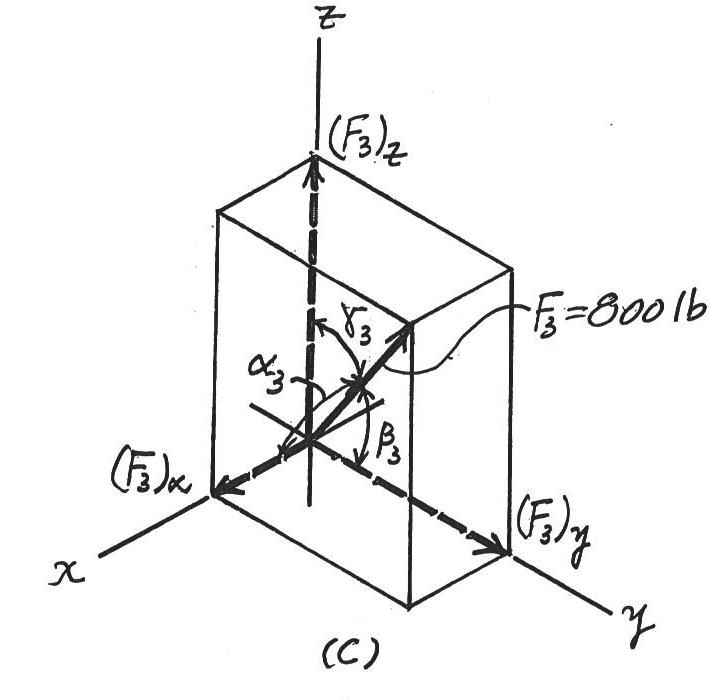
Ans.
Ans.
Ans.
Substituting into Eqs. (2), and (3), yields Ans.
FR = 1410.51 N g3 = 102° b 3 = 128°
Substituting into Eqs. (2), and (3), yields Ans. g3 = 64.4° b 3 = 60.7°
=
© 2016 Pearson Education, Inc., Upper Saddle River, NJ. All rights reserved. This material is protected under all copyright laws as they currently exist. No portion of this material may be reproduced, in any form or by any means, without permission in writing from the publisher.
*2–84.
The pole is subjected to the force F, which has components acting along the x, y, z axes as shown. If the magnitude of F is 3 kN,, and , determine the magnitudes of its three components g = 75° b = 30°
SOLUTION
cos2 a + cos2 b + cos2 g = 1
cos2 a + cos2 30° + cos2 75° = 1
Fx = 3 cos 64.67° = 1.28 kN a = 64.67°
Fy = 3 cos 30° = 2.60 kN
Fz = 3 cos 75° = 0.776 kN
Ans. Ans.
Ans.
© 2016 Pearson Education, Inc., Upper Saddle River, NJ. All rights reserved. This material is protected under all copyright laws as they currently exist. No portion of this material may be reproduced, in any form or by any means, without permission in writing from the publisher.
2–85.
The pole is subjected to the force F which has components and If , determine the magnitudes of F and F y b = 75° Fz = 1.25 kN Fx = 1.5 kN
SOLUTION
© 2016 Pearson Education, Inc., Upper Saddle River, NJ. All rights reserved. This material is protected under all copyright laws as they currently exist. No portion of this material may be reproduced, in any form or by any means, without permission in writing from the publisher.
2–86.
Determine the length of the connecting rod AB by first formulating a Cartesian position vector from A to B and then determining its magnitude.
Solution
Position Vector. The coordinates of points A and B are A( - 150 cos 30° , - 150 sin 30°) mm and B(0, 300) mm respectively. Then
rAB = [0 - ( - 150 cos 30°)]i + [300 - ( - 150 sin 30°)]j = {129.90i + 375j} mm
Thus, the magnitude of rAB is
rAB = 2129 902 + 3752 = 396 86 mm = 397 mm
© 2016 Pearson Education, Inc., Upper Saddle River, NJ. All rights reserved. This material is protected under all copyright laws as they currently exist. No portion of this material may be reproduced, in any form or by any means, without permission in writing from the publisher.
2–87.
Express force F as a Cartesian vector; then determine its coordinate direction angles.
Solution
rAB = (5 + 10 cos 70° sin 30°)i + ( - 7 - 10 cos 70° cos 30°)j - 10 sin 70°k
rAB = {6 710i - 9 962j - 9 397k} ft
rAB = 2(6 710)2 + ( - 9 962)2 + ( - 9 397)2 = 15 25
u AB = rAB rAB = (0 4400i - 0 6532j - 0 6162 k)
F = 135u AB = (59 40i - 88 18j - 83 18k) = {59 4i - 88 2j - 83 2k} lb Ans.
a = cos - 1 a 59 40 135 b = 63 9° Ans. b = cos - 1 a - 88 18 135 b = 131°
g = cos - 1 a - 83 18 135 b = 128° Ans. Ans: {59 4i - 88 2j - 83 2k} lb a = 63 9° b = 131° g = 128° F 135 lb 70 30
2016 Pearson Education, Inc., Upper Saddle River, NJ. All rights reserved. This material is protected under all copyright laws as they currently exist. No portion of this material may be reproduced, in any form or by any means, without permission in writing from the publisher.
*2–88.
Express each of the forces in Cartesian vector form and determine the magnitude and coordinate direction angles of the resultant force.
Solution
r
rAB = {2 i - 4 j - 6 k} ft
© 2016 Pearson Education, Inc., Upper Saddle River, NJ. All rights reserved. This material is protected under all copyright laws as they currently exist. No portion of this material may be reproduced, in any form or by any means, without permission in writing from the publisher.
2–89.
If and cable is 9 m long, determine the coordinates of point .A x, y, z AB F = 5350i - 250j - 450k6 N
SOLUTION
Position Vector: The position vector , directed from point to point ,is given by
Unit Vector: Knowing the magnitude of is 9 m, the unit vector for is given by
AB = rAB rAB = xi - yj - zk 9
The unit vector for force is
F = F F = 350i - 250j - 450k 3502 + ( - 250)2 + ( - 450)2 = 0.5623i - 0.4016j - 0.7229k
Since force is also directed from point to point , then
Equating the ,, and components,
Ans. Ans. Ans.
© 2016 Pearson Education, Inc., Upper Saddle River, NJ. All rights reserved. This material is protected under all copyright laws as they currently exist. No portion of this material may be reproduced, in any form or by any means, without permission in writing from the publisher.
2–90.
The 8-m-long cable is anchored to the ground at A If x = 4 m and y = 2 m, determine the coordinate z to the highest point of attachment along the column.
Solution
r = {4i + 2j + zk} m
r = 2(4)2 + (2)2 + (z)2 = 8
z = 6 63 m Ans.
© 2016 Pearson Education, Inc., Upper Saddle River, NJ. All rights reserved. This material is protected under all copyright laws as they currently exist. No portion of this material may be reproduced, in any form or by any means, without permission in writing from the publisher.
2–91.
The 8-m-long cable is anchored to the ground at A If z = 5 m, determine the location + x, + y of point A. Choose a value such that x = y.
Solution
r = {xi + yj + 5k} m
r = 2(x)2 + (y)2 + (5)2 = 8
x = y, thus
2x2 = 82 - 52
x = y = 4 42 m Ans.
4.42 m x z z y x y A B
© 2016 Pearson Education, Inc., Upper Saddle River, NJ. All rights reserved. This material is protected under all copyright laws as they currently exist. No portion of this material may be reproduced, in any form or by any means, without permission in writing from the publisher.
*2–92.
Express each of the forces in Cartesian vector form and determine the magnitude and coordinate direction angles of the resultant force.
Solution
Unit Vectors. The coordinates for points A, B and C are (0, - 0 75, 3) m, B(2 cos 40° , 2 sin 40° , 0) m and C(2, - 1, 0) m respectively.
u AB =
rAB rAB = (2 cos 40° - 0)i + [2 sin 40° - ( - 0 75)]j + (0 - 3)k 2(2 cos 40° - 0)2 + [2 sin 40° - ( - 0.75)]2 + (0 - 3)2
= 0 3893i + 0 5172j - 0 7622k
u AC =
rAC
rAC = (2 - 0)i + [ - 1 - ( - 0.75)]j + (0 - 3)k
2(2 - 0)2 + [ - 1 - ( - 0 75)]2 + (0 - 3)2
= 0 5534i - 0 0692j - 0 8301k
Force Vectors
FAB = FAB u AB = 250 (0 3893i + 0 5172j - 0 7622 k)
= {97 32i + 129 30j - 190 56k} N = {97 3i + 129j - 191k} N
FAC = FAC u AC = 400 (0.5534i - 0.06917j - 0.8301 k) = {221.35i - 27.67j - 332.02k} N = {221i - 27 7j - 332k} N
Resultant Force
FR = FAB + FAC
= {97 32i + 129 30j - 190 56k} + {221 35i - 27 67j - 332 02k} = {318 67i + 101 63j - 522 58 k} N
The magnitude of FR is
FR = 2(FR)2 x + (FR)2 y + (FR)2 z = 2318 672 + 101 632 + ( - 522 58)2 = 620 46 N = 620 N
And its coordinate direction angles are
cos a = (FR)x FR = 318 67 620 46 ; a = 59 10° = 59 1°
cos b = (FR)y FR = 101 63 620 46 ; b = 80 57° = 80 6°
Ans.
Ans.
Ans.
Ans.
cos g = (FR)z FR = - 522 58 620 46 ; g = 147 38° = 147° Ans.
Ans:
FAB = {97 3i - 129j - 191k} N
FAC = {221i - 27 7j - 332k} N FR = 620 N
cos a = 59 1°
cos b = 80 6°
cos g = 147°
2016 Pearson Education, Inc., Upper Saddle River, NJ. All rights reserved. This material is protected under all copyright laws as they currently exist. No portion of this material may be reproduced, in any form or by any means, without permission in writing from the publisher.
2–93.
N 560 N
If and , determine the magnitude and coordinate direction angles of the resultant force acting on the flag pole
SOLUTION
Force Vectors: The unit vectors and of and must be determined first. From Fig. a


Thus, the force vectors and are given by
Resultant Force: The magnitude of is
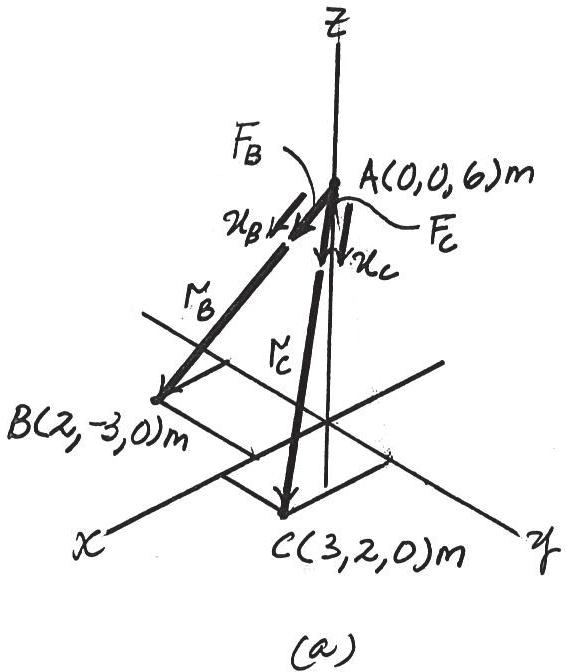
2016 Pearson Education, Inc., Upper Saddle River, NJ. All rights reserved. This material is protected under all copyright laws as they currently exist. No portion of this material may be reproduced, in any form or by any means, without permission in writing from the publisher.
2–94.
N 700 N
If , and , determine the magnitude and coordinate direction angles of the resultant force acting on the flag pole
SOLUTION
Force Vectors: The unit vectors and of and must be determined first. From Fig. a


Thus, the force vectors and are given by
Resultant

© 2016 Pearson Education, Inc., Upper Saddle River, NJ. All rights reserved. This material is protected under all copyright laws as they currently exist. No portion of this material may be reproduced, in any form or by any means, without permission in writing from the publisher.
2–95.
The plate is suspended using the three cables which exert the forces shown. Express each force as a Cartesian vector.
Solution
© 2016 Pearson Education, Inc., Upper Saddle River, NJ. All rights reserved. This material is protected under all copyright laws as they currently exist. No portion of this material may be reproduced, in any form or by any means, without permission in writing from the publisher.
*2–96.
The three supporting cables exert the forces shown on the sign. Represent each force as a Cartesian vector.
Solution
rC = (0 - 5)i + ( - 2 - 0)j + (3 - 0)k = { - 5i - 2j + 3k} m
rC = 2( - 5)2 + ( - 2)2 + 32 = 238 m
rB = (0 - 5)i + (2 - 0)j + (3 - 0)k = { - 5i + 2j + 3k} m
rB = 2( - 5)2 + 22 + 32 = 238 m
rE = (0 - 2)i + (0 - 0)j + (3 - 0)k = { - 2i + 0j + 3k} m
rE = 2( - 2)2 + 02 + 32 = 213 m
F = Fu = F a r r b
FC = 400 a - 5i - 2j + 3k 138 b = { - 324i - 130j + 195k} N
FB = 400 a - 5i + 2j + 3k 138 b = { - 324i + 130j + 195k} N
FE = 350 a - 2i + 0j + 3k 113 b = { - 194i + 291k} N
Ans.
Ans.
Ans.
© 2016 Pearson Education, Inc., Upper Saddle River, NJ. All rights reserved. This material is protected under all copyright laws as they currently exist. No portion of this material may be reproduced, in any form or by any means, without permission in writing from the publisher.
2–97.
Determine the magnitude and coordinate direction angles of the resultant force of the two forces acting on the sign at point A.
Solution
rC = (0 - 5)i + ( - 2 - 0)j + (3 - 0)k = { - 5i - 2j + 3k}
rC = 2( - 5)2 + ( - 2)2 + (3)2 = 238 m
FC = 400 a rC rC b = 400 a ( - 5i - 2j + 3k) 138 b
FC = ( - 324.4428i - 129.777j + 194.666k)
rB = (0 - 5)i + (2 - 0)j + (3 - 0)k = { - 5i + 2j + 3k}
rB = 2( - 5)2 + 22 + 32 = 238 m
FB = 400 a rB rB b = 400 a ( - 5i + 2j + 3k) 138 b
FB = ( - 324 443i + 129 777j + 194 666k)
FR = FC + FB = ( - 648 89i + 389 33k)
FR = 2( - 648 89)2 + (389 33)2 + 02 = 756 7242
FR = 757 N
a = cos - 1 a - 648 89 756 7242 b = 149 03 = 149°
b = cos - 1 a 0 756 7242 b = 90 0°
g = cos - 1 a 389.33 756.7242 b = 59.036 = 59.0°
Ans.
Ans.
Ans.
Ans.
© 2016 Pearson Education, Inc., Upper Saddle River, NJ. All rights reserved. This material is protected under all copyright laws as they currently exist. No portion of this material may be reproduced, in any form or by any means, without permission in writing from the publisher.
2–98.
The force F has a magnitude of 80 lb and acts at the midpoint C of the thin rod. Express the force as a Cartesian vector.
Solution
rAB = ( - 3i + 2j + 6k)
rCB = 1 2 rAB = ( - 1.5i + 1j + 3k)
rCO = rBO + rCB
= - 6k - 1 5i + 1j + 3k
= - 1 5i + 1j - 3k
= 3.5
© 2016 Pearson Education, Inc., Upper Saddle River, NJ. All rights reserved. This material is protected under all copyright laws as they currently exist. No portion of this material may be reproduced, in any form or by any means, without permission in writing from the publisher.
2–99.
60 lb A
The load at creates a force of in wire .Express this force as a Cartesian vector acting on and directed toward as shown. B A
SOLUTION
Unit Vector: First determine the position vector .The coordinates of point are
B (5 sin 30°, 5 cos 30°, 0) ft = B (2.50, 4.330, 0) ft
Then
rAB = 5(2.50 - 0)i + (4.330 - 0)j + [0 - ( - 10)]k6 ft
rAB = 32.502 + 4.3302 + 10.02 = 11.180 ft = 52.50i + 4.330j + 10k6 ft
uAB = rAB rAB = 2.50i + 4.330j + 10k 11.180
Force Vector:
F = FuAB = 60 50.2236i + 0.3873j + 0.8944k6 lb = 0.2236i + 0.3873j + 0.8944k
Ans. = 513.4i + 23.2j + 53.7k6 lb

© 2016 Pearson Education, Inc., Upper Saddle River, NJ. All rights reserved. This material is protected under all copyright laws as they currently exist. No portion of this material may be reproduced, in any form or by any means, without permission in writing from the publisher.
*2–100.
Determine the magnitude and coordinate direction angles of the resultant force acting at point A on the post.
Solution
Unit Vector. The coordinates for points A, B and C are A(0, 0, 3) m, B(2, 4, 0) m and C( - 3, - 4, 0) m respectively
rAB = (2 - 0)i + (4 - 0)j + (0 - 3)k = {2i + 4j - 3k} m
u AB = rAB rAB = 2i + 4j - 3k 222 + 42 + ( - 3)2 = 2 229 i + 4 229 j3 229 k
rAC = ( - 3 - 0)i + ( - 4 - 0)j + (0 - 3)k = { - 3i - 4j - 3k} m
u AC = rAC rAC = - 3i - 4j - 3k 2( - 3)2 + ( - 4)2 + ( - 3)2 =3 234 i4 234
Force Vectors
=
= {74.28i + 148.56j - 111.42k} N
FAC = FAC u AC = 150 a3 234 i4 234 j3 234 k b = { - 77 17i - 102 90j - 77 17k} N
Resultant Force
FR = FAB + FAC = {74 28i + 148 56j - 111 42k} + { - 77 17i - 102 90j - 77 17k} = { - 2 896i + 45 66j - 188 59 k} N
The magnitude of the resultant force is FR = 2(FR)2 x + (FR)2 y + (FR)2 z = 2( - 2 896)2 + 45 66 2 + ( - 188 59)2 = 194 06 N = 194 N
And its coordinate direction angles are
cos a = (FR)x FR = - 2 896 194 06 ; a = 90 86° = 90 9°
cos b = (FR)y FR = 45 66 194 06 ; b = 76 39° = 76 4°
cos g = (FR)z FR = - 188 59 194 06 ; g = 166 36° = 166°
.
© 2016 Pearson Education, Inc., Upper Saddle River, NJ. All rights reserved. This material is protected under all copyright laws as they currently exist. No portion of this material may be reproduced, in any form or by any means, without permission in writing from the publisher.
2–101.
The two mooring cables exert forces on the stern of a ship as shown. Represent each force as a Cartesian vector and determine the magnitude and coordinate direction angles
SOLUTION
Unit Vector:
Force Vector:
Resultant Force:



© 2016 Pearson Education, Inc., Upper Saddle River, NJ. All rights reserved. This material is protected under all copyright laws as they currently exist. No portion of this material may be reproduced, in any form or by any means, without permission in writing from the publisher.
2–102.
The engine of the lightweight plane is supported by struts that are connected to the space truss that makes up the structure of the plane.The anticipated loading in two of the struts is shown. Express each of these forces as a Cartesian vector SOLUTION
© 2016 Pearson Education, Inc., Upper Saddle River, NJ. All rights reserved. This material is protected under all copyright laws as they currently exist. No portion of this material may be reproduced, in any form or by any means, without permission in writing from the publisher.
2–103.
Determine the magnitude and coordinates on angles of the resultant force
SOLUTION
rAC = { - 2 sin 20°i + (2 + 2 cos 20°) j - 4 k}ft
uAC = a rAC rAC b =- 0.1218i + 0.6910 j - 0.7125 k
FAc = 4lbuAC = { - 4.874 i + 27.64 j - 28.50 k}lb
rAB = {1.5 i - 1 j - 4 k}ft
uAB = a rAB rAB b = 0.3419 i + 0.2279 j - 0.9117 k
FAB = 20 lb uAB = {6.838 i - 4.558 j - 18.23 k}lb
FR = FAB + FAC
FR = {1.964 i + 23.08 j - 46.73 k}lb
FR = 2(1.964)2 + (23.08)2 + ( - 46.73)2 = 52.16 = 52.2 lb
b =
© 2016 Pearson Education, Inc., Upper Saddle River, NJ. All rights reserved. This material is protected under all copyright laws as they currently exist. No portion of this material may be reproduced, in any form or by any means, without permission in writing from the publisher.
*2–104.
If the force in each cable tied to the bin is 70 lb, determine the magnitude and coordinate direction angles of the resultant force.
SOLUTION
Force Vectors: The unit vectors uA, uB, uC and uD of FA, FB, FC and FD must be determined first. From Fig. a,
u A = rA rA = (3 - 0)i + ( - 2 - 0)j + (0 - 6)k
2 (3 - 0)2 + ( - 2 - 0)2 + (0 - 6)2 = 3 7 i2 7 j6 7 k
u B = rB rB = (3 - 0)i + (2 - 0)j + (0 - 6)k
2(3 - 0)2 + (2 - 0)2 + (0 - 6)2 = 3 7 i + 2 7 j6 7 k
u C = rC rC = ( - 3 - 0)i + (2 - 0)j + (0 - 6)k
2( - 3 - 0)2 + (2 - 0)2 + (0 - 6)2 =3 7 i + 2 7 j6 7 k
Thus, the force vectors FA, FB, FC and FD are given by
FA = FAu A = 70 a 3 7 i2 7 j6 7 k b = [30i - 20j - 60k]lb u D = rD rD = ( - 3 - 0)i + ( - 2 - 0)j + (0 - 6)k 2 ( - 3 - 0)2 + ( - 2 - 0)2 + (0 - 6)2 =3 7 i2 7 j6 7 k
FB = FBu B = 70 a 3 7 i + 2 7 j6 7 k b = [30i + 20j - 60k]lb
FC = FCu C = 70 a3 7 i + 2 7 j6 7 k b = [ - 30i + 20j - 60k]lb
FD = FDu D = 70 a3 7 i2 7 j6 7 k b = [ - 30i - 20j - 60k]lb
FR = FA + FB + FC + FD = (30i - 20j - 60k) + (30i + 20j - 60k) + ( - 30i + 20j - 60k) + ( - 30i - 20j - 60k) , , ,
Resultant Force: The magnitude of FR is

The coordinate direction angles of FR are
g = cos - 1 B (FR)z FR R = cos - 1 a - 240 240 b = 180° b = cos - 1 B (FR)y FR R = cos - 1 a 0 240 b = 90° a = cos - 1 B (FR)x FR R = cos - 1 a 0 240 b = 90° = 20 + 0 + ( - 240)2 = 240 lb FR = 2(FR)x 2 + (FR)y 2 + (FR)z 2 = { - 240k}N
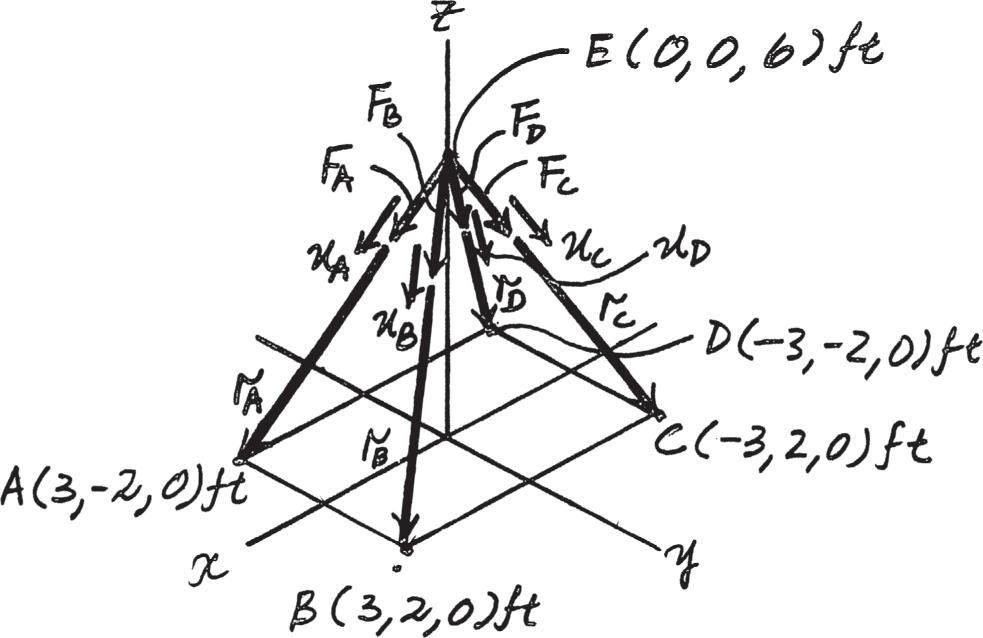
© 2016 Pearson Education, Inc., Upper Saddle River, NJ. All rights reserved. This material is protected under all copyright laws as they currently exist. No portion of this material may be reproduced, in any form or by any means, without permission in writing from the publisher.
2–105.
If the resultant of the four forces is , determine the tension developed in each cable. Due to symmetry, the tension in the four cables is the same.
SOLUTION
Force Vectors: The unit vectors uA, uB, uC and uD of FA, FB, FC and FD must be determined first. From Fig. a,
A =
A
= (3 - 0)i + ( - 2 - 0)j + (0 - 6)k 2(3 - 0)2 + ( - 2 - 0)2 + (0 - 6)2 = 3 7 i2 7 j6 7 k
u B = rB rB = (3 - 0)i + (2 - 0)j + (0 - 6)k
2(3 - 0)2 + (2 - 0)2 + (0 - 6)2 = 3 7 i
7 j6 7 k
u C = rC rC = ( - 3 - 0)i + (2 - 0)j + (0 - 6)k 2 ( - 3 - 0)2 + (2 - 0)2 + (0 - 6)2 =3 7 i + 2 7 j6 7 k
u D = rD rD = ( - 3 - 0)i + ( - 2 - 0)j + (0 - 6)k
2( - 3 - 0)2 + ( - 2 - 0)2 + (0 - 6)2 =3 7 i -
Since the magnitudes of FA, FB, FC and FD are the same and denoted as F, the four vectors or forces can be written as
6 7 k b
Resultant Force: The vector addition of FA, FB, FC and FD is equal to FR.Thus,

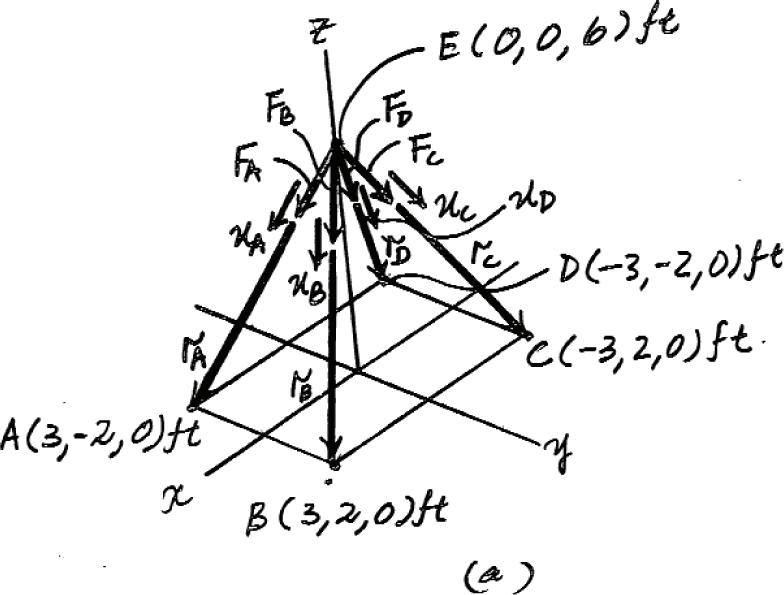
© 2016 Pearson Education, Inc., Upper Saddle River, NJ. All rights reserved. This material is protected under all copyright laws as they currently exist. No portion of this material may be reproduced, in any form or by any means, without permission in writing from the publisher.
2–106.
Express the force F in Cartesian vector form if it acts at the midpoint B of the rod.
Solution
= (4i + 6j - 4k) - ( - 1 5i + 2j - 2k) = {5.5i + 4j - 2k} m
rBD = 2(5 5)2 + (4)2 + ( - 2)2 = 7 0887 m F = 600 a rBD rBD b = 465 528i + 338 5659j - 169 2829k
= {466i + 339j - 169k} N
© 2016 Pearson Education, Inc., Upper Saddle River, NJ. All rights reserved. This material is protected under all copyright laws as they currently exist. No portion of this material may be reproduced, in any form or by any means, without permission in writing from the publisher.
2–107.
Express force F in Cartesian vector form if point B is located 3 m along the rod end C
Solution
rCA = 3i - 4j + 4k
rCA = 6.403124
rCB = 3 6 403124 (rCA) = 1 4056i - 1 8741j + 1 8741k
rOB = rOC + rCB = - 3i + 4j + rCB = - 1.59444i + 2.1259j + 1.874085k
rOD = rOB + rBD
rBD = rOD - rOB = (4i + 6j) - rOB = 5 5944i + 3 8741j - 1 874085k
rBD = 2(5 5914)2 + (3 8741)2 + ( - 1 874085)2 = 7 0582
F = 600 a rBD rBD b = 475.568i + 329.326j - 159.311k
F = {476i + 329j - 159k} N
Ans.
Ans: F = {476i + 329j - 159k} N
© 2016 Pearson Education, Inc., Upper Saddle River, NJ. All rights reserved. This material is protected under all copyright laws as they currently exist. No portion of this material may be reproduced, in any form or by any means, without permission in writing from the publisher.
*2–108.
The chandelier is supported by three chains which are concurrent at point O If the force in each chain has a magnitude of 60 lb, express each force as a Cartesian vector and determine the magnitude and coordinate direction angles of the resultant force.
SOLUTION
FA = 60 (4 cos 30° i - 4 sin 30° j - 6 k) 2(4 cos 30°)2 + ( - 4 sin 30°)2 + ( - 6)2
= {28.8 i - 16.6 j - 49.9 k}lb
FB = 60 ( - 4 cos 30° i - 4 sin 30° j - 6k)
2( - 4 cos 30°)2 + ( - 4 sin 30°)2 + ( - 6)2
= { - 28.8 i - 16.6 j - 49.9 k}lb
FC = 60 (4 j - 6 k)
2(4)2 + ( - 6)2
= {33.3 j - 49.9 k}lb
g = 180° b = 90° a = 90° FR = 150 lb FR = FA + FB + FC = { - 149.8 k}lb
Ans. Ans. Ans. Ans. Ans. Ans. Ans.


a = 90°
b = 90°
g = 180°
© 2016 Pearson Education, Inc., Upper Saddle River, NJ. All rights reserved. This material is protected under all copyright laws as they currently exist. No portion of this material may be reproduced, in any form or by any means, without permission in writing from the publisher.
2–109.
The chandelier is supported by three chains which are concurrent at point O If the resultant force at O has a magnitude of 130 lb and is directed along the negative z axis, determine the force in each chain.
SOLUTION
FC = F (4 j - 6 k) 2 4 2 + ( - 6)2 = 0.5547 Fj - 0.8321 Fk
FA = FB = FC
FRz =© Fz; 130 = 3(0.8321F)
F = 52.1 lb


2016 Pearson Education, Inc., Upper Saddle River, NJ. All rights reserved. This material is protected under all copyright laws as they currently exist. No portion of this material may be reproduced, in any form or by any means, without permission in writing from the publisher.
2–110.
The window is held open by chain AB. Determine the length of the chain, and express the 50-lb force acting at A along the chain as a Cartesian vector and determine its coordinate direction angles
SOLUTION
Unit Vector: The coordinates of point A are
Force Vector: Ans.
Coordinate Direction Angles: From the unit vector obtained above, we have Ans. Ans. Ans.


© 2016 Pearson Education, Inc., Upper Saddle River, NJ. All rights reserved. This material is protected under all copyright laws as they currently exist. No portion of this material may be reproduced, in any form or by any means, without permission in writing from the publisher.
2–111.
The window is held open by cable AB Determine the length of the cable and express the 30-N force acting at A along the cable as a Cartesian vector
SOLUTION
= 2( - 259.81)2 + ( - 350)2 + (400)2 = 591.61
© 2016 Pearson Education, Inc., Upper Saddle River, NJ. All rights reserved. This material is protected under all copyright laws as they currently exist. No portion of this material may be reproduced, in any form or by any means, without permission in writing from the publisher.
*2–112.
Given the three vectors A, B, and D, show that
A # (B + D) = (A # B) + (A # D)
SOLUTION
Since the component of is equal to the sum of the components of B and D, then (QED) Also,
A # (B + D) = (A x i + A y j + A zk) # [(Bx + Dx)i + (By + Dy)j + (Bz + Dz)k] A (B + D) = A B + A D (B + D)
(QED) = (A B) + (A D) = (A xBx + A yBy + A zBz) + (A xDx + A yDy + A zDz) = A x (Bx + Dx) + A y (By + Dy) + A z (Bz + Dz)
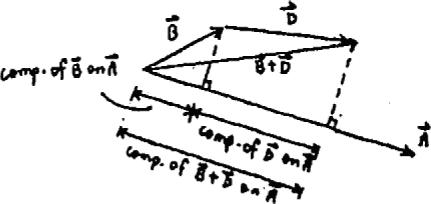
© 2016 Pearson Education, Inc., Upper Saddle River, NJ. All rights reserved. This material is protected under all copyright laws as they currently exist. No portion of this material may be reproduced, in any form or by any means, without permission in writing from the publisher.
2–113.
F = 600 N
Determine the magnitudes of the components of acting along and perpendicular to segment DE of the pipe assembly
SOLUTION
Unit Vectors: The unit vectors uEB and uED must be determined first. From Fig. a,
u EB = rEB rEB = (0 - 4)i + (2 - 5)j + [0 - ( - 2)]k 2(0 - 4)2 + (2 - 5)2 + [0 - ( - 2)]2 =- 0.7428i
u ED =- j
Thus, the force vector F is given by
Vector Dot Product: The magnitude of the component of F parallel to segment DE of the pipe assembly is









The component of F perpendicular to segment DE of the pipe assembly is
Ans. (FED)per = 2F 2 - (FED)paral2 = 2 6002 - 334.252 = 498 N = 334.25 = 334 N = ( - 445.66)(0) + ( - 334.25)( - 1) + (222.83)(0) (FED)paral = F
Ans.

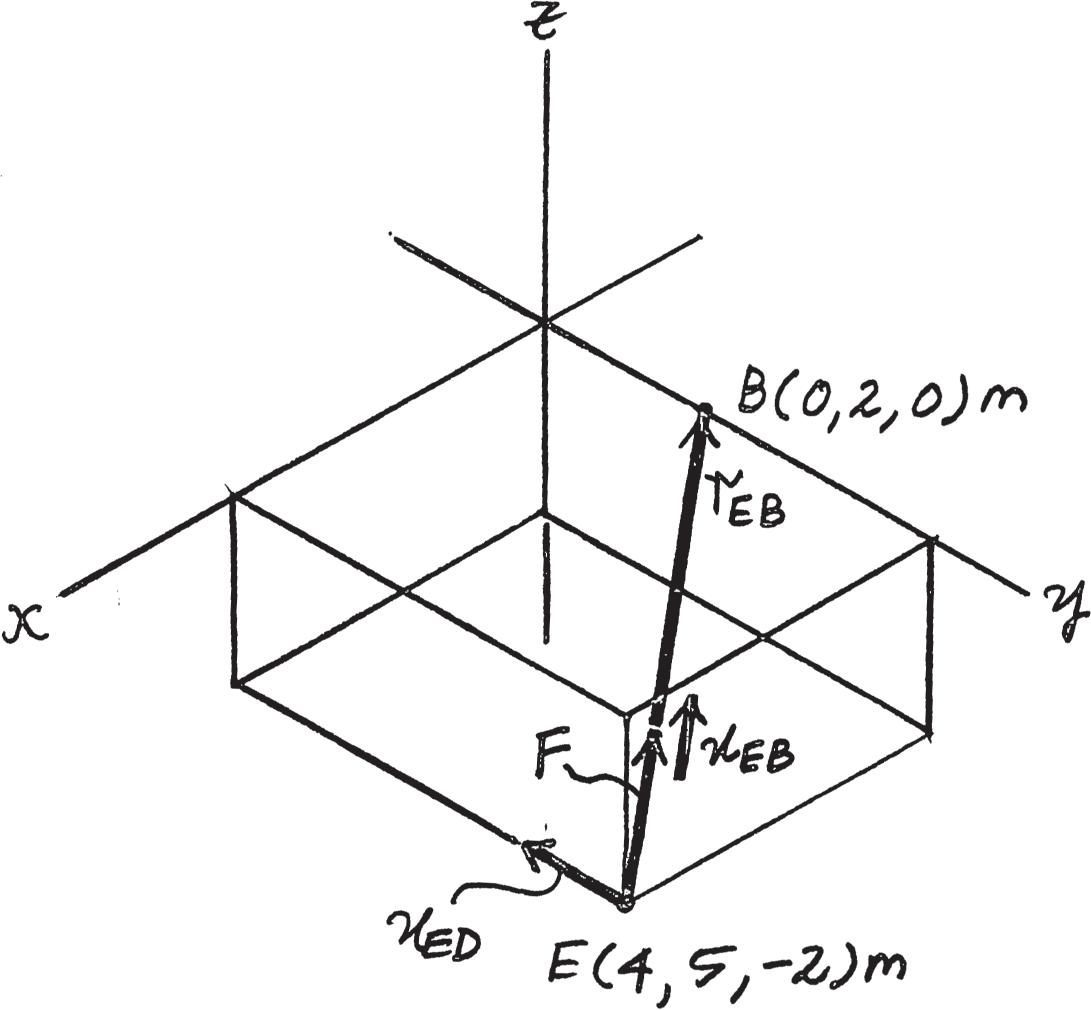


Ans: (FED) = 334 N (FED) # = 498 N
© 2016 Pearson Education, Inc., Upper Saddle River, NJ. All rights reserved. This material is protected under all copyright laws as they currently exist. No portion of this material may be reproduced, in any form or by any means, without permission in writing from the publisher.
2–114.
Determine the angle u between the two cables.
Solution
Unit Vectors. Here, the coordinates of points A, B and C are A(2, - 3, 3) m, B(0, 3, 0) and C( - 2, 3, 4) m respectively. Thus, the unit vectors along AB and AC are
u AB = (0 - 2)i + [3 - ( - 3)]j + (0 - 3)k
2(0 - 2)2 + [3 - ( - 3)]2 + (0 - 3)2 =2 7 i + 6 7 j3 7 k
u AC = ( - 2 - 2)i + [3 - ( - 3)]j + (4 - 3)k
2( - 2 - 2)2 + [3 - ( - 3)]2 + (4 - 3)2 =
The Angle U Between AB and AC. u AB # u AC = a2 7 i + 6 7 j3 7 k b # a4 2
Then
© 2016 Pearson Education, Inc., Upper Saddle River, NJ. All rights reserved. This material is protected under all copyright laws as they currently exist. No portion of this material may be reproduced, in any form or by any means, without permission in writing from the publisher.
2–115.
Determine the magnitude of the projection of the force F1 along cable AC
Solution
Unit Vectors. Here, the coordinates of points A, B and C are A(2, - 3, 3)m, B(0, 3, 0) and C( - 2, 3, 4) m respectively. Thus, the unit vectors along AB and AC are
u AB = (0 - 2)i + [3 - ( - 3)]j + (0 - 3)k 2(0 - 2)2 + [3 - ( - 3)]2 + (0 - 3)2 =2 7 i + 6 7 j3 7 k
u AC = ( - 2 - 2)i + [3 - ( - 3)]j + (4 - 3)k 2( - 2 - 2)2 + [3 - ( - 3)]2 + (4 - 3)2 =4 2
Force Vector, For F1, F1 = F1 u AB = 70 a2 7 i + 6 7 j3 7 k b = { - 20i + 60j - 30k} N
Projected Component of F1. Along AC, it is (
= ( - 20)a4 2
= 56 32 N = 56 3 N
Ans.
The positive sign indicates that this component points in the same direction as u AC
© 2016 Pearson Education, Inc., Upper Saddle River, NJ. All rights reserved. This material is protected under all copyright laws as they currently exist. No portion of this material may be reproduced, in any form or by any means, without permission in writing from the publisher.
*2–116.
Determine the angle between the y axis of the pole and the wire AB u
SOLUTION
Position Vector:
The magnitudes of the position vectors are
The Angles Between Two Vectors The dot product of two vectors must be determined first.
Then,
© 2016 Pearson Education, Inc., Upper Saddle River, NJ. All rights reserved. This material is protected under all copyright laws as they currently exist. No portion of this material may be reproduced, in any form or by any means, without permission in writing from the publisher.
2–117.
Determine the magnitudes of the projected components of the force F = [60i + 12j - 40k] N along the cables AB and AC.
Solution
F = {60 i + 12 j - 40 k} N
u AB = - 3 i - 0 75 j + 1 k
1( - 3)2 + ( - 0.75)2 + (1)2
= - 0 9231 i - 0 2308 j + 0 3077 k
u AC = - 3 i + 1 j + 1.5 k
1( - 3)2 + (1)2 + (1 5)2
= - 0.8571 i + 0.2857 j + 0.4286 k
Proj FAB = F # u AB = (60)( - 0 9231) + (12)( - 0 2308) + ( - 40)(0 3077)
= - 70 46 N
|Proj FAB| = 70 5 N
Proj FAC = F # u AC = (60)( - 0.8571) + (12)(0.2857) + ( - 40)(0.4286)
= - 65 14 N
|Proj FAC| = 65 1 N
Ans.
Ans. Ans: |Proj FAB| = 70 5 N |Proj FAC| = 65 1 N
© 2016 Pearson Education, Inc., Upper Saddle River, NJ. All rights reserved. This material is protected under all copyright laws as they currently exist. No portion of this material may be reproduced, in any form or by any means, without permission in writing from the publisher.
2–118.
Determine the angle u between cables AB and AC
Solution
rAB = { - 3 i - 0 75 j + 1 k} m
rAB = 2( - 3)2 + ( - 0.75)2 + (1)2 = 3.25 m
rAC = { - 3 i + 1 j + 1 5 k} m
rAC = 2( - 3)2 + (1)2 + (1 5)2 = 3 50 m
rAB # rAC = ( - 3)( - 3) + ( - 0 75)(1) + (1)(1 5) = 9 75
u = cos - 1 a rAB # rAC rAB rAC b = cos - 1 a 9.75 (3.25)(3.50) b
u = 31 0° Ans.
© 2016 Pearson Education, Inc., Upper Saddle River, NJ. All rights reserved. This material is protected under all copyright laws as they currently exist. No portion of this material may be reproduced, in any form or by any means, without permission in writing from the publisher.
2–119.
A force of lb acts at the end of the pipe D etermine the magnitudes of the components and which are directed along the pipe’s axis and perpendicular to it.
SOLUTION
© 2016 Pearson Education, Inc., Upper Saddle River, NJ. All rights reserved. This material is protected under all copyright laws as they currently exist. No portion of this material may be reproduced, in any form or by any means, without permission in writing from the publisher.
*2–120.
Two cables exert forces on the pipe. Determine the magnitude of the projected component of along the line of action of F2 F1
SOLUTION
Force Vector:
Unit Vector: One can obtain the angle for using Eq. 2–8. ,with and .The unit vector along the line of action of is
Projected Component of Along the Line of Action of :
Negative sign indicates that the projected component of acts in the opposite sense of direction to that of
The magnitude is Ans.
© 2016 Pearson Education, Inc., Upper Saddle River, NJ. All rights reserved. This material is protected under all copyright laws as they currently exist. No portion of this material may be reproduced, in any form or by any means, without permission in writing from the publisher.
2–121.
Determine the angle between the two cables attached to the pipe u SOLUTION
Unit Vectors:
The Angles Between Two Vectors :
0.1812 = 0.4330( - 0.7071) + 0.75(0.5) + ( - 0.5)(0.5) u F1 # u F2 = (0.4330i + 0.75j - 0.5k) # ( - 0.7071i + 0.5j + 0.5k) u
Then,
© 2016 Pearson Education, Inc., Upper Saddle River, NJ. All rights reserved. This material is protected under all copyright laws as they currently exist. No portion of this material may be reproduced, in any form or by any means, without permission in writing from the publisher.
2–122.
Determine the angle u between the cables AB and AC.
Solution
Unit Vectors. Here, the coordinates of points A, B and C are A(6, 0, 0) m, B(0, - 1, 2) m and C(0, 1, 3) respectively. Thus, the unit vectors along AB and AC are
u AB = (0 - 6)i + ( - 1 - 0)j + (2 - 0)k
2(0 - 6)2 + ( - 1 - 0)2 + (2 - 0)2 = -
u AC = (0 - 6)i + (1 - 0)j + (3 - 0)k 2(0 - 6)2 + (1 - 0)2 + (3 - 0)2
The Angle u Between AB and AC.
2–123.
Determine the magnitude of the projected component of the force F = {400i - 200j + 500k} N acting along the cable BA
Solution
Unit Vector. Here, the coordinates of points A and B are A(6, 0, 0) m and B(0, - 1, 2) m respectively. Thus the unit vector along BA is
u BA = rBA rBA = (6 - 0)i + [0 - ( - 1)]j + (0 - 2)k 2(6 - 0)2 + [0 - ( - 1)]2 + (0 - 2)2 = 6 2
Projected component of F. Along BA, it is
= 187 41 N = 187 N
Ans.
The positive sign indicates that this component points in the same direction as u BA .
© 2016 Pearson Education, Inc., Upper Saddle River, NJ. All rights reserved. This material is protected under all copyright laws as they currently exist. No portion of this material may be reproduced, in any form or by any means, without permission in writing from the publisher. Ans:
© 2016 Pearson Education, Inc., Upper Saddle River, NJ. All rights reserved. This material is protected under all copyright laws as they currently exist. No portion of this material may be reproduced, in any form or by any means, without permission in writing from the publisher.
*2–124.
Determine the magnitude of the projected component of the force F = {400i - 200j + 500k} N acting along the cable CA
Solution
Unit Vector. Here, the coordinates of points A and C are A(6, 0, 0) m and C(0, 1, 3) m respectively. Thus, the unit vector along CA is
u CA = rCA rCA = (6 - 0)i + (0 - 1)j + (0 - 3)k 2(6 - 0)2 + (0 - 1)2 + (0 - 3)2 = 6 246 i -
Projected component of F. Along CA, it is
= 162.19 N = 162 N
Ans.
The positive sign indicates that this component points in the same direction as u CA .
© 2016 Pearson Education, Inc., Upper Saddle River, NJ. All rights reserved. This material is protected under all copyright laws as they currently exist. No portion of this material may be reproduced, in any form or by any means, without permission in writing from the publisher.
2–125.
Determine the magnitude of the projection of force along the axis. u F = 600 N
SOLUTION
Unit Vectors: The unit vectors and must be determined first.From Fig. a,
uu = sin30°i + cos30°j
Thus, the force vectors is given by
Vector Dot Product: The magnitude of the projected component of along the axis is
= 246 N = ( - 200)(sin30°) + 400(cos 30°) + 400(0)


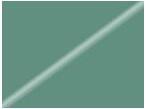


© 2016 Pearson Education, Inc., Upper Saddle River, NJ. All rights reserved. This material is protected under all copyright laws as they currently exist. No portion of this material may be reproduced, in any form or by any means, without permission in writing from the publisher.
2–126.
Determine the magnitude of the projected component of the 100-lb force acting along the axis BC of the pipe.
g r BC = 56i ^ + 4j ^ - 2k ^ 6 ft
F r = 100 5 - 6i ^ + 8j ^ + 2k ^ 6 2( - 6)2 + 82 + 22 = 5 - 58.83i ^ + 78.45j ^ + 19.61k ^ 6 lb
© 2016 Pearson Education, Inc., Upper Saddle River, NJ. All rights reserved. This material is protected under all copyright laws as they currently exist. No portion of this material may be reproduced, in any form or by any means, without permission in writing from the publisher.
2–127.
Determine the angle u between pipe segments BA and BC
Solution
g r BC = 56i ^ + 4j ^ - 2k ^ 6 ft
© 2016 Pearson Education, Inc., Upper Saddle River, NJ. All rights reserved. This material is protected under all copyright laws as they currently exist. No portion of this material may be reproduced, in any form or by any means, without permission in writing from the publisher.
*2–128.
Determine the angle u between BA and BC
Solution
Unit Vectors. Here, the coordinates of points A, B and C are A(0, - 2, 0) m, B(0, 0, 0) m and C(3, 4, - 1) m respectively. Thus, the unit vectors along BA and BC are u BA = - j u BE = (3 - 0) i + (4 - 0) j + ( - 1 - 0) k 2(3 - 0)2 + (4 - 0)2 + ( - 1 - 0)2 =
The Angle U Between BA and BC.
Then
© 2016 Pearson Education, Inc., Upper Saddle River, NJ. All rights reserved. This material is protected under all copyright laws as they currently exist. No portion of this material may be reproduced, in any form or by any means, without permission in writing from the publisher.
2–129.
Determine the magnitude of the projected component of the 3 kN force acting along the axis BC of the pipe.
Solution
Unit Vectors. Here, the coordinates of points B, C and D are B (0, 0, 0) m, C(3, 4, - 1) m and D(8, 0, 0) Thus the unit vectors along BC and CD are
u BC = (3 - 0) i + (4 - 0) j + ( - 1 - 0) k
2(3 - 0)2 + (4 - 0)2 + ( - 1 - 0)2 = 3
u CD = (8 - 3) i + (0 - 4) j + [0 - ( - 1)] k
2(8 - 3)2 + (0 - 4)2 + [0 - (
Force Vector. For F,
Projected Component of F. Along BC, it is
=6 21092 = - 0 1816 kN = 0 182 kN
k
Ans.
The negative signs indicate that this component points in the direction opposite to that of uBC.
© 2016 Pearson Education, Inc., Upper Saddle River, NJ. All rights reserved. This material is protected under all copyright laws as they currently exist. No portion of this material may be reproduced, in any form or by any means, without permission in writing from the publisher.
2–130.
Determine the angles and made between the axes OA of the flag pole and AB and AC, respectively, of each cable
SOLUTION
rAC = { - 2i - 4j + 1k}m; rAC = 4.58 m
rAB = {1.5i - 4j + 3k}m; rAB = 5.22 m
rAO = { - 4j - 3k}m; rAO = 5.00 m
rAB # rAO = (1.5)(0) + ( - 4)( - 4) + (3)( - 3) = 7
u = cos - 1 ¢ rAB # rAO rAB rAO ≤
rAC # rAO = ( - 2) (0) + ( - 4)( - 4) + (1)( - 3) = 13 = cos - 1 ¢ 7 5.22(5.00) ≤ = 74.4°
f = cos - 1 a rAC # rAO rAC rAO b
Ans.
Ans. = cos - 1 a 13 4.58(5.00) b = 55.4°
© 2016 Pearson Education, Inc., Upper Saddle River, NJ. All rights reserved. This material is protected under all copyright laws as they currently exist. No portion of this material may be reproduced, in any form or by any means, without permission in writing from the publisher.
2–131.
Determine the magnitudes of the components of acting along and perpendicular to segment BC of the pipe assembly F
SOLUTION
Unit Vector: The unit vector must be determined first.From Fig. a



Vector Dot Product: The magnitude of the projected component of parallel to segment BC of the pipe assembly is
Ans.
The magnitude of is .Thus, the magnitude of the component of perpendicular to segment BC of the pipe assembly can be determined from Ans.


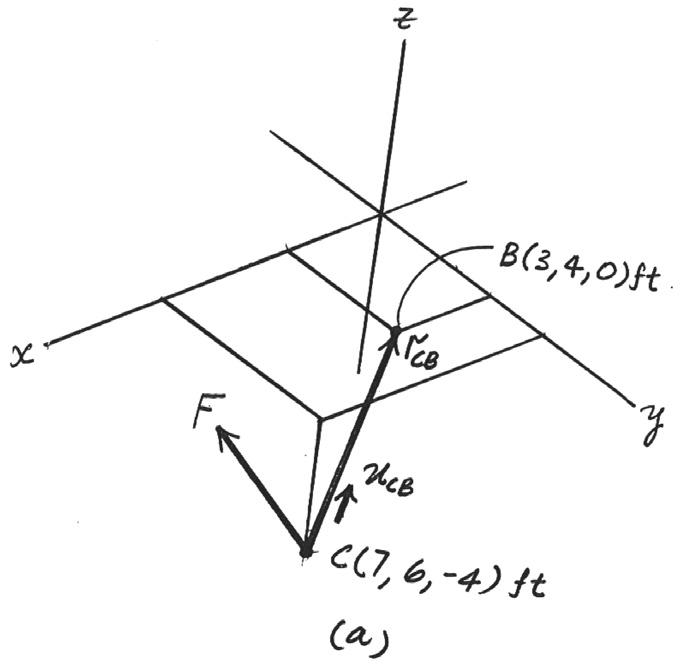
© 2016 Pearson Education, Inc., Upper Saddle River, NJ. All rights reserved. This material is protected under all copyright laws as they currently exist. No portion of this material may be reproduced, in any form or by any means, without permission in writing from the publisher.
*2–132.
Determine the magnitude of the projected component of along AC.Express this component as a Cartesian vector F
SOLUTION
Unit Vector: The unit vector must be determined first.From Fig. a
uAC = (7 - 0)i + (6 - 0)j + ( - 4 - 0)k 3(7 - 0)2 + (6 - 0)2 + ( - 4 - 0)2 = 0.6965 i + 0.5970 j - 0.3980 k
Vector Dot Product: The magnitude of the projected component of along line AC is





Thus,expressed in Cartesian vector form is
Ans. = { - 18.0i - 15.4j + 10.3k} lb FAC = FAC uAC =- 25.87(0.6965i + 0.5970j - 0.3980k) FAC = 25.87 lb = (30)(0.6965) + ( - 45)(0.5970) + 50( - 0.3980)
Ans.
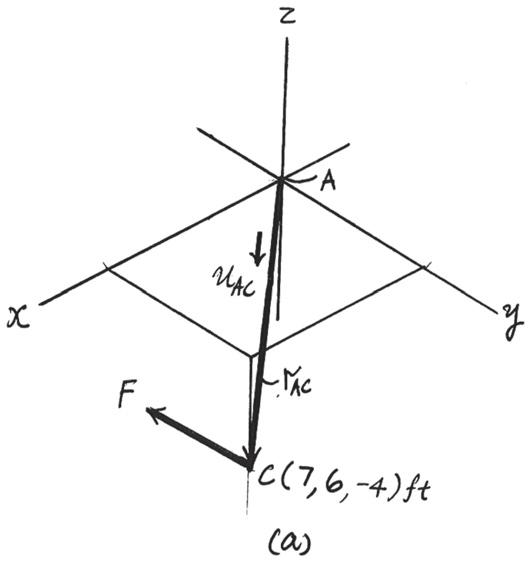
© 2016 Pearson Education, Inc., Upper Saddle River, NJ. All rights reserved. This material is protected under all copyright laws as they currently exist. No portion of this material may be reproduced, in any form or by any means, without permission in writing from the publisher.
2–133.
Determine the angle between the pipe segments BA and BC. u
SOLUTION
Position Vectors: The position vectors and must be determined first.From Fig. a, The magnitude of and are
BC rBA rBC = (7 - 3)i + (6 - 4)j + (- 4 - 0)k = {4i + 2j - 4k} ft rBA = (0 - 3)i + (0 - 4)j + (0 - 0)k = { - 3i - 4j} ft
rBA = 3( - 3)2 + ( - 4)2 = 5 ft
rBC = 342 + 22 + (- 4)2 = 6 ft
Vector Dot Product:
rBA # rBC = (- 3i - 4j) # (4i + 2j - 4k)
b = cos - 1 c - 20 5(6) d = 132° =- 20 ft2 = (- 3)(4) + ( - 4)(2) + 0( - 4)




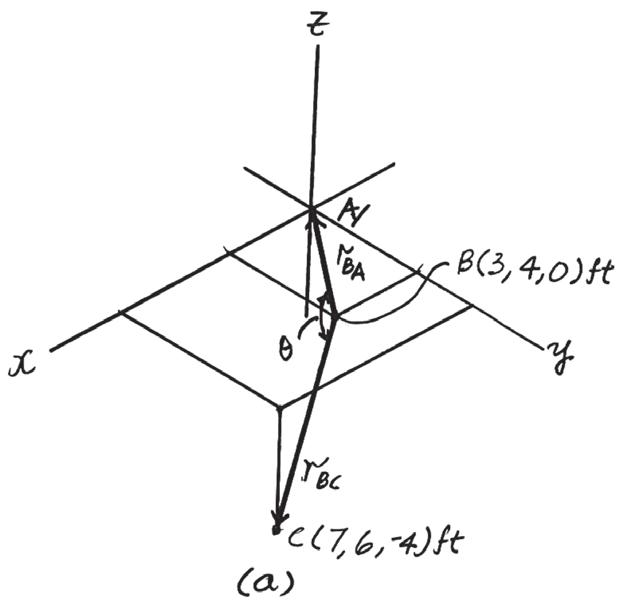
© 2016 Pearson Education, Inc., Upper Saddle River, NJ. All rights reserved. This material is protected under all copyright laws as they currently exist. No portion of this material may be reproduced, in any form or by any means, without permission in writing from the publisher.
2–134.
If the force F = 100 N lies in the plane DBEC, which is parallel to the x–z plane, and makes an angle of 10 ° with the extended line DB as shown, determine the angle that F makes with the diagonal AB of the crate.
Solution
Use the x, y, z axes.
u AB = a - 0.5i + 0.2j + 0.2k 0.57446 b
= - 0.8704i + 0.3482j + 0.3482k
F = - 100 cos 10°i + 100 sin 10°k
u = cos - 1a F # u AB F uAB b
= cos - 1 a - 100 (cos 10°) ( - 0.8704) + 0 + 100 sin 10° (0.3482) 100(1) b
= cos - 1 (0.9176) = 23.4° Ans.

© 2016 Pearson Education, Inc., Upper Saddle River, NJ. All rights reserved. This material is protected under all copyright laws as they currently exist. No portion of this material may be reproduced, in any form or by any means, without permission in writing from the publisher.
2–135.
Determine the magnitudes of the components of force acting parallel and perpendicular to dia gonal AB of the crate F = 90 lb
SOLUTION
Force and Unit Vector: The force vector and unit vector must be determined first.From Fig. a
Vector Dot Product: The magnitude of the projected component of parallel to the diagonal AB is Ans.
The magnitude of the component perpendicular to the diagonal AB is Ans.
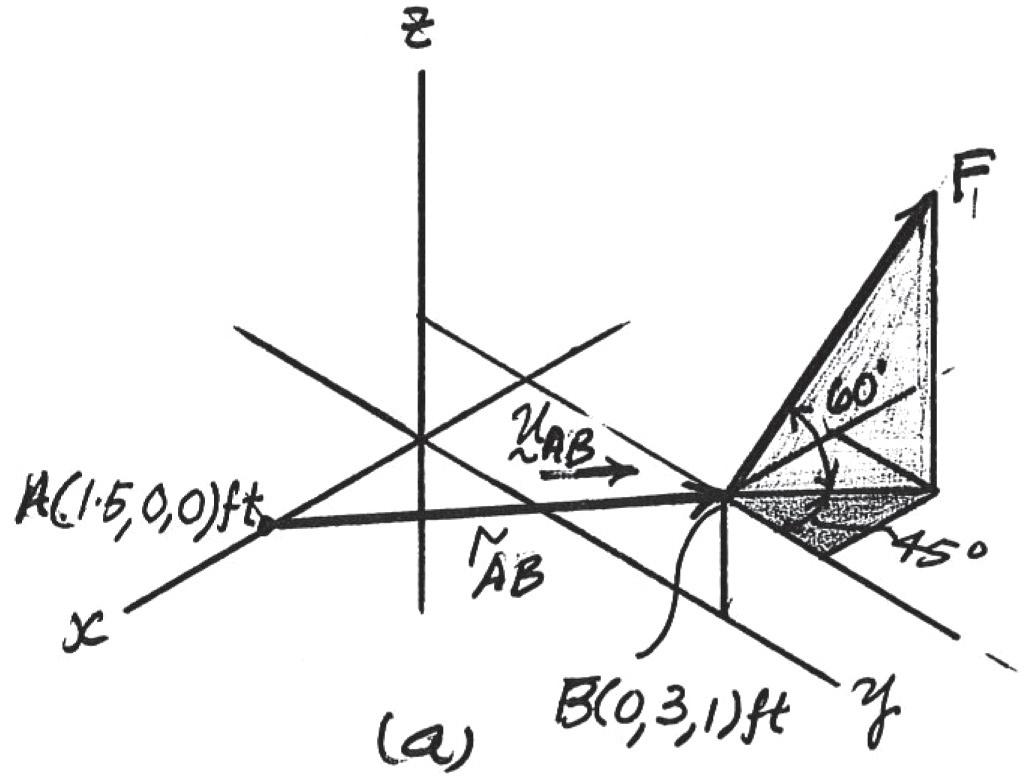
© 2016 Pearson Education, Inc., Upper Saddle River, NJ. All rights reserved. This material is protected under all copyright laws as they currently exist. No portion of this material may be reproduced, in any form or by any means, without permission in writing from the publisher.
*2–136.
Determine the magnitudes of the projected components of the force acting along the x and y axes F = 300 N
SOLUTION
Force Vector : The force vector F must be determined first. From Fig. a,
Vector Dot Product: The magnitudes of the projected component of F along the x and y axes are
+
+
N
+ 259.81(1) + 129.90(0)
The negative sign indicates that F x is directed towards the negative x axis.Thus Ans.
© 2016 Pearson Education, Inc., Upper Saddle River, NJ. All rights reserved. This material is protected under all copyright laws as they currently exist. No portion of this material may be reproduced, in any form or by any means, without permission in writing from the publisher.
2–137.
Determine the magnitude of the projected component of the force acting along line OA F = 300 N
SOLUTION
Force and Unit Vector : The force vector F and unit vector uOA must be determined first. From Fig. a
= ( - 0.45 - 0)i + (0.3 - 0)j + (0.2598 - 0)k 2( - 0.45 - 0)2 + (0.3 - 0)2 + (0.2598 - 0)2 =- 0.75i + 0.5j + 0.4330k = { - 75i + 259.81j + 129.90k} N
Vector Dot Product: The magnitude of the projected component of F along line OA is Ans. = 242 N = ( - 75)( - 0.75) + 259.81(0.5) + 129.90(0.4330)
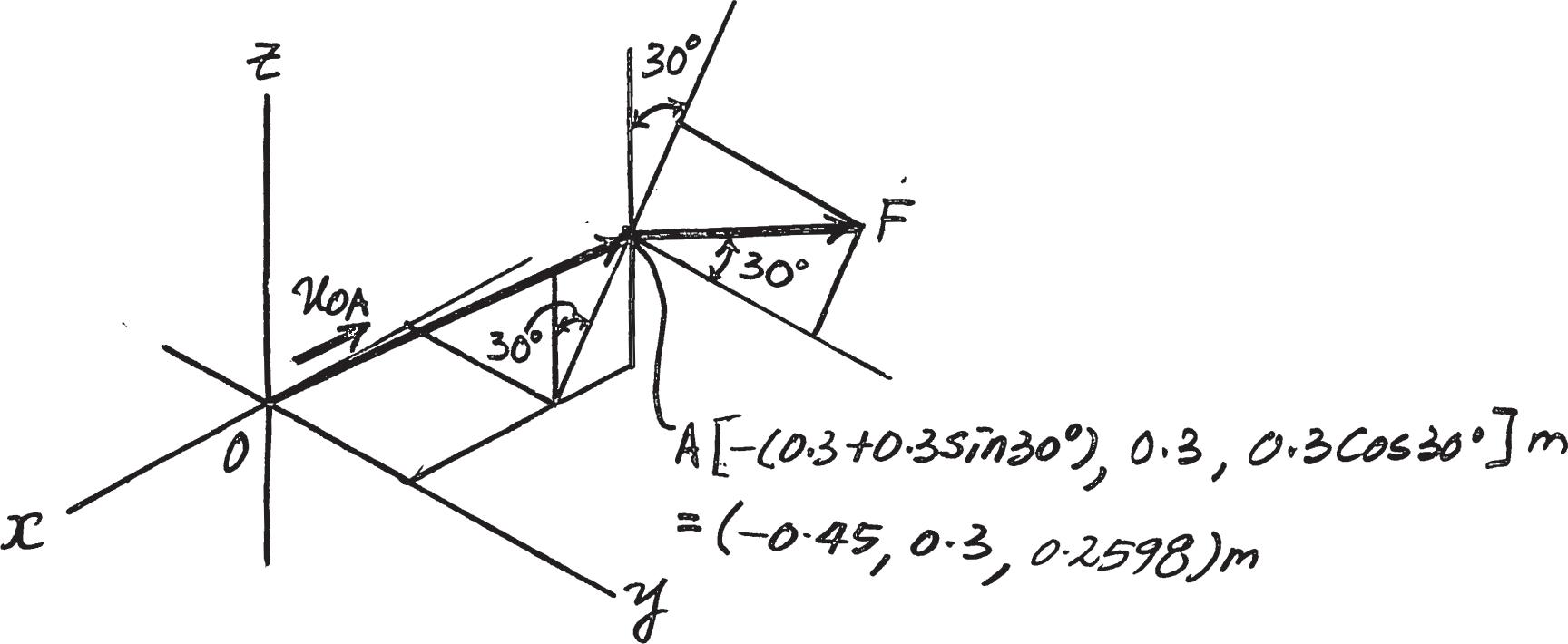
© 2016 Pearson Education, Inc., Upper Saddle River, NJ. All rights reserved. This material is protected under all copyright laws as they currently exist. No portion of this material may be reproduced, in any form or by any means, without permission in writing from the publisher.
2–138.
Determine the angle u between the two cables. z
Solution
u = cos - 1 a rAC # rAB rAC rAB b = cos - 1 c (2 i - 8 j + 10 k) # ( - 6 i + 2 j + 4 k) 122 + ( - 8)2 + 102 1( - 6)2 + 22 + 42 d = cos - 1 a 12 96.99 b
u = 82 9° Ans.
© 2016 Pearson Education, Inc., Upper Saddle River, NJ. All rights reserved. This material is protected under all copyright laws as they currently exist. No portion of this material may be reproduced, in any form or by any means, without permission in writing from the publisher.
2–139.
Determine the projected component of the force F = 12 lb acting in the direction of cable AC. Express the result as a Cartesian vector.
Solution
rAC = {2 i - 8 j + 10 k} ft
rAB = { - 6 i + 2 j + 4 k} ft
FAB = 12 a rAB rAB b = 12 a6 7 483 i + 2 7 483 j + 4 7 483 k b
FAB = { - 9 621 i + 3 207 j + 6 414 k} lb
i
=
= 1 4846
Proj FAB = FAB u AC
Proj FAB = (1.4846) c 2 12.962 i8 12.962 j + 10 12.962 k d
Proj FAB = {0 229 i - 0 916 j + 1 15 k} lb Ans. Ans: Proj F
